Join The Cornucopia Institute as we keep you informed via web updates from the National Organic Standards Board (NOSB) meeting online.
We will be sharing the play by play of the meeting on April 29-30 and May 1 below.
For background on issues up for discussion at the meeting, see:
- The NOSB’s Proposals & Discussion Document for Spring 2024
- Cornucopia’s oral comments
- Cornucopia’s notes on the oral comments for the Spring 2024 NOSB meeting
- Additional information on this meeting and past meetings dating back to 2012
APRIL 29, 2024: Day 1 of the SPring 2024 NOSB Meeting
Call to Order made by NOP staff along with some welcoming remarks. Secretary Randy Romanski is then introduced to give some welcoming remarks.
Secretary Randy Romanski – WI Dept of Agriculture, Trade and Consumer Protection (DATCP)
Career public servant in WI. WI are known as America’s dairy land. Take advantage of sampling food in the area. Wisconsin – 104.8 billion dollar industry. Produce about 50% of U.S’s specialty cheese. Also export a lot of it. Top 5 producers of many commodities. Number 2 organic state in the U.S. According to 2021 Certified Organic Bulletin, from NASS, we have 250,000 certified organic farmland. First in certified organic cranberry production. Produce 23% of organic goat milk. AG of all types is important part of state’s economy. Share your stories as people get more and more removed from the farm. Important to know where food comes from. As agency, we are resource to the industry from farm gate to dinner plate. Provide regulatory and resource component. The process works best when everyone working together. Through organic cost share, advisory counsel and grant programs we connect public with consumption of organic products. Advocate for comprehensive farm bill. WI, like other states, have consistently been advocating to get a farm bill done and that it is well-funded. Head of state agency and times when ask legislature for resources. Partners at USDA need resources to make the connection. Also need to make sure we keep feeding programs, investing in research, a lot that needs to be done in Farm Bill. Fortunate to work for the governor who understands and invests in agriculture. He has consistently supported all levels of ag – all types, all sizes. Through his leadership we have increased investments. Important as we look forward. No matter where from or part of industry or how connect with growers, you’ve got a lot to be proud of. Feeding the world is important. Share your stories. Close on one thing – being aware of each other. Even in good times, food production is tough. Changing weather patterns, challenging markets, and volatile prices have an impact and that can be a lot. Important we are providing resources to farmers. WI Farm Center has been that partner. Provide a variety of resources. Added new programs that tend to end with b/c know other states have them and that’s farmer mental health and wellness programs. Farmers should have a resource or place they can go – if struggling with hardships, depression, we have a 24/7 hotline. Encourage people to share the number. 888-901-2558. Many states have similar programs, it’s important resource our agency makes available. Thank you.
Agenda Overview
The agenda can be found here.
Introductions
Jenny Tucker does NOP staff introductions (passing out candy to people!). Tucker thanks the staff for their work prepping for the NOSB meeting.
You can find more on resources to contact and see the current NOP staffers here.
NOSB Introductions
Kyla Smith (Board Chair) introduces the NOSB members and has them give a short background about their work on the NOSB. You can find a current list of NOSB members here: https://www.ams.usda.gov/rules-regulations/organic/nosb/current-members
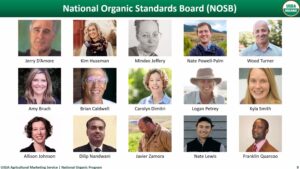
Amy Bruch and Logan Petrey joining via Zoom.
Kim Hussman: Handler’s Seat. Superior Senior. 5th year on Board. Background on poultry feeding and organic oilseed crush and oils and protein products.
Nate Powell-Palm: Sits in producer seat. Is a beef/cattle producer from MT.
Dulip Nandwani: Completed 2 years on Board and serves on scientist seat.
Franklin Quarcoo: Environmental resource conservation seat; work at Tuskegee Univ
Nate Lewis: WA farmland trust; chair policy dev subcommittee and secretary
Allison Johnson: Public interest seat; attorney for Natural Resource Council; Oakland, CA
Brian Caldwell: Consumer public interest seat; retired from Cornell; researched organic farming. Certified organic fruit and nut farm. Certified since 1986.
Jerry D’Amore: Monterrey, CA. Handler seat. 51 years in food production/sales – hydroponic systems; resident in various countries; last 20 years devoted to go-to market side
Carolyn Dimitri: Consumer/public interest seat.
Wood Turner: Environmental designer and planner; last year on board; produce organic blueberries; also planning to transition NC farm to organic
Mindee Jeffery: Retailer seat. Background in compost!
Amy Bruch: Farmer seat. Serve as vice chair an chair of CACS committee. 4th year on the NOSB. About two decades of experience working in production ag and consulting farmers to transition to organic.
Logan Petrey: Farmer seat. From Southeast and in 4th year on the NOSB.
Kyla Smith: Certifier seat. Certification policy advisor at PCO. 4th year on NOSB.
Secretary’s report
Nate Lewis (Sectretary): Any corrections on draft report? Meeting minutes accepted.
NOSB Report
Kyla Smith: [Describes her background and why she is dedicated to NOSB work, including her experiences at the certifier PCO. One difference to working for PCO is being in the public eye. Asks that we work hard to stay engaged in rulemaking process. Notes that the NOSB has a call for NOSB member nominations – people can reach out to NOSB members to ask about the time commitment. Also notes that we will be having in-person public comments this afternoon (which hasn’t been done in many years.]
Amy Bruch: [Welcomes everyone and gives comments and introductions asking that essential positions are filled in the NOSB (and the NOP).]
USDA/AMS/National Organic Program Update
Jenny Tucker: Introduces Erin Healy (Standards Dir) who will give overview of retailer toolkit. There is an ongoing need to educate people about what organic means. Congratulates on the work done to create the rules and educational materials.
Erin Healy: The label landscape has become confusing for consumers. For someone who doesn’t work in industry, it’s very confusing. Distrust among consumers. Don’t know which label to trust. Looked at consumer research, particularly around organic label. Four people worked on this – recognizes individuals. Worked with Consumer Reports and they did a phone survey of 2000 people to ask about organic label. Turns out only 55% knew organic food is produced without chemicals and only 40% knew organic inspected regularly. (See slide). OTA has come out with consumer attitude report and some numbers are higher, but these numbers show we have work to educate consumers about what this means and why organic is special. Almost 50% didn’t know seal is a government backed label. OTA released findings and better than consumer report – 70% understood products produced without chemicals and antibiotics. Heard through multiple meetings that there is a need to educate consumers. Put together tool kit for retailers. End audience is consumers. If working with retailers or organic brands, helpful.
The toolkit is a variety of graphics that can be printed and used in retail locations or social media (by brands). All of the materials focus on the 4 pillars of organic: protected by law, inspected by experts, traced from farm to store, shaped by public input.
Protected by law: Only gov’t backed label on the shelf. Backed by federal regulations; can levy fines and penalties and put people in jail. The seal is now trademarked; can take enforcement action if anyone is fraudulently using the seal.
Inspected by experts: Infers the unannounced inspections and testing that happens. Used “experts” because we were trying to use plain language for regular consumers. We didn’t want to use words only this community is familiar with.
Traced from farm to store: Refers to the SOE, which gives us the authority to audit the entire organic supply chain at this point.
Shaped by public input: Wanted to talk about our public-private partnership. Twice a year we hold a public meeting, and anyone can make a comment. And when we write our proposed regulations, anyone can make a comment, and we read through every comment.
Some examples on the table outside that you are welcome to take – freezer cling, aisle banners, banners that can be hung from ceiling or above organic produce stand, shelf tags that can be used to highlight different types of food. Used rule of three – didn’t think anyone would remember more than three bullet points. These aren’t going to be perfect, and I’ve heard some input about how we could have done them differently. Big picture and high level to be understood by consumers.
Here is the toolkit which can be used freely by retailers and others to educate about the facts of the Certified Organic program: https://www.ams.usda.gov/sites/default/files/media/NOPRetailerToolkit.pdf
We need brand ambassadors – we need people to speak highly with the organic label. Please tell people about this toolkit. Let people know we want to see this in stores and help organic producers earn more money.
Many graphics also include a QR code that links to the Understanding the Organic Basics webpage where consumers can learn more about the NOP and the organic.
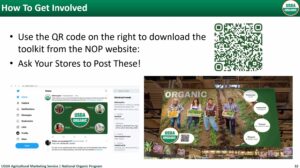

QUESTIONS from the NOSB:
JD: The document that you refer to – USDA organic as administered or sponsored by the OTA – is an extraordinary document. I’ve been around for a long time, and in my 7 years of running Driscoll’s marketing, I had not seen anything that was as heavily persuasive. I do not know why everyone didn’t go out and do a victory lap when that came out. Our biggest problems as an organic group are that we do not talk a common language, and we do not celebrate the same victories.
EH: Stores can insert own branding. Might see this in slightly different varieties. Want consumers to keep hearing about the 4 pillars and QR code to go to website.
NATE POWELL-PALM: When we encourage farmers to participate in this process, often we say that you might not see it, but your voice does matter. In spring 2022, we started hearing more from producers saying that we need to brag a little. I think this was one of the most satisfying opportunities for the Program to hear the community and act so rapidly. We had farmers saying thank you, and I want to thank you, too, Jenny.
KYLA SMITH: Landed differently for me, but then to touch and pick things up – this is great.
JD: How we collectively look at seal along with 20 other pieces of paper – a lot of info in that too.
WT: Drafting off what Jerry was saying about the numbers; what do you think success looks like in this Program, and how is the Program going to measure this over time? Is it retailer adoption, or what does that look like?
EH: I would be elated if see this in a store one day. It starts somewhere. Mom’s has already said they want to pilot test it. Having conversation with Target, Walmart, Sprouts and they are talking about it internally. We want to keep track of how many companies and how many stores within companies are using this. Also tracking online hits. Run a monthly report on that. Most important is getting the message into stores and have them use it continuously over time. Was in Whole Foods, saw TVs, and talking to them as well. Need everyone’s heLogan Petrey to connect with retailers.
AB: Thank you for working on this. Incredible. We have such a good story to tell. Organic program fires on many different cylinders, and to create such a succinct, digestible message is great.
Jenny Tucker: [Continues with NOP update.]
First, welcome to our organic farms and businesses. 1,667 organic farmers and businesses in WI as of last Friday. I was not surprised by this number. As I was typing the number into the screen, it reminded me of the enormous responsibility that this Board has. The Board is representing not only the farms and businesses in the room, but the 35,000 organic farms and businesses around the world.
Part 1 is online in the Organic Integrity Learning Center. Robust update. The Insider that went out last week has a direct link to that presentation, and I encourage you to take a look.
Topics I will be covering in Part 2: SOE update (80% of presentation), briefly review call for nominations for NOSB (which published today), quick updated on TOPP and Transitional Production Plan, and close with an award.
SOE: We have increased the number of certified entities and requiring the use of electronic import certificates, and we have strengthened oversight of certifiers. We are including business that are new to the Organic program. We have to be more clear what “certificatres” are – two kinds now, import and operation level certificates (Are you certified organic?).
ENOPIC – Electronic NOP Import Certificate.
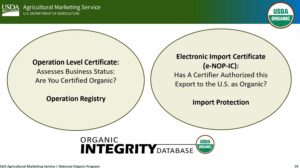
This is really the import protection side. We talk about the number of certified operations and filling gaps, and the import certificate is the absolute top.
I want to review where we are with the import cert. Left side – US importers must be certified organic and must be overseen by a certifier. This is an area where we’ve gotten a lot of push back. Why should I have to be certified if I’m only dealing with packaged products? Well, real-life example. Wine industry. We’ve gotten a lot of emails from wine importers. Why do they need to be certified to bring in sealed wine packages and then sending them off? Because it’s really important that importers help make sure these products are compliant. Within 1.5 weeks of the SOE being in effect, we started to realize that there are wines being brought into the US with sulfites in them. The EU allows sulfites, but under our agreement, we do not allow it.
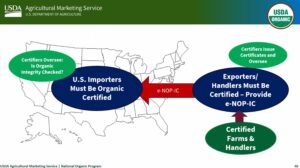
Under SOE importers are responsible for checking that. Importer needs to understand the equivalency arrangement to make sure compliant with trade arrangement. IF certifier you’re making sure organic system plan captures that check. We’ve learned that customs and borders protection – how view importers. Customs has opened our eyes to that its importers who is accountable for that product coming in. Ultimately importer is responsible for organic integrity. Having importers certified is absolutely necessary regardless of packaging. No way we can go over every box of wine, but when have that effort distributed across certifiers, then when we have conversation with EU, we put this problem at the top of the list. We need EU to be working on this not to send this product over. This is real time impact of SOE within couple of weeks. Exporters and handlers must be certified to get the electronic export certificate. We have heard from customs brokers who have denied entry b/c no evidence product was organic. Three weeks in this has happened. Certifier over exporter and handler issues the certificate. This is certifiers also under trade arrangements – EU and Canada sending the most products. Let’s keep the landscape – tremendous amount of potential. We are concerned about all things doesn’t do, but this is a strong rule and gives us a lot of tools. Let’s see the immediate wins, some will be longer term.
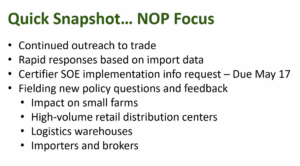
On the right side, exporters and certifiers must be certified. You must be certified to the ENOPIC. We have some certifiers who have denied entry of products because there was no evidence that the product was organic. We are three weeks in, and that’s happened. One of the complexities that we are dealing with here is that this is not only USDA certifiers. EU and Canada are the ones who are sending us the most products. I want us to all keep in mind the landscape of how all of this works. I think that SOE has great potential. I know that we can focus on all of the things that SOE cannot do, but at one month in, I’m convinced this is a strong rule that gives us a lot of tools. We have some immediate wins. A lot of the wins are going to be long term.
Send a certification request to all of our certifiers on how to manage this in a sound and sensible way so that we are not overburdening small farmers. This rule is supposed to help, not hinder.
We are also getting a lot of questions from high volume retailers. We are getting a lot questions from businesses that have not been part of this in the past.

Numbers:
- At this point, NOP has sent more than 700 letters to importers that need to get themselves certified.
To me, that is the critical path. Once those producers are certified. It is working. We’ve made a whole lot of progress.
- Almost 1,000 US Handling operations certified between January and April this year. Comparing year-to-year, that is a 3.5 fold increase. Of the 989, 640 were certified in March and April.
We have had people wait until the last minute. We’ve seen a bit of a process where people do not think they have to be certified – grieving process – but they are getting to acceptance.
- Approximately 1,800 new handling operations worldwide. That means that some of those exporters that needed to get certified are getting certified. We are filling a lot of gaps here.
We are making progress. Many of the 700 are actually in the progress of getting certified and working with a certifier. We do have folks still in denial, but we have a process to track and escalate these to ensure these folks finish certification or get out of the market. Right now, it is looking like we have a 2-6 month timeline for certifications because of the complexity.
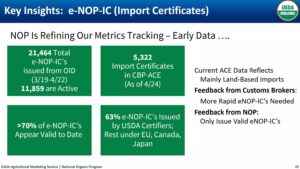
Let’s turn to the import certificate. Amount of data is enormous. We have never had access to the kind of info we have now. We can talk about the real time, the data – we have already stopped non-compliant product from entering the U.S. It is very had sometimes to communicate the presence of absence – the lack of fraudulent product. About 21,450ish total import certificates. Of those about 12000 are active (in process or in range of time allowed). There have been some where certifiers screwed up and it’s invalid or certificate has bee used. 5332 entered into the ACE system.
Again, some of how we proceed with enforcement and oversight is going to depend on the volume. We are going to have to make sound and sensible choices. We’ve never had this kind of data to look at what is coming in.
At this point, more than 70% of import certificates look valid. With something this big, I’m going to take that as a win. This data only reflects electronic import certificates. It does not represent those that might be paper based. That is an example of something that might be within that 30%. It’s not necessarily an invalid product, but it’s something that doesn’t have an import certificate in the system yet.
About 63% of import certs have been issues by US certifiers, the rest have been issued by EU and other countries. Current data in CBT are mostly land-certificates right now. Many of the active certificates may still be ship-bound, there is a delay as we have the global throughput successful. We can see that in the commodities: avocados from Mexico or berries, because they are moving across the border via land. So the timing of the certificates hitting CBT is very short. Feedback from brokers is that we need more rapid turnaround time for import certificates.
We’re taking this seriously. This is not a paper chase. If certifiers who are overseeing those exporting companies, if it is found that those products are not authentic organic, the rule allows us to hold those certifiers accountable. We do have some enforcement work ongoing against several certifiers, but because they are ongoing, I cannot talk about it. Our Enforcement website provides ongoing updates, and I encourage those who are interested to follow it.
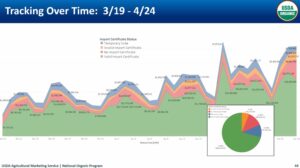
So here’s the trend over time. A look at the green are valid import certificates in the customs system. The rest of them are a mix of different certificates that we are following up on. You can see the trend line that is slowly going up. You can see when the weekend (dips) are. Can see that there are some days when green line is pretty thick and when it is more red. Examples of things not green are when someone made typo. It’s really close, but someone flipped last two numbers when entered into customs system. Also have paper certificates, and system glitches, and working way through system but a little lag time. If our system was down even for short time, there are going to be paper certificates that show up and may be lag time.
There’s also a temporary code that customs brokers are allowed to use if they do not have the permanent 21-character code for the import certificate, but they have other evidence that the product is organic. That is a temporary code that will allow them to put the product through even though they do not have the ENOPIC. Brokers are licensed and can lose their license just like our certifiers. Customs brokers have a lot to lose if they are not following our rules. We are hearing about customs brokers that are not allowing product in because they do not have evidence that it’s organic. In many ways, customs brokers are becoming our very first line of defense that are helps in ways that we cannot know. The presence of absence – we are not necessarily going to get a call every time this happens, but it’s happening. They do this every day. For them, organic is just one more piece of the puzzle. They aren’t going to risk anything. That serves us in ways that we’re not always going to be aware of.
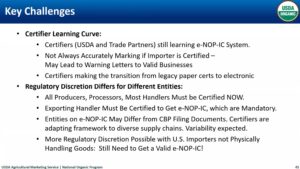
Key challenges – success so new problems. We have a certifier learning curve. Not always accurately marking in our system if the importer is certified. A few of those 700 warning levels – we got responses saying they were actually certified. Need to helps certifiers get better in OID. Certifiers making transition from legacy paper system to electronic system. Our regulatory discretion – degree to which we can support onramp into the rule – we’re trying to support legitimate trade while protecting organic integrity. Exporting handler must be certified.
I do want to note, and this is important particularly when talking to customs audience, the exporting entity, particularly on the import certifies, might be slightly different than what we might expect because of diverse variety of actors. Some variability is expected.
Even if an importer is not physically handling goods, they must be certified. Our brokers are a great line of communication for us. We do have a whole outreach community of these brokers out there who are helping us.
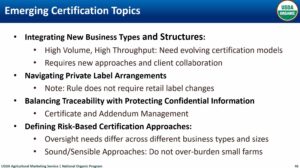
We are integrating new big players who are entering the fold. We need evolving certification models. Getting policy concerns from small farmers and large retailers. They all revolve are
How do we ensure organic integrity and also move at the speed of business? That is going to require new approaches – with small farms and big distribution warehouses. Really pleased to hear the collaboration that is happening with certifiers and their clients. These are BIG names, really big names, and we are really positioning these folks as partners in this progress. How do we do all of this so that farmers and consumers are protected?
A lot of questions about private label arrangements. Brand owners, what goes on the bag, etc. WE do want to clarify this with certifiers. Rule does not require retail label changes. We have had some certifiers tell a private label that you have to get new bags – if have a question about the rule, go ot the cost section. New retail packaging not part of the rule. If you search in private label and it references retail labels. The fact that we are at this level of problems, is a good sign. Doing something right.
Balancing traceability with protecting confidential information. We have the OID certificate, but we also have the certificate addenda what certifiers are issuing. I think there is a question of what a really high volume entity needs. Do they really need that addenda, or is the OID listing sufficient. Organic integrity at the speed of business.
Defining risk-based certification approach. Oversight is going to have to differ over different sizes of operations. There have been some very specific complaints about different certifiers and how they are handling this, so we’ve called them. Remember, certifiers are worried about getting kicked out. When I say that you’re going to get kicked out, people worry about it. We want to make sure that we’re finding a sound and sensible way to do this so that smaller farmers do not become overburdened.
We’re hearing about OSPs that might be twice as long. We have to find a better way of doing this. I have full confidence we can do this as a community.
This is where we do sales pitch on why to be certified.
All of the brokers have this information, too. It’s great to have them magnifying our voice about the value of certification.
[Review of slide bullets followed.]
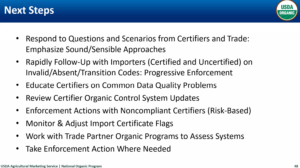
We are only five weeks into this, and we are already seeing some real action. We do need to monitor and adjust the import certificates flags. There are a lot of customs brokers getting pop-up boxes asking if something is going to be sold organic on something that can never be organic. That’s a glitch that we need to work on.
We are also working on trade partner module that is designed to interface between that exporter and our importer, and we will be taking enforcement action, as needed.
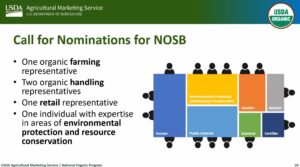
CALL FOR NOMINATIONS: Published this morning. We will emphasize the importance of one-to-one outreach. The Program does the same thing. We have a list of over 300 people. We do a lot of direct marketing from the Program. Want to encourage folks who applied before but didn’t make it onto the Board. Encourage folks to reapply. Timing is everything. Looking for 1 farmer, 2 retailers, 2 handling, 1 environmental protection and resource conservation. This is going to be really interesting, as the retailers have a lot more skin in the game now.
TOPP: We are going to be hearing later this morning from the Midwest TOPP group. At a national level, so far in the TOPP program, we are at 1.25 years into this, and approximately 20,000 people have engaged in the process to learn more.
When we look at the mentorship process, we have received 275 mentor applications, 375 mentee applications, and 30 mentorships have been made. Approximately 400 instances where technical assistance has been offered at this point.
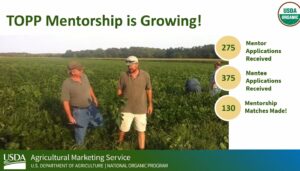
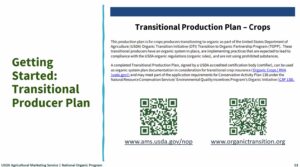
TPP Goal – Once the farmer has completed a TPP, and a certifier has signed off on that, there is a desk review. Once it appears that the operation is going to be able to comply and a certifier signs off on that, that operation is eligible to be listed in the OID as a transitioning operation. Not available to the public; only available to the USDA not the public while folks are in transition.
PEER AWARD: We have a program where we give an employee of the quarter award, and when we have a peer who has won it in the room, I like to give it. This quarter, it’s Jo Miranda.
This is a peer-nominated award. The entire standards division came together to nominate Jo for this. She is such a smart employee and so helps. The primary driver for this award was the overhaul of the NOP Handbook. Cleaning out the handbook so that there wasn’t a lot of conflict between the handbook and SOE was a huge lift. Jo did not only a fabulous project management job, but a great job doing a lot of the writing of those documents. Jo, thank you very much.
Q&A from Board:
AJ: On transition in particular, just having a number to point to. 20,000 people interested in transitioning is big. Starting to get concrete and see this progress is huge. On Wednesday we will be talking about a proposal on transition, and one of the big pieces of feedback we heard this time around is about the NRCS part and people struggling to access and it’s quite uneven throughout the country. I know that it outside of the NOP’s purview, but wanted to know if you have any advice about this?
Jenny Tucker: We meet monthly with the NRCS in charge of organic programs. Have learned how differently their governance and role and structures and funding it is from how we tend to operate as a national program. My best advice is move with their system which means one person at a time. Every state is a little different. Their mission is very local conservation work. They are designed to have people on the ground providing service. Some don’t know about organic or don’t like it b/c feel not compatible with NRCS. Every office may be a littel different. Figure out how to distribute across the network.
Our TOPP folks are already doing this. We’ve had some TOPP leads that have tried to contact NRCS that haven’t been successful. There have been some challenges. We are lucky to get TOPP out and rolling fairly quickly. NRCS has had more challenges. My best advice is to work your local politics, because all politics are local for NRCS.
BC: Ignorant about – what are customs brokers roles? And whether there are other govt agencies that can helps with residue-testing part, basically fraud prevention, at the borders. Can we transfer some costs of that from certifiers, handlers, and farmers to exporters and other entities.
JENNY TUCKER: What do customs brokers do? I went to a Customs Brokers conference a couple weeks ago. They are responsible for making sure that imports into the US comply with the law. For a product coming into the US, they need to understand what the rules are for that particular product. I was sitting next to an AFIS employee that is in charge of the Lacey Act, which relates to not being allowed to bringing in endangered species into the US. There are all sorts of FDA laws that they need to follow.
BC: Are they the same as custom agents? Are they govt employees?
Jenny Tucker: Not gov’t employees. You can go to school to become a licensed broker. It’s quite a process. These can be individuals or part of an LLC. Can be multinational companies that have brokers all over the US. Impressive group.
In terms of testing, we are doing more testing now from the NOP. Aware of commodity/country combinations where we would like to do surveillance. We are collecting samples at different ports. We also have Federal Grain Inspector Service, a sister program to AMS, that already have folks at ports. They have agreed to helps us with a pilot to flip the role and do sampling of imports coming in. With SOE we’ll have a better sense of what’s coming into what port.
BC: Thank you. This is so important. Thank you for the effort you are putting into it and the comprehensive aspects.
AB: Very encouraging – early assessment of SOE. Question – transparency about acres on certificates. Operations become apparent on OID. Insight into grower group and acres and about equivalency partners – how do we get transparent data relating back to the farm. Touch on equivalency partner oversight.
Jenny Tucker: First, this is a Board recommendation that was implemented quickly. NOSB had a lot of work on acreage on certificates. It is now a required field in OSP. Grower-groups – the requirement has 2 steps. Most operations are not grower groups. Have to think about how data relates to each other. It would not make sense for certification bodies to enter in zero or one. Grower groups are linked to business type – which can be found in Integrity database. If cert picks grower groups as business type then there will be more entries to fill in for grower groups. That system will be live in about June. This is a significant lift. The number of grower group entities will be mandatory by the end of June – you will be able to see total acreage and the number of farms in that acre for certifiers. Exporters to the US – the same is true. Lots of handshakes and governance boundaries with trade partners. The operations/producers inside those govts are actually growing but are not the exporter, that’s the responsibility of the trade partner country. If there is a problem we have to work through trade partners
Good news: we’ve been doing this for a long time. Need to be aware of and monitor closely over the coming months. About 37% of import certs coming in under trade arrangements. If problems have to work under trade arrangements. Some limitations in terms of jurisdiction and transparency. We need to acknowledge how advance OID is and how transparent our system is. Might spark other govts to become more transparent. Still questions about whether really equivalent that need to be asked.
This is a process, not an event. There are country to country negotiations. We cannot require all of our trade partners enter in all of their crop and acreage information. The question is if we are equivalent. We will be sharing what we are doing on SOE, and we will be asking them what they are doing to deal with it. Having the import data will give us a better understanding of what is going on. If we have an invalid import certificate from a company with equivalence, we can ask them to investigate it.
KH: I want to emphasize that when we receive beans, does the farmer have organic labeling on his trailer. The non-retailer part of the rule is challenging. You’ve mentioned that by 5/17 you expect to have feedback from the certifier community. What are the next steps?
Jenny Tucker: Going to be, already iterative process. Had great conversation with certifier. Small farm, only produces organic, only ships to aggregator who is 100% organic. I use this container to ship from one 100% organic producer to another 100% organic producer, so does this container really need to be labeled? This is where I want to emphasize importance of the preamble. Often used to reading the regulations and there might be a line that says, “shall or “must”.
There is always going to be a call for consistency, and I want to remind us that different business are different. If I’m selling to an organization that has both conventional and organic products, their rules may be that they need to have that labeled. There might be other small farms that have a different supply chain. We need to find boundaries and business rules where people can explain critical thinking. There is going to be a bit of a conflict between sound and sensible and meeting the requirement. In general, if you’re at the beginning of the supply chain feeding into it, your burden should be quite low. We are encouraging folks to talk to each other, talk to their certifiers. There is work going on at the level of the ACA where we see groups working to solve these common issues.
Also working with NOP to ensure our auditors know what “sound and sensible is as well.”
Nate Powell-Palm: You mentioned this for a second; when we were asking the question of how we can get better as mass balances, the community said that it would be helpful to have acreage on certificates. The speed in which we could do that was incredible. I wanted to thank you for the partnership and getting that across the finish line. It was really exciting to get on OID three weeks ago and see all of this information.
JENNY TUCKER: So much of this work is possible now because of the technology being available last fall.
AJ: Excited about nomination process and want to see a diverse team coming in. What factors are used in selection?
JENNY TUCKER: For folks who have not been around the process before, encourage you folks to do outreach to encourage folks to apply. The call lays out the criteria for that. We have a strong interest in organic expertise, but also a strong interest in equity and diversity. The call for nomination and rechartering of the Board goes through a civil rights review. Think about the areas of expertise on the Board that will be leaving. We also want to reach out to a broad set of potential candidates who could really add diversity to the conversation. We are looking to increase representation in Indian, Alaskan Natives, Pacific Islanders, Native Hawaiians, and people with disabilities. Those are areas that are under-served and represented. I also encourage Board members to update their demographic information with Michelle if they meet any of these areas of diversity. USDA’s form does not necessarily include all of those different forms of diversity, but if you do have one of those areas, we want to ensure that it is reflected.
AB: Discouraging fraud: the penalties are clear domestically (fines, jail, removing certificates). What are the equivalent enforcement levels that can be acted on international folks?
JENNY TUCKER: getting better at knowing what levers are and how to push them. We have a couple of appeals cases where operations have been proposed suspended or revocation in another country. We are advancing a couple cases to Adm Law Judge. Process of serving foreign is challenging. One of reasons we ended India recognition is b/c they weren’t kicking out certifiers that needed to be kicked out and not taking actions against operation that were noncompliant. Certifiers in US system kick out about one entity per day. They can and do kick out their clients. We look at how many operation certifier has actually kicked out. We consider that an element of risk. Trade partners: also challenges b/c one to two steps removed on enforcement.
KYLA SMITH: Question during public comments: how long to see an impact from SOE? You’ve reported some early wins. Can you share when the community will see or feel notable differences domestically?
JENNY TUCKER: First, I have a more positive view of SOE. I think it’s way more than an eggbeater. I think there’s a whole lot of potential with SOE, and we should exercise optimism and faith. A lot of people gave a whole lot of comments to SOE, and I think we need to give it a chance to protect us. Give us a chance.
We know that more than a dozen customs brokers who have called us and said that they rejected product as organic because they didn’t have evidence of organic status. We are seeing a big jump in trademark violation investigations. Customs has been actively doing that for almost a year and have blocked a whole bunch of products. The ENOPIC gives them another step. We have someone regularly getting calls from customs saying that they thing something is violating trademark. That is held then based on CBP authority, and those holds come with fees as that product sits in a warehouse while it is being investigated. That is a deterrent. We are seeing a number of those go up. Those are immediate impacts. We are not getting calls from every customs broker when they mark something as invalid, but I think that the calls that we are getting are encouraging.
KYLA SMITH: with most any rule, it take a full inspection cycle to see what’s going on. Accreditation audits, as ongoing, with 3 rules, there has been a change with getting more info faster so I think program is able to act more quickly against certifiers not implementing rules effectively. More will be revealed on accreditation audits.
JD: To the questions that you’ve just been asked, I think there is another example that you gave two years ago, which is when you reach the stage with what we are doing with SOE, it is frequently ill-advised to talk about your successes. Things are happening right now that will not be spoken about for quite some time. That’s just my thoughts.
CD: Self-interest prevails. At project director meeting for OREI: slide with priorities that came out of farm bill when funding was established. And then he had list of 2 NOP priorities – one was theanine and the other did not make aa lot of sense. Do you know how those NOP priorities get set for OREI?
JENNY TUCKER: We do have a processor making sure research priorities get over to NIFA. They are an independent agency. Think they share some of the challenges. We aren’t involved in that process. We transmit Board priorities over to them.
Midwest TOPP presentations
Cori Skolaski (Executive Dir, MOSA Certified Organic) presents the Midwest TOPP program details.
CS: [Gives background about MOSA. MOSA celebrates 25 years.] Overseeing 11 states.
Allison Wellent: New to MOSA for the TOPP work [goes over agenda and speakers]. 5 program areas. Through these areas we continue to support farmers transitioning to organic. Midwest region is 11 states. Wort TOPP is accomplishing is possible through partnerships – 5 other regions. Partners in Midwest – identified core partner in each of 11 states. Our new relationship with national partners too – these allow us to difficult work and reach in underserved communities that need more opportunities. Midwest coalition of partners (slide) – each one has between 3 and 7 organizations leading the work in their regions.
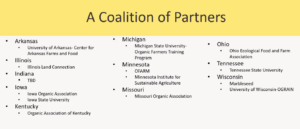
63 matched mentorship pairs which means they are working to bring approximately 2000 plus acres into production. 98 mentors waiting to be paired. Another 12000 acres in pipeline. 44 events and will be seeing more field days and on-farm events. Supported 198 producers with technical assistance. This is beyond the 63. Area of program we hope to grow. At those 44 events, we have touched 4,847 people. In Midwest, created 61 resources for organic producers – podcasts, fact sheets, webinars. Trained 142 organic professionals. Providing support to extension agents to support farmers as transition to organic.
If we look at the number of mentees committed today and in the pipeline – 190 farms – and extend that to the next 3 years, we feel that we could be impacting growth int he northwest region by 8-9%. Our goal is 10%. Relative growth over time has been 1-2%.
How is all of this work getting done? Relationships & collaboration. Relationships with all of our partners. Listening and understanding where each is coming from.
Roz Lehman, Iowa Organic Association: Mission is to advance organic ag and food systems in Iowa. Established in 2006. Broad group of supporters that includes all organic stakeholders who are interested in championing the organic movement. We focus heavily on education – webinars, field days, works, reaching out to students on college campuses. We are finally able to add a bit of technical assistance to our work through the TOPP program. We hired an Organic Farm Advisor, who also leads our mentorship program. We are sharing information out through newsletters and email. We are trying to connect policy leaders with organic and get them out to farms. Community building is weaved into all of the priorities that we have.
Organic ag in the state of Iowa: 6th in US in terms of production. Top producer of organic soybeans and hogs. Approximately 1,000 certified operations.
Jacquelyn Evers from Illinois Land Stewardship, Nonprofit in Central Illinois. Connected with Rodale, presents for their region.
Lori Stern, Marbleseed, Executive Director: Cover the upper mid-west. Marbleseed is MOSES rebranded. Mission is the same. Huge commitment to working with historically under-served producers, including Mung farmers.
Kenya Abraham, Organic Mentorship Program, Kentucky.
Mentorship can bring equity through work force development. Mentorship is cornerstone. 12 mentorship pairs in Kentucky. Having a good coach makes a difference in how things will turn out.
[Video about a mentor pair from Iowa.]
Harriet Behar, Mentor (Soldiers Grove, WI) presents for her mentorship.
Nick Stable, Mentee (Marion, Iowa). Vertically integrated food hub in Madison, WI. Harriet challenges ways of thinking, and how to approach a problem.
Q&A from the NOSB
NL: 3 questions (1) for Nick – imagine that your mentors are in ? Category
Answer: 100% certified
NL: Lack for processing and storage for grain. Any focus on transitioning facilities?
Answer: access is constraint. The priority of program is for transitioning producers. There are a couple of awards that came through. OFARM is a partner.
NL: Last question for Kenya. Would love to hear farmer Evelyn’s story.
KYLA SMITH: Also for Kenya, you mentioned most Kentucky black farmers are not participating in the program. Can you speak to why?
Kenya Abraham: She (mentee) purchased properties in southeastern Kentucky, but she does everything she can to educate herself. Building trust within this industry is necessary. She trusts me so therefore she is willing to cross the bridge. Other Kentucky farmers, and BIPOC centered orgs- trying to gain trust. They trust me. However, their relationships with ag industry as a whole needs to be some bridges to repair and restore condition of the black farmer. You can ask me to join your program, but I’m sitting here wearing flip flops and farming in them and I don’t have my boots necessarily. Our boots have been taken from us. This USDA would not exist without the back of the salve in America. Has to be restore and repair to condition of black farmers. Obviously outside of this program, however, you have to care about it and would love to say take me to your leaders b/c it’s what’s necessary to restore condition of black farmers. It would bring about access to organic markets to black farmers and food deserts which result from apartheid.
JD: Harriet was the first person I called when I joined the NOSB.
HB: When worked at MOSES spent a lot of time on the phone help people find their own way and everyone has own perspective to bring to conversation.
AJ: Exponential growth of TOPP is impressive. Logistic question – can you send us fact sheet about applications to transition, etc. How are you reaching conventional farmers specifically?
Allison: Invite any partner to come up and answer it. Program rolled out quickly. We targeted mentorship launch 6 months after signed agreement. Some of that is going to shows and conferences that are not our typical. Went to TN, more conventionally minded conference. Our partner in OCIA is doing some advertising. So don’t have clear communications formula but acknowledge that we need to.
Unknown speaker: In Iowa we do have a strong ag network. PFI is a great resource – for farmers that are organic-curious. Important to be that space in the a state.
KYLA SMITH: Thank you for the fact sheet. NRCS program is having struggles and challenges, we’ve heard form public comment. Do you have best practices or guidance that could be applied elsewhere in country?
Allison: One of the things mentioned in fact sheet, our office was ready for the rollout.
DN: Also thank you for clarifying why TN part of mid-west. There are more mentees than mentors. How do you connect mentee and mentor and can have mentor have more than one mentee – like 3,4,5? Do you consider how farm located, size of farm, virtually, etc?
Unknown: States like Arkansas and Tenn have much less mentorship happening. So in Arkansas and Tennessee we’ve taken first year as education approach. Including educating NRCS staff. Arkansas has a serious interest in organic ag in delta area but are profoundly threatened by dicamba drift. The NOP said they wanted to see consistency in how mentorship was implemented.
We have a monthly membership subcommittee meeting.
AB: Insight into TOPP is great. Thank you to Iowa Organic Association – some of the best practices were helpful when shared with Plains region. When we look at success of TOPP and recruiting new producers – do we need to start thinking about part 2 for retention of these producers? Would that be beneficial to have in the que?
Unknown: Absolutely. Been thinking about Part 2 of TOPP. Have a lot of convos in network and we can provide mentorship to transitioning producers but also have to focus on market development and access to markets. We are only 18 months into 5 year program, but need to start thinking about what transition at end of the program looks like. What does that cliff look like and in particular as think about racial equity and inclusion, we would do disservice not to consider what end of program looks like and consider lack of trust and then to be abandoned at end of 5 years, so yes, we need to be considering transition and a Part 2 and to develop markets.
AJ: Farm Bill is being debated and funding for TOPP is on the table. Encourage people to show up in Congress in addition to here.
LUNCH BREAK
Public Comments
Note these public comments are in-person at the meeting.
Rhodes Yepsen, BPI
Executive Director of BPI. Petition for rulemaking on compostable products. Leading authority on compostable products. Submitted letter to USDA re: whether National List can use compostable feedstocks. Compostable products – CA demanding change. Passing laws for mandatory food scraps collection. CA also mandated it be allowable input by 2026. Based on discontent compostable products are causing finished compost to be disallowed in organic. Organic brands, coops, brands to see early adopter of compostable products. These brands will soon lose in CA. Food scrap collection bag would be disallowed. Climate emergency is created in part around packaging. Many landfills are super emitters. ASTM standards are rigorous. Encourage USDA start rulemaking process. No time to wait
AJ: Piecing together moving pieces of this puzzle and have been having trouble tracking down CA requirements. Can you send that to us? Do you know year or number
RY: The requirement is in the definition of the plastics labeling bill – not have PFAS, be allowable AB1201 and it was a few years ago.
AB: Definition clarifications. Devil in details. One, is there any distinguishing factors visually between a certified compostable product and a compostable product?
RY: Question is very key to our organization. We require items to be labeled in order to get our certification – require them to be marked so they can be distinguished. Several states have laws requiring compostable product labeling. Even when conventional products are unlabeled. CA, WA, CO, and MA included. This year we even kicked products out of our certification for non-compliance/
AB: What form would a label be put on a product?
RY: It can be many. Nate Lewis holding one. Printing or embossing are common methods. Stickers that are certified compostable. Stamps and other things. We did some work with close-loop partners on how to make things identifiable to the consumer. Coloring is important they found in consumer tests.
AB: Definitions – certification process for compostable – you’re looking at PFAS if intentionally added?
RY: Correct, intentionally added PFAS. We developed that with others – including San Franciso. It was the easiest way to track. Intentional use is done from chemical screening. Sometimes it can be from a spray you put on equipment.
AB: Is there a chance for unintentional PFAS to be no captured?
RY: if think about recycled paper, it could be getting in through that. Could be coming through in recycling stream or water, if have ground water with PFAS – how do you not use water?
MJ: As retailer spent a lot of time in stores excited about sustainable packaging. See all of us – retailers, composters, sustainable packaging – as related adjacent industries. As NOSB we are collecting as much info and expertise as we can find. So thank you for coming to our method. Struggling with ASTM standard. If I read correctly, one of them says 90-100 to 180 days. A certifier reflected to us they would have to verify composter that that occurred. If we could include compostable packaging would we then need to make sure composter has been using that amount of time?
RY: multiple tests in the standard and you have to meet all of them. Tiered from raw material to a finished package. 180 days is for a raw material. Some are 90 and some up to 180. The tests in ASTM standards are tiered so you have products by time finished been tested in retested. 180 days is in isolation in lab. If you have other active feedstocks, don’t know if biodegradations from. Challenge to test in open environment because of the variables.
If there are concerns test the finished compost. Materials do not remain if you go through sufficient composting process. Analyzed microplastics and when you find them then the compost is not finished. May not be suitable for organic agriculture.
AJ: Little info about PFAS threshold. BPI – 100 ppm. Lowest could test for was my understanding and now can test down to 10 ppm. Is it feasible to drop that standard as technology improves?
RY: The ACM standards are in a process of continual improvement all of the time, so we are happy to look at that. There are passive receivers of materials, and we are trying to protect the composter as much as possible, so if we can improve our process, we are open to that and figuring out what that new threshold could be. Denmark moved to 10 ppm.
AB: You mentioned that you reviewed some of the written comments and studies that are out there. I have a written comment, “The BPI certification says nothing about potential toxicity of a product, only its capacity to biodegrade.” What are your thoughts on that?
RY: Not true. Withing ISTM standards there are plant toxicity tests. PFAS restrictions – a lot of restrictions against carcinogens, etc. US standards for heavy metals are quite liberal. We certify to Canadian standards. All our products certified to Ontario ? Standard. Making sure our products meet requirements compost has to meet.
WT: It is hard for me to separate compostable plastic from our single-use plastic disease in this country. I think about what has created compostable plastic. Frankly, a poor labeling process 30+ years ago, so when I think about something that has to rely on certification and labeling to de3termine what is going into the system, that concerns me. I think the labeling system that was invented by the plastics manufacturers is concerning. What do you think of that?
RY: Our program is different. Chasing arrows certification is getting overhauled. Self- identified resin code. I don’t think you can compare the two. Looking at tests and certification and making sure consumers know how to dispose of item.
BC: Back to the 100 ppm threshold for PFAS; what is that specifically for? Is it a finished product, inputs – what exactly is it?
RY: finished packaged, 100 ppm fluorine. Test is readily available. We’re concerned about number of PFAS chemicals.
BC: That is for total organic fluorine. That range – can you recall what the recent EPA drinking water threshold is?
RY: EPA drinking water is in parts per trillion.
BC: Yes, it is. That is perhaps 1,000,000 times higher than the drinking water.
RY: Totally, yes. We have more than that in our blood before we’re born. We are trying to get on reasonable test criteria. We are on the side of eliminating PFAS in packaging. We are all for figuring out better testing for certifiers, but as you all know, it gets challenging. If something shows up in a part per trillion in a formula, it is banned.
NL: Can you describe how BPI does enforcement of your label? IS it a trademark logo?
RY: It is trademarked. We have a fair amount of authority for enforcing when someone misuses our mark. Some states have passed these around the use of the word “compostable.” We pursue misuse to the fullest of our ability, either to get someone to enroll in the program or pursue legal action to get them to remove the mark.
Sal Pinkham, OEFFA Certification
[Comments pending.]
NATE POWELL-PALM: What type of farmers was the transition plan with?
SP: A mix of the two. We have a working group as part of our policy program, not certification program, comprised of OEFFA members broadly, and it includes both groups.
Michael Crotser, Organic Valley
Certification director at CROPP Cooperative. I want to discuss generating organic certificates through OID. Purpose of 205.204 was to ensure consistent formatting. Goal of improving transparency and accessibility. We are seeing inconsistencies in the OID. One is that some have issue dates of the same date that it was generated. We hear that this is being corrected so that the issue date will only change when certificates are updated and products added or removed.
We are seeing either the mailing address or physical address. The physical address would be better.
We are seeing certifiers issue product addendums, but they are harder to obtain. Concerns include 1) it does not appear that OID certificates are meeting the goals of transparency and accessibility. 2) Operations do not know what they need for compliance.
We believe that these inconsistencies are creating discrepancies between certifiers.
AB: Addendums – how do you know if addendum is available for an operation?
MC: That’s a great question. Usually we have a hunch that information that we’re not seeing on an operation profile – something is missing – and then we start looking at an addendum. Branded items or private labels would be a good indication of that. If we get a certificate off the OID and it’s not showing private labels that our business manages, then we know that it probably has an addendum. Of course, it probably shouldn’t list a private label, as that blows the use of the private label. If we are struggling to know what we need in our OSP, I’m sure so are a lot of other people in the industry.
JD: You went by private label. I didn’t catch the reference?
MC: It’s kind of difficult tot talk about as a business, but generally, milk marketers, copackers in the industry will produce for store brands. That’s something our business does – bring those to market – and generally they are rolled into the OSP. Generally, everyone knows who is doing what for who, but generally that’s not on the organic certificate. Generally, the certifier will provide a private label certificate. Primarily for proprietary reasons.
Gwendolyn Wyard, Strengthening Organic Systems, LLC
Founding Partner of SOS. Mission – insure authenticity of organic products. Two topics (1) pullulan. Can be produced organically. Certified organic forms are available (pullulan). Most of production is from China. However recent exp of patent restriction has opened sales in U.S. This Oregan based co. Can make 500 metric tons and 2 billion organic capsules. However, demand is less than 30% of capacity. On commercial availability the NL allowance is for “made with” category. If company wants to use seal on capsule, they must use certified organic version. Most want to use it, but not quite there yet.
TR Templates: The proposed TR revisions around excluded methods. I believe the information could support a more accurate compliance review. The issue is how that information is used. In order to achieve the goal, improved material review policy, improved oversight and consistency will need to be coupled with that information.
DN: The analysis of pullulan is it now conclusive that it is non agricultural and non synthetic.
GW: Yes. In 2016, when classification came out, when run through decision tree, it came out as non-agricultural. That prompted 2018 petition by OTA to get it on NL so it could continue to be made with encapsulated. Otherwise was going to have “made with” capsules out the door. Yes, there is organic pullulan, but it’s really new to the market, so everyone is now working to adjust.
DN: Probably going to take years but do have option of organic now?
AB: Thank you for joining us. Question on residue testing – challenge you to come up with a solution – regarding when specific tolerances do not exist for a production commodity – what can we offer as a solution?
GW: I will refrain from answering that question here. We are working on it at SOS. Johanna Phillips would probably be better suited to answering that. I promise that we will be coming up with some options for solutions on that one.
AS: Follow-up on Dilip’s question – it sounds like we are saying we could sunset it because there is organic supply, or are you saying that we’re close but not there?
GW: think there is more research to do. Just started working with the company making it domestically. I know they aren’t fulfilling their capacity b/c there are cheaper versions out that – international.
I think I would rather see someone petition to take it off the NL than sunset it. Keep in mind that it is with the “made with” category. It’s available. It’s there. While people are building up and changing, I would rather see the shopper and the market drive us there and keep it on the list, and then have the petitioner or marketer tell us it can come off.
David Will, Methioine Task Force
VP of Sales of Chino Valley Ranchers. You have a binder that ghost writer did for us. Deep dive that was everything methioine since inception of the Board. Includes reports that have been presented and a zip drive of other reports. Everything in here. ON our slide presentation, we are represented by egg producers and broilers.
The big question is why we use methionine. It is an essential amino acid. No lysine in it, and has a nice protein value. The most leading potential substrates that we can use – black soldier fly larvae and sunflower meal. We are constantly stressed with getting enough sunflower meal.
If you take a deep dive into the black soldier fly, if you take the 35M broilers that are in production per day in the US, you would need 280 lbs/T to equal the same as the amount of methionine being used. That is a dried figure. If you take it as a liquid, it would be a little over 2.5B lbs. With every lb of black soldier fly, you get about 2 lbs of fertilizer, which is not a bad thing, but something we’d have to deal with.
NL: Would black soldier fly affect whether could label vegetarian fed?
DW: Always going to eat a certain amount of invertebrate. Have to run it through a legal challenge b/c now intentionally including it in ration.
KH: Skimmed over availability of sunflower meal in the diet; can you speak more to that? Your production is west coast focused?
DW: We’re up to the Mississippi Ocean. We do a particular product – soy free egg. Replacement we found for that is sunflower mill. Been challenged finding a source. Asked our nutritionist nonorganic something we can find. Not really available.
KH: Talk to me about sunflower meal and where it’s produced inside the US. Logistical restraints can be challenging when we talk about infrastructure. But I’m always trying to challenge what alternative proteins – we’ve heard farmers talk about not growing sunflowers because there’s not a market.
My other question: do you feel like the market would abuse methionine if there wasn’t a limitation on it?
DW: we source from everywhere. High side and low side. Always hit diminishing returns. We came back and asked it go to average of life of flock and granted that. Most can work under that system. If remove the cap, some would use more, but over life of flock, don’t see it changing things dramatically.
AB: As a producer, your comment on the sunflower meal really perked my ears. Were you running into sourcing challenges in the US?
DW: Got a lot of it from Mexico for years.
AB: this would be an incredible opportunity for infrastructure in the US. There are a lot of producers close to you who could grow this.
DW: absolutely and need a home for the oil because getting the crushed part out of it.
NPP: Could you speak to animal welfare of under-feeding methionine?
DW: Chicken needs essential amino acids. Feather pecking, nervousness, if you walk a house of brown chickens you have to shoo them from under feet. With methioine deficiency they are like white birds and are flighty. If overfeeding soybean, then extra amino in houses. It’s all across the map. Significant impact to welfare.
Bill Wolf, Wolf & Associates, Inc & Second Star Farm
[Comments pending.]
LP: From written comments on CO2, on the petition, is that okay if ask that?
BW: I can tell you that it was very carefully thought through by a group, and that answer would better be provided by John Foster, who will be speaking in a couple of minutes.
NPP: Regarding growing organic markets – when we say ask for 5% of USDA research dollars, why in this community to we have such a hard time asking for our fair share?
BW: Important to understand that USDA funding can’t happen overnight. We have to have infrastructure to manage that program well. Fact is this conversation about asking USDS and Congress to allocate funds proportional to industry, is basic business principle. We’ve been asking this for 25 years. We don’t spend the money to support the R and D. Done so much to encourage imports by our inaction.
Ben Lehman, Rodale Institute
Organic Consultant and farm organic grain in Iowa. Rodale is dedicated to growing regenerative organic movement. Share experience with 823, NRCS – provides conservation contracts. 823 contracts are extremely effective in protecting soils and environment. Communication has been a challenge. Quick turnaround many transitioning farms hadn’t developed relationship with NRCS. Awareness is highly variable. Nationally coordinated list of deadlines could help make sure funding utilized effectively. Inadequate funding for certified acres. More federal funding is needed to boost conservation.
NPP: From what told earlier, you’ve had a bit of success helping farmers access funding. How did you develop relationship with NRCS. Any takeaways?
BL: NRCS brings agents to farm, challenge some existing biases about farms that do tillage. In some of our hillier acres. Getting real experience with organic farmers.
AB: some stats on states and their acceptance rates and you said Illinois had over 140?
BL: Yes, track contract instances. 142 years contracted for farms in 823.
AB: In Nebraska I think we had two applicants in the entire state. This Illinois number is interesting. Can we find number applied versus number accepted. Did people not apply b/c didn’t know about it? Where is the root cause for not getting successful connection between farmers and the program?
BL: In case of Illinois, a huge bulk of contracts – 1/3 of national funding went to one county in Illinois. Was not heavily promoted. Most of those contracts have been successful.
Noah Wendt, Organic farmer
ANW Farms. Continuing in-person and virtual comments is important. Member of OFA, OFA crop insurance working groups, TOPP mentor. In 2015 we began aggressive transition. Crops we grown are corn soybeans, hemp. We realized need for local grain elevator. Purchased elevator in 2022. Barrier to entry (1) lack of capital for non-hedgeable commodity
1 – Lack of capital for a non-hedgeable commodity. This is where we struggled, because we couldn’t secure and operating note. It would be great if USDA could offer help in this area.
2 – Lack of infrastructure of rail cars. It would be great if USDA could allow some grants to allow small businesses ability to ship their products.
3 – Lack of buyers due to cheap imports. Often times this forced us even to compete to buy the grain, because there wasn’t enough margin. The buyers would always tell us that they wanted to buy as much domestic grain as possible, but then didn’t want to pay our prices.
After Jenny’s update this morning, I’m more hopeful. Due to the events listed above, we were forced to close our business in March 2024. I do still have the desire to make this work, but there need to be some fundamental changes. I hope that SOE brings them about.
NPP: Thanks for the clear example. If hadn’t seen prices crash, what do you think your elevator would have done for your community?
NW: I definitely do, and that was the goal of the elevator – to promote organic production and form a community of producers that were within 50-70 miles to make it efficient for them to haul to us and have all of the different options that they might need. I do think that if prices hadn’t crashed and we were still running, we might have had the chance to build that.
KH: Having you present, in-person, goes to show we appreciate effort you made to come and also understand virtual and how important farmers’ voice. Can you speak to any communication you’ve had with railroad entities to provide some benefit of cost saving to move product within the U.S.
NW: In the 1.5 years that we were open, we did have pretty extensive communication with railroads. It was quite a fight to get the cars when you wanted/needed them. One of the biggest things that we struggled with was the lack of dedicated organic cars, so we’d have to clean them out. Other than those things, the railroads were generally decent to work with, other than the logistical frustrations.
AB: You mentioned about end user and cleanliness of rail cars. When looking at imports also looking at clean out process – shipholds, containers – can you talk about what they wanted you to prove in terms of cleanliness?
NW: Generally, they wanted swept and blown out. We didn’t have to go to the extent of powerwashing, but even sweeping and blowing out can be a big feat if you did not have the correct equipment. And an affidavit.
Kate Mendenahall, Organic Farmers Association , Organic Farmers Association
[Comments pending.]
AJ: Our transition proposal we will be voting for on Wednesday – sounds like you are asking us to do something beyond that?
KM: Yes, when the EQIP program was rolled out it took awhile for it to be useful for producers. The rollout this year was scattered so I think it would be helpful.
AB: Comment the other day that need for organics to reach across the aisle to Farm Bureau and others. Do you see that to be a beneficial pathway to get more attention to needs we have.
KM: Not sure about Farm Bureau, but think we need to be putting selves forward and forming relationships with industry groups. We need to find out where make the most wins. So yeah, bring in other groups to learn more about organic – always a positive thing.
NPP: OFA has been active in recruiting new NOSB members. How can we chase 2 goals. Find representative folks from diverse background and find competent folks?
KM: Should always be a top priority to support diversity. It’s hard to be a farmer and serve on the NOSB. Any self-employed business person feels that. Whatever we can do as a community, we should be innovative – opportunities to support BIPOC farmers with fellowship who may want to serve or hire someone to handle farm. Need to think about English second language folks on board. Encourage community to find diverse set of qualified leaders.
NPP: do we know who those rockstars are we want to recruit? Or is there searching we need to do yet?
KM: Many rockstars do not feel they have the time to serve. When NOSB recommendations move to rulemaking it shows how they can make more of an impact.
Kelly Damewood, CCOF
CEO of CCOF, serve on management committee. No specific recommendation: share CCOF internal conversations after a CCOF organic dairy in the media. Greatest strength is scrutiny. The greatest challenge is federal enforcement; it’s slow and enforcement is slow and producers have rights. We do issue corrective actions. Standards prohibit certifiers from sharing specific info about our clients – so we see a lack of understanding and trust. We welcome partnership and want to explain the enforcement process and help it be understood. Beyond certification, the article said the “system failed the cow”. I disagree, the system failed the farmer. And when we fail the farmer we fail the cow and the land. Enormous pressure especially on dairy.
When we read articles like this, we evaluate what we would do differently or better, but we also look at the bigger issues and ask how we support the farmer, because when we support the farmer, we support the cow, and the dairy, and the land.
NL: I appreciate the sentiment and you being here in person. In my work at WA Farmland Trust, we focus on a land-focus in our work, but we are trying to become more farmer focus, with land being one tool in our toolbox. Can you talk about what CCOF is doing in this work?
KD: Little bit of everything. Sometimes advocacy, financial aid, conservation. Can be a lot of misunderstanding from env groups. Technical and bilingual assistance. Really looking at all different angles depending on farmers need, region, and location. If we don’t have farmers in business then no-certification. Really is a little bit of everything.
WT: I appreciate you showing up. We needed to hear from you today. I think often in the organic movement we take the criticism and put our tails between our legs. You mention retailers specifically. I’m curious if you think the retail toolkit that was described earlier today has the potential to improve things for farmers, and work for farmers, and work for cows… Curious if you had any reaction to that?
KD: As much consumer education as possible. What’s also broken is how price premium breaks down for the farm. Certification costs are increasing and how are we supporting farmer on other end. In CA increasing regulation. Have to look across entire supply chain when looking at market dynamics. This is very important to us. The process is working. Are there different systems to put in place for larger diaries – willing to look and overall proud of the work we’re doing.
AJ: Every time I see one of these headlines that says, “The real truth about organic,” my heart sinks. Often, it’s picking at the edges and not showing the big picture. I think one of the reasons that these articles get picked up is because consumers do not understand agriculture. I do not think people really understand a dairy operation. Do you have thoughts about how we can help consumers understand that it’s not like dreamland or the worst of the worst, but that there is a practicality that we should all understand about food.
KD: If look at commentary of article, it’s really about value of livestock products in general. Want to commend, organic grant program that uplifts organic certification process that speaks in no-wonky way about what organic means. We need to be on digital platforms and thinking like digital marketing professionals. Can’t think of more important Farm Bill priority than market development grant.
Philip LaRocca, CCOF
Organic farmer certified in 1975 – grape and wine. Chairman and BOD for CCOF. Yeast used for fermentation and malic acid – also fermentation. Peracetic acid is also very essential for organic wine and beer makers. Importance of marketing organic to everyone. Every representative on my Board comes back and stays they need marketing and needs consumer education. Farmers saying they can barely hang on and would make more conventionally. Everyone is here because this industry is built on the back of the small organic farmer. If we produce $79bil product – people are spending this money, why ar they doing it? All of the above,. We need to get that out to the consumer. We are better than conventional. Organic farmers take so many risks. We need to tell that to consumers – the word premium irks me. It’s not a premium. What we get is the money we are making is the cost of doing business. We need to say we are better and we shouldn’t be afraid to say that.
AB: I agree with your comment on “price premium.” It’s the cost of doing business. Good point. Earlier today we heard from Dr. Tucker about some of the early wins of SOE and how that related to wine. With our equivalency partners noticing that some of the wines that were being imported actually had materials in them that weren’t allowed.
PL: had this dialogue last year and what was hurting organic wine market are imports from Italy and France. In addition to not playing fair, they were cheating, but other problem have to deal with is that grape growers there are subsidized. They are given guaranteed price in Italy. Imports from Chile and Argentina they are paying 10 per day. In CA 20 per hour. Cheap imports subsidized and perhaps cheating that hurting the cause.
NPP: Do you think it is a good path forward to think about how every raw ingredient we sent to the EU or Canada, they test, and we test very little that is coming from them to us; do you think that playing catchup would be the way to go?
PL: I agree with that. As long as it doesn’t increase price to American growers. It’s costing us $80,000 to get into our new program. We’ve always been grumbling about certification costs, but stronger these days, because we’re all experiencing hard market.
NPP: In this room, we are good at coming together. You gave us so many good takeaways for the message we should be getting out to consumers. How do we start to organize and pool funds to get those messages out?
PL: I think organic farmer should be subsidized by federal government – we’re keeping people and planet healthy. I think we should say offering product healthier for environment, for human beings, etc. etc.
JD: I would like to thank you very much for saying yourself to this Board that there are some things that we just cannot do. I have colleagues here with whom I’ve spoken about how we affect the market and how we can change things, but at the end of the day, there are just some things we are not supposed to be doing and we wouldn’t be effective.
Scott Rice, Organic Trade Association
Senior Director, Regulatory Affairs. Member-based organic representing organic business across North Am. Grow and protect organic.
Appreciate the perspective of both sides of the table. As a Board member, yo uhave the desire to push forward and get things done during a time that passes too quickly. Just as your time on the Board passes too quickly, so does that 3-minute comment period. I’d like to echo the comments of Mike Dill with his ideas on how to address this through opportunities throughout the year.
We will be gathering colleagues to talk about the inerts issue, and look forward to sharing those on the open docket.
It’s clear that we still have more work to do – to transition more acres, keep those certified in oragnic, education for consumers on the value of the seal, the importance of the public-private partnership. It is by working together that we have grown this movement. But as we implement SOE with the requirements for additional paperwork, we see producers working harder than ever for that organic dollar. There is opportunity for this public-private partnership to work harder, as well.
OTA is working to build bridges between regulation and practice. We look forward to sharing more on this soon.
CD: Thoughts: several people say “we should have more meetings” or town hall things. On the other hand, we hear that this is a burden for farmers, so I don’t see how that can happen. Also, as OTA, you’re in a unique position in that you work with quite a few higher end processors. How do you see your role in trying to improve processor behavior?
SR: We are in a unique position. Idea of regulatory guideline program would really serve that conversation. Bring all concerned parties to table. Some avenues might not be as easy. Conversations with certifier may make producers nervous. Certifiers cant consult. Lots of potential for the idea we are working on and other ideas.
Charles Benbrook – Benbrook Consulting.
ORG-tracker is a new system to catalogue the residue data and running it through the residue index. Want to provide detailed info about where the real risks are to the whole food supply. The power we have to understand where the risks are, where they are coming from, etc. Has moved far. My team has worked on the last 5 Consumer report stories – including the one that just came out a few weeks ago. We created many tables that show the risks of pesticides, and the span of dietary risk. The span of dietary risk is 10-thousand fold. It’s important to focus on the few high risk samples in the food supply. We know which foods, where, and which pesticides are being used. If we could target the 1%, we could get rid of 90% of the dietary risk in the food supply. The policies that NOSB and NOP are facing with Kathleen, Brian Baker, and myself on suggestion to move forward on inerts. We think that can move along. We will do what we can to help.
NL: You mentioned gathering info from certifiers from periodic residue sampling. Can you tell me experience getting those results and whether we can suggest guidance about how those results are made available to the public.
CB: Idea came up 2-3 years ago. We are building the system now and in next 2-3 months, do analysis work with certifier data. We are pesticide junkies – I’ve done this for 35 years. Public can get more bang for buck under NOP rule – want to show people how that can be done. I got into this game in 1980 and reason consumers came to organic was to reduce pesticide dietary risk. Driving home the significant public health benefits of eating organic, especially fruit and vegetables, there is a hell of a story. Has not been a priority of US govt to say better to eat organic and feed young children organic food. Things are moving fast now. Contemporary levels of pesticides are linked to adverse outcomes.
AJ: Chuck’s work – we have a lot to be thankful for your work and dedication over the years. First: the transition presentations we heard this morning – saying we have good tools for identifying high-risk foods now? Is there an easy path then to try and link this info to our transition efforts too?
CB: Absolutely. One thing to understand – we get ppd data two years after it’s collected. Certifiers are testing and getting results much closer to when it goes to the consumer. That makes it possible to have an early response. In 2022 ppd, organic green bean was like the 13th riskiest sample of all the ppd crops that year. We have remarkable ability for crops that get tested by residue testing programs – most of risk in fruit and vegetable – there are some other areas increasing. Herbicide risks increasing and big problem. Going to do everything we can to bring new tools to consumers. If consumers start demanding organic fruits and vegetables, then going to benefit.
AJ: The follow up is: agree with you that consumers are driven by their own personal risk for eating food. But we know the environmental risk of pesticides is high. Is there an analogous data set to target risks in the environment?
CB: So many components in the environment. Organisms live in different habitats. Pest management systems extremely complicated, hard at policy level to conceive of coherent way. But this country is way too reliant on herbicides.
The average American is peeing out about 6 herbicides a day year-round! The neonics, all pesticides, etc. About 8-10 pesticides are leaving our body every day. Luckily the levels are low and not damaging our DNA usually – we can still reproduce. The biggest thing that could happen is getting a 3rd crop into the Midwest. In a corn soybean system it’s impossible to make progress.
AB: Could you comment on innovation that could happen in private sector for speed of results. We’re waiting a week or 10 days for lab results. How can we accelerate data exchange?
CB: I don’t think there has been near as much interest in the private sector among venture capitalists in investing in better pesticide residue testing. It’s an orphan area. Think about it; why was it left to me and my colleagues over the past 35 years to build this tool? Why didn’t Google or Amazon? They have the experts and the hardware, but there’s no interest in it. That’s why we could progress so fast if we actually use the information that is available to us. You all need to show that you are using this information in real time. I have some ideas to share with everyone down the road on the front.
BC: Appreciate your work and Dr. Baker and Dr. Merrigan. We are looking at residue testing to address imports fraud. I’d love for you to make targeted comments on that. I am thinking of glyphosate residue. Over the long run we need you to keep putting forward this message – we will have more bandwidth for what you are saying in future meetings.
CB: felt for a long time that what could rapidly grow organic industry is getting the government out of the way. The reason consumers don’t know organic is healthier is government policy. I’m using government data, but too many powerful forces in the food system who don’t want to look under this rock. Hasn’t been much positive change b/c of the clout of ag commodity groups, but the damn is going to break b/c a lot of people have adverse health outcomes that science is tying back to typical levels of exposure in food and water. I’m going to challenge the people in USDA and FDA to stop being afraid to say organic is such a better way to grow food. Every time somebody publishes a paper there is an onslaught of PR from conventional industry. Until we find a way to pierce through that cloud, it’s going to be an uphill structure.
JD: Listening to you, there are a lot of very exciting things that you have touched. Where do you begin taking your measurements? I’m wondering at what point you’re going to get to predictive analysis as to what is going to happen rather than waiting for someone to say, “What do we have here?” I also think you have a golden opportunity to address food waste in this thing, too.
CB: In 1996 Congress passed the Food Quality Protection Act. In this recent analysis, OPs and carbs are still the risk drivers, it’s just different ones. In the pest management and pesticide arena, we need to use this information that this data provides to us. We need to address the profound failures. Things that we grew up believing are true, but just aren’t. I see some real opportunities, and I think the tracker is going to really make it clear where the issues are, and that’s going to help deal with them.
F: Different direction – does the consumer play a role in all of this? Demand for “blemish free” produce is hard for consumers. The pressure on the farmers especially where there is high pest pressure – they will reject produce with a small hole but with high residues.
CB: Sure, and processors are part of the solution. There are ways to use produce that wouldn’t make the grade to be sold fresh. Have to be sorry for consumers – being barraged with microplastics, PFAS – has to be hard for people to keep track of what really matters.
NL: I read in NOC comment This is an intentional addition and allowance for a synthetic and that’s a very big difference about the compostable plastics about not wanting organic to support a single-use plastic. Did your members weigh in the potential for using a very narrow base use, i.e. fruit stickers and plastic liners?
SE: Bottom line is there are unintentional components, but this is an intentional allowance for a synthetic. What loop are you closing? Real problem is single use plastics. Better solution than saying created a problem how do we get rid of it. Who is paying the cost? Why aren’t we having the manufacturers pay the cost to figure out how to dispose of them. Need to step back and add things that can contaminate organic grain. So many instances when don’t create an avenue. Precautionary principle!
AJ: In NOC’s written comments, there was a section regarding delisting Vitamins and Minerals; do you have any specific concerns that you’d like to share?
SE: Can’t list Vitamin X, I don’t have that experience. Same problem with any listings that are groups. Big concerns of NOC members is that vitamins and minerals that if reviewed individually would not be allowed. Then issues of essentiality – keeping synthetics at minimum if we can.
MJ: Could you step back in time and be the farmer Board Chair who talked about the nitrogen use – considering 3:1 and no more than 20% – thinking about compost now, and we’re asking questions about C:N ratios. I’m worried about future and the breakdown of biological components that we might find questionable. Do we have consistency problems? Do we need guardrails?
SE: I think those standards have benefits. Where exact line is drawn, can argue. Don’t think having no standards around that is a good idea. Compost is part of soil building program and have C:N ratio that is going to build soils. With nitrogen, we went after most hot materials. Compost –probably some breakpoint. Guardrails would be excellent.
MJ: Just so I’m clear, you’re not saying a #, but you’re saying guardrails might be good.
SE: Yes. I haven’t had time to review the science on that, so I’m not the expert.
John Foster, Wolf & Associations
[Comments pending.]
I have a lot of affiliations: COO on Wolf Associates, former NOSB member, assisted with Meloxicam petition, on BOD for organic seed alliance.
NL: In Handling, citric acid is one of my sunset materials. Questions related to commercial availability. The response from stakeholders was mixed. What is your opinion around whether these commercial availability clauses should be added via petition when the market is ready for it, or via the Board’s regular sunset review? I’m struggling to make the case when we don’t have the petition to establish the need.
JF: I think it should be a petition process. WE have a process, let’s use it. Not a big fan of doing anything in sunset except that. Citric acid particularly, I have experience, not much out there. I don’t think that a reason not. When market isn’t providing adequate incentive, regulation could step in.
LP: In your written comments regarding CO2, stating that you are in favor of adding it to the NL; could you talk on that? More in particular – CO2 is super vital to the plant for photosynthesis. Organic GH producers, I would think that it’s popular. This isn’t a new way of farming. I expected more support from the community coming out and saying that we need this product, and it didn’t come. We’ve had 2 or 3 groups saying that it would be beneficial, but not as much as I’d expected. IFPA mentioned in their oral comments that it was really necessary and needed. We are scheduled to vote on it at this meeting, and I’m needing more clarity on it.
JF: I think it suffers from dearth of support form it comes from the same source that anything that isn’t on the list suffers from. Which is if the organic producers don’t have it on the list, they are not using it. So, it’s hard to motivate people. Enough people which isn’t the greenhouse, community is tiny subset of total growers. So, if you’re starting with small number anyway. I don’t know why other than small numbers, not sure why not more support.
Harriet Behar, Organic farmer
My name is Harriet Behar and I am the Farmer Services Consultant with the Organic Farmers Association. My vegetable, herb and poultry farm has been certified organic since 1989.
During the public comment webinars, farmers, buyers, and processors all spoke to the dire situation for domestic organic grain producers. Jenny’s extensive overview of SOE was very encouraging, with a robust roll-out and a strong commitment. U.S. farmers need oversight before the imported ships leave their ports, and at our own ports of entry, including overland shipments from Canada and Mexico. OFA asks the NOSB to show support for our domestic producers with a resolution to the NOP, asking for a speedy expansion of the residue testing pilot program to a much larger program. We are playing a game of whack a mole, when we stop one source of fraudulent grain, a different one appears. We need stronger enforcement to lessen this overwhelming flow of questionable organic products. A special imported grain hot-line should be implemented and promoted by the NOP, offering a place for fraud concerns, broker activities denying entry and for those finding issues once they receive product, to report their findings to gain more data.
Inerts- The National Organic Coalition has a workable proposal for dealing with this long unsolved issue. With the changes coming to the NOSB next year, it is imperative this board come forward with a final proposal that addresses both the mandate that the board review all synthetics used in organic production, and provide a way forward to allow for future innovation in formulations, and provide certainty for those using current inerts.
Use of organic seeds- In the EU, each country has developed a list of specific seed varieties that are available as organic. If an organic grower does not use these organic varieties, they cannot sell that crop as organic. OFA asks the NOSB to work with the NOP, to have either the NOP do the research or fund an outside organization to develop a list of equivalent varieties, so we can require organic seed use when available. The stagnant nature of organic seed purchases in the U.S., affects the availability of organic seed, seed breeders will not continue to innovate and produce organic seed varieties when there are warehouses full of unsold organic seed. The lack of transparency for gene-edited seed, makes the use of organic seed even more important.
Compost- The current definition produces high quality compost without the risk of unwanted and dangerous synthetics. High nitrogen compost is immature compost, since nitrogen tends to leach easily. There is no reason to change our current definition.
KS: About the seeds and the list — is that data OSA can provide? ACA has a guidance document – it could go with that if there is a list. If that could b brought to the ACA meeting.
HB: That’s a possibility. I’m responding to a question that someone had during the public webinar, where someone said that EU is behind us on the use of organic seed. That’s not true. They are requiring – country by country – I can send you the list that is available on the web. There is the force of law behind it. I think people have been skirting around this commercial availability thing for a long time. As an organic inspector, many times I’ve called out people on this – there is a corn that is available – and I would push them to trial it, and maybe that is something that could be required. When I came back to that farm several years later, they were happy with that seed.
AB: Europe and their requirement for organic seed: how are they handling folks certified to EU standard? That are importing into their countries? Weve heard form seed dealers that seed for row crops at least is available. How is EU handling that requirement for folks outside their country?
HB: As far as I know, they are only regulating the growers within their country, and then determining which varieties are commercially available within those countries. If you do look at the list, a lot of the varieties are the same.
Albert Straus – Straus Family Creamery (LS)
This burden includes adding paperwork and placing the responsibility on the farms to be part of the enforcement for certification.
This situation will result in critical mass, losing organic farms and rural communities simultaneously because the certification will be too expensive and onerous.
We need to be nurturing and educating the public about organic farming. There is a disconnect, and we need to reengage and come up with a common message and move forward to build our farming systems.
We need to address fraud, but we need to nurture farmers and make paperwork easier and less onerous, because we are losing farmers because of that, as well.
I’m encouraging you all to make an OSP that is standard, because it’s crazy right now. I’m calling for a national standardized Organic System Plan and a national approved material list because it’s insane right now.
We need to educate the public around what organic farming is and bridge the gaps in that education.
KH: As a dairy producer, can you walk us through your feed cost models over the past 24 months, and security of having product available to you to feed the organic dairy industry on the west coast?
AS: We had a 1200 year drought and our feed costs went up exorbitantly – 50% of income goes o feed cost typically and it went up to 65%. Grain prices went up for organic dairies. Thanks to support, we got Augment program that helped so feed costs are coming down. Had two normal winters now. Things are improving. To add, we are now benchmarking cost of production so we can look at our pay price and how we can support them the best. Putting percentage above cost as a goal.
NPP: 24 months ago we were hearing from the dairy community that it was horrifically expensive feed, and we’re hearing from the grain side that there are really low grain prices. What does the middle ground look like?
AS: Years ago I was contracting directly with gorwers where there was less middle men. I have different model so think more direct interaction between grain users and dairy men as avenues that a pricing system could work for both of them.
James (Sandy) Syburg, White Oak Farm
Wife Mary and I farm about 35 miles west of here, Konawok, WI. CIOmpost situation – farmer and composter. Grew to a regional composting biz. Recently transitioned out of the composting biz. Compsot is a vital tool to regenernate and restore soil health. As you listen to others about changing defintion of compost or compost regulations – the current defintion has worked really well to produce high quality compost that has been proven to be clean and keep soil, water, etc. Clean. A number of products through OMRI and a number of states have looked at definition from AFFCO which is a somewhat broader definition. Form systems approach I cant technology my way out of a biological problem. Compost has been around for thousands of years (reference to Pliney the Elder!). Be cautious, tread lightly; not protesting against what BPI is proposing but belive in precautionary principle.
MJ: Any perspective on C:N ratio that’s too low in organic system?
JS: Looking at feedstock, you know mixing leaves. It’s a biological process. It needs an idea C:N ratio. Always looked at composting business as a herd management. We relied heavily on that biological process. If get too far to either end of C:N ratio you end up with unfinished compost. Looking from outcome base, if C is too high it will tie up N and if too low in C, it can leach N or gas it off into the atmosphere.
NL: Distributing in 31 states, which of compost quality tests that various jurisdictions proved to add value to your product?
JS: No consistent from one state to another. Metals and pathogens were important but they were typically used as a low bar to achieve. The tests that we found were more valuable 0 bio-assays and microbial assays. Benefits to taking manures and stabilizing them.
Brian Pontious, Ingevity
Based in N Charleston, SC. Employs 1700 people. Products reduce emissions. Active in agricultural industry. On personal note, worked for state Dept of Agriculture. Inerts and compost. Asking for science based pathway for new inert ingredients. Support 2 options [slides for options.]
BC: About the inert ingredients – the product you mentioned is not on EPA list 4 so it can be used now, right?
BP: We had a petition to tall oil – it’s on 40CFR list and able to be used in conventional agriculture.
Lauren Scott, CJ Biomaterials
CJ is a manufacturer of PHAs a bio base polymer that can be used to make compostable products. Comment around compost inputs. Our company is focused on driving innovation and a widespread shift to biomaterials like PHA because they truly offer a better alternative. NOSB has direct
The current large-scale use of conventional plastics is damaging our environment through the manufacturing process and through the proliferation of plastic waste. And microplastics. Discarded plastics also threaten animal and marine health sometimes causing death when ingested. Biopomers like PHA on the other hand not only reduce environmental burdens but are proven safe through studies of Pha’s as a feed additive for large yellow croaker fish and wean piglets. PHAs have also been extensively studied as a fish probiotic and PHAs have even been approved for in Vivo applications are now being used for scaffolding or mesh for tissue reconstruction.
And have been investigated as a coal and drug delivery coding where the gut microbiome degrades the drug coding, made a PHA and releases the pharmaceutical active in the colon. Beyond a need to mitigate the risks associated with the use of plastic, there is a critical need to reduce the volume of food scraps that are landfill. According to the EPA, Food Waste makes up 24.1% of all municipal solid waste and landfills. And, plastics make up 18 and a half percent. By shifting to compostable alternatives to plastics and by ensuring that food waste is composted rather than landfill, we will curb the methane emissions generated by these products and drastically reduce climate impacts. We know that many prohibited substances make it into the compost waste stream and the compost that composters spend a great deal of time and money working to remove these contaminants.
One common sense policy to address a major source of contamination is to establish an allowance for certified compostable alternatives and specified applications like produce stickers. CJ has developed a PHAPLA blend film sticker that is industrial compostable. Additional application development is underway that is focused on utilizing our amorphous PHA as an adhesive and creating an all PHA offering. Produced stickers have historically presented a challenge to make and particularly with respect to the adhesive properties.
JD: when made into finished product, are there other products added to that?
LS: we do add natural additives to bring down the cost. We have an amorphorous and semi-crystalline. We mix ours with PLAs and others. Do not add petroleum components.
Mark Lipson, Producer & Industry Consultant
Played roles in CCOF, OFRF, and policy advisor at USDA. Work as pro bono affiliate for ecology at UC Santa Cruz, and also work with CCOF and Wolf & Associates.
Residue testing: guidance docs need to be updated, but makeover of residue testing is what’s needed. We don’t have a way at looking at total picture. We need that for progress in policy making. We need clarity 205.670 part F.
Cropp insurance – the focus on T-yields is only part of the equation. Data point i think was missed by the presentation, is the loss ratio for organic farms is very high. The 10 year business report shows organic is very high – close to twice as much as premiums paid.
Support for organic transition. Also disconnect from USDA research agencies and enterprise is a glaring flashing problem.
NPP: have to figure out why loss ratio is so high. Regulations won’t let underwriters write policies. Need to isolate where those problems are – production, with buyers, with way policies being written.
NL: Trying to evaluate priority in terms of pesticide residue sampling. Do you think certifier sharing data should be a priority?
ML: Yes, assume that’s under an NDA. That portion of regulation doesn’t have any guidance.
C?: is RMA required to put organic and conventional in different pools? Did you have anything to say about research you ran out of time for?
ML: Not sure how to answer question about the risk pools. RMA has side by side comparison. Organic policies are going to get less affordable if loss ratio continues to stay that high. Organic research and extension initiation is getting close to next fiscal year like half a billion dollars. No information coming back. No assessment about how priorities are stated, do any good, do they work and what are the results. Alot of research on weed management, but nothing coming back.
Cathleen McCluskey, Organic Seed Alliance
[This commenter provided their comments in full to Cornucopia.]
Good afternoon, my name is Cathleen McCluskey and I’m the Advocacy Director with Organic Seed Alliance. OSA is a mission-driven organization that works nationally to promote an abundant and diverse supply of organic seed, tended in perpetuity by skilled, diverse, and interconnected communities of seed stewards.
Board members, the organic seed sector is at a critical juncture.
As the Board may know, OSA monitors organic seed systems in the U.S. through our Organic Seed Report project. Every five years, we release this progress report and action plan for increasing the organic seed supply. In 2022, we released the third update and data showed no meaningful improvement in organic producers using more organic seed. What we see is stagnation.
Today, my colleagues and I are hearing from seed companies of various sizes and market focuses across the US that organic seed sales are – as one company representative said – “cratering”. Erratic sales have also been the subject of a much responded to seed company listserv in the last 6 weeks or so.
We don’t believe there is time to wait until our next Organic Seed Report update to collect this data, and so in response to these concerns, OSA is conducting a spot survey of seed companies about their sales since 2018 so we can get an understanding of trends across the sector – from packet to bulk sales. The survey will be distributed to seed companies this week and we plan to share our findings with the Board and the NOP.
I want to underscore the importance of the NOP implementing the Board’s 2018 recommendation to update the organic seed requirement and the 2019 recommendations for updating the organic seed guidance document to support certifiers and inspectors in enforcing the seed requirement.
We believe these recommendations can and should be moved forward through a working group on organic seed. The purpose of this working group would be to develop a timeline for crop-by-crop evaluations of organic seed availability to provide the NOP confidence in eventually closing the exemption for non-organic seed. We see the working group having a similar purpose as a Crop Germplasm Committee – serving as subject matter experts to guide NOP staff on best practices for organic seed. Therefore, we suggest a similar structure as the CGC with a committee chair and members from public and private sectors, including those with commercial interests.
In closing, we urge the Board to include organic seed usage and excluded methods on the agenda for the fall 2024 NOSB meeting.
It is time for organic seed policy to catch up with the progress that has been made in organic seed
availability by requiring improvement in organic seed sourcing on an annual basis and taking action to protect and enhance the integrity of the organic label.
Thank you for the opportunity to provide comments and for your service on the Board.
NPP: Do you think we’re looking too high a level and it’s really logistics? What is the seed infrastructure out there?
CM: really crop by crop and that’s why we’re asking for a working group so we can close the loop crop by crop. We see that it is by crop what the availability is. More research needs to be done. We’ll begin gathering data in 2025.
NPP: Should OSA or working group gather that info?
CM: Think it’s a both/and. Role for OSA to play. I think there are a lot of dynamics including inside business practices.
Jeffrey Block, Organic Committee Chairman, American Seed Trade Association
Affiliations – org production managgement for grower Aliance. Main project working on hydrb org corn seed. Also part of ASTA. OSA has done good work tracking organic seed. Agree witKathleenen – industry in crisis and the usage of organic seed is dropping. It’s critical that NOP look at strengthening organic seed guidance. Seed usage is a nuanced issue and must be looked at on crop-by corp basis. Other affiliation – Grow Alliance – this season we have hundreds of acres of seed production ground that we cant use because we dont have contracted demands. Especially for feild corn – we can produce high quality seed. We hear it isn’t being sold despite alot of organic corn being planted.
D?: How do you go to high quality production? Difference between organic and conventional?
JB: Difference is doing it under organic agronomic conditions. Have taught organic growers how to develop hybrids. Cost of production is high is because of learning curve.
BC: Improtant issue. We’;ve heard alot of consistent but anecdotal information about stresses and reductions in organic operations of different commodities in the US. Would a decline in organic seed usage be reflecting a plateau on general production in various sectors?
JB: That could be. Subjective opinion. I don’t know either way.
BC: Gathering crop by crop seed usage will be valuable.
AB: Want to put a plug in for organic white corn. What’s the status of production on organic white corn?
JB: Can’t answer. Don’t work with organic white corn.
Lori Stern, Marbleseed organic farmer education organization
Regenerative narrative and climate concerns are eclipsing the value of 2 organic practices. Organic is climate smart. Climate mitigation will be critical to farmers. We need to support NOP policies to show organic role in climate mitigation. Two, organic is regenerative. Three, increase and expand production through grower groups.
AB: Comments on grower groups. Discussionw ith people who have concerns about marketing opportunities people have when in gorwer groups so price discovery is limited. They dont have negotiation power.
LS: A lot fo the beggining farmers who are incubator farms – much smaller scale than what you are looking for as an answer.
Meggan Hain, Organic Valley
Vet and animal care secialist. Moloxican petition. Working with orgnaics is improtant – but want to advocate for organic animal welfare. If there is a situation that would result in poor animal welfare I want to address it.; Meloxicam should be added to the NL. Three vets looking at research found that tinctures used by orgnaic farmers were not effective for pain control. Orgnaic farmers need good pain control. Meloxicam is a NSAID – similar to others allowed already – it has advantages over aspirin and others. Meloxicam lasts longer and can be given orally (24-48 hours) and has few side effects. It can be used in addition to lidocaine and even sedatives for disbudding and castration. Polled genetics are a good option for the future but we need solutions for today.
NPP: Is there an instance when there is incentive to overuse this material?
MH: No, it would just be useful for pain control. Reliving suffering of animals is always to our advantage in organics.
Maury Johnson, Small Organic Farm, Southern WV
5th generation farmer, West Virginia. Harms caused by MVP. Pipeline acted like they had never heard of organic land or plans, even though they filed a plan with the FURC. Pipeline company refused to follow land protections. Witnessed 2 organic farms lose designation. Just came from DC. No running water in my house. Other than land owners and farmers are reporting similar impacts. My farm is organically managed. I have hundreds of pictures of pipeline. Here to ask for help. Get Sec of AG to understand farms like mine are legitimate.
WT: Is this issue of legitimacy – it’s a common issue? Why specific to organic?
MJ: All land owners face problems with pipelines. For organic, can lose designation. Talked with folks from all over and this is a common theme especially for organic farmers to push 1000s of miles of pipelines. This is a problem that will come to everybody’s doorstep. I’m here to sound the alarm. They put people out of business and they don’t care.
END DAY ONE.
APRIL 23, 2024: Day 2 of the Spring 2024 NOSB Meeting
For the review of materials on the National List, descriptions and discussions about the materials can be found in the
Spring 2024 Meeting Materials.
Livestock Subcommittee (LS) – Brian Caldwell, Chairperson
Brian Caldwell (Subcommittee Chair): We are keenly aware of the stressors on LS producers caused by the widely fluctuating grain prices. I know that we have lost quite a few of the smaller dairies in NY state, mostly in the plain community, and I do not think they are coming back. I’m hopeful that the OOL rule can help to stabilize this.
We will be losing two of our most knowledgeable committees at the end of this year. Please recruit!
After the sunsets, we will have a sneak preview of the Meloxicam petition.
2026 Livestock Sunset Reviews:
Atropine
FQ: Used for taking care of livestock for organophosphate poisoning. Can only be used with a license. The last TR was in 2019. It is a naturally occurring alkaloid produced by plants in the nightshade family. Deadly nightshade. Used as a component in both human and veterinary medicine – mainly for organophosphate poisoning. Number of regulations – need to have a licensed veterinary permit to use, and usually used in very small quantities. Primary source is from plants in nightshade family.
Hydrogen peroxide
FQ: Last TR in 2015. Used as agriculture disinfectants, sanitizer and for medical treatment.
BC: Wanted to point out that I think hydrogen peroxide is a really important tool in the sanitizer “suite” and probably the most benign, as it disappears very quickly into oxygen and water.
Iodine
NL: Disinfectant. Topical treatment. Supports udder health in dairy animals. Subcommittee got TR to look at NPEs. For me, concerning use of this substance. We want to acknowledge that dairy producers support continued use as necessary tool. Spent much of our time talking about whether there would be room for annotation to exclude those formulations that include NPEs as an excipient. We should consider bringing this forward in the Fall. One comment in particular from Beyond Pesticides – to not use Nonylphenol Ethoxylates (NPE) but to use broad umbrellas term of alkyl phenol ethoxylates. Also heard in public comments that it won’t be challenge for producers to find, but might add another layer for compliance. Don’t want to overload certifiers, but this seems relatively straightforward. These are listed on MSDS so review is relatively straightforward. Anyway, these are concerns we are weighing and how would move forward with restriction. Would move the needed on impact dairy farms are having on the environment to restrict this substance.
AJ: How does the NPE issue interact with inerts process? It seems like jumping ahead to add this to the annotation.
NL: Actually distinct issues: NPEs in iodine t tips are not allowed via the lists for allowance. NPEs are on list 4 and are also. In future may want to take up excipients. In this situation, because not related to inert ingredient issue, then I think it deserves consideration of specific annotation.
KS: Wanted to point out MOSES comments – just pointing out what’s in ACA best practices documents.
NL: Appreciate the reminder.
BC: Thank you, Nate. Good thinking on this. Can you remind me of – inerts, excipients, and there’s one other group that is mixed with handling materials, and then for medicines, and inerts are for pesticides? I’m not exactly sure how that works.
NL: Ancillary substances?
BC: For processed products?
NL: Recommendation related to ancillary substances used in process product ingredients and how to review those substances.
BC: Wanted to try to get it clear in my mind and lay it out for people that these things that are mixed with main ingredients is a big one. Excipients come up next year, and I think that the TR said that there are 8,000 of them. It’s big.
Magnesium sulfate
BC: Listed at 205.603 as a disinfectant, sanitizer, and medical treatment. Question of mined versus synthetic – most of the product is synthetic.
Comments from the public: 5 were in favor of relisting and one said to check to ensure whether there were non0synthetic supply. Zero called for delisting. Not much controversy, has been in wide use for some time.
No NOSB discussion.
Fenbendazole
NPP: Our role as an organic community in ensuring we treat our livestock well. This is a parasiticide and we are lucky to have vets who study and understand this issue. [Asks Kim to describe a wormy cow.]
KH: pretty young and mangy and with proper treatment she doesn’t have to be mangy gant, and sickly.
NPP: Preventative practices so we don’t have to use parasiticides – can you describe them? Which parasiticides do we have?
KH: We have fenbendazole and Moxidectin, so we have two.
NPP: When discussing material, this is a good set. We have the materials that we need to prevent parasite loads. When I think about me, as a cattle grazer, when you look at a young animal that cannot thrive because they have a parasite load, I’m so grateful that we have these materials. We still want to focus on preventative measures, but in thinking about organic as the animal welfare standard, I’m so grateful that we have these materials for support.
KH: Appreciate community comments. Pasture grazing is important and being able to continue to pasture graze and treat when there is a concern. Proper rangeland management is helpful. Everyone has an OSP and using these parasiticides are part of emergency plans. Important for beef and dairy, but sheep and goats this is important for.
Montana farmers want to speak about their 4-legged friends that also have the benefits of these parasiticides. We have worked collectively – we have a buddy system on our sunsets – primary person and then secondary person, and Nate and I buddied up on this. This has been a great one that we both support in the community.
NPP: The community noted how in organic, building off the testing question that CACS had been discussing, how can we know what is out there? I think we heard that fecal testing to understand the parasite load is a great tool. As an inspector, I have not done a lot of examination of these fecal tests. It seems like a point of improvement to have that education for producers on how to use these. I think that something we heard in both oral and written comments.
JD: In my first year it was right up front and it was the thing that told me can be horrors with worms in egg and I called you and said I need help. Is there another way to get it done? You said just give them more space. Seems you almost said that here, but didn’t. Help me understand the distinction.
NPP: For the livestock species that we are talking about in this listing, they are going to live a lot longer than a chicken. There are going to be periods of production when they are going to be getting out onto pasture. When we think about a young calf that is just getting out onto pasture, they are a much weaker than a full-grown cow. Animal than a full grown dairy cow. If for some reason they do pick up parasites, it is a heavy load to bear, especially for animals that are going to live for 15 years. For this species, it seems as if it is really important to be able to have these tools to help create a healthy animal that is going to go on to be breeder stock or for milk, even if not for meat.
BC: Comment – involved in writing NOFA-NY first set of organic standards in early 1980s.
Parasiticides were an important issue that we were wrestling with then, and it still is 40 years later. Our assistant, Heather, is doing a comprehensive review of the literature about parasiticides and management oriented toward organic to reduce parasites. Gets to how we get that information back from the research priorities that we have? We don’t always necessarily capture that, but Heather is going to look for those. That’s an important way to close this information loop with all of our sunsets and management techniques.
AB: Great point, Brian. Just going to say thanks to Kim and Nate. Represented livestock producer work very well.
NL: Parasiticides in general – important to ensure that producers have a parasite management plan and that we have some tools on the NL that allow producers to manage, as needed. I look forward to doing that work.
AB: Just going to say added that to the punch list and how board is morphing into collaborating between subcommittees.
Moxidectin
KH: Regionally what’s available for a Parasiticide – more of a choice what you grab based on what’s available. There are guard rails around slaughter animals and milking guides. In conventional livestock it’s 10-14 days withdrawal time (basically double or more that for organic). Fairly interchangeable with fenbendazole.
No additional questions or discussion.
Peracetic acid/ Peroxyacetic Acid
NL: Used as disinfectant sanitizer and medical treatment. Personally feel there is a critical need for producers to have a suite of sanitizing materials for sanitizing on their farms.
Used in cleanup – effective in degrading toxic compounds in lake sediments. Interesting relevance to its fate in the environment. This material remains necessary in production.
No additional questions or discussion.
Xylazine + Tolazoline
NPP: These materials mean a lot to the organic livestock community. Anesthetics (and anti-anesthetic) for surgical procedures – we want no reasons for organic livestock producers not to have high animal welfare.
BC: So many of these medical materials are used in such tiny amounts, if you put whole country together it might be, i don’t know and something like that. Animal welfare aspect of this is so important. Environmental and human health impacts are small as far as we know.
KH: Grew up with 300 cow-calf pairs. My dad was insistent we be “free help”… pulling calves at 3am. Point is animal welfare and being present and caring for animals is a soft spot for me. Huge advocate for what we can do for these animals. One animal I am not familiar with is bees.
No additional questions or discussion.
Oxalic Acid Dihydrate
KH: Wish this material was pushed to the next semester (when we have other bee-industry materials). Used for varroa mites in bee production. Other things are formic acid and SOEs – coming up for sunset on next session. Studies show its more effective than formic acid.
Two comments for the spring – both were supportive on re-listing.
WT: CAn you give quick primer on what’s going on with agriculture standards in NOP?
KH: If someone has the full rundown of this and would like to provide a full context, that would be better than me.
???: We currently have the market development rule, and apiculture is kind of the third in that package. It was not included in that, but I believe it is on the long-term list. We are not currently working on it. We did some research, and it’s an extremely complicated topic.
BC: Gives bight to rhubarb and formic acid is what you smell when you step on an ant hive.
NL: Despite the Program’s reluctance to move forward in the rulemaking, there is organic honey on the market, and these remain important substances for the production of organic honey, even in the absence of standards.
DL-Methionine
NPP: When I was 21 in MT where we don’t really have chickens – did some inspections in the Midwest… saw my first of about 7500 birds. The things that struck me most was how clean it smelled. Methionine is one of those near magical substances that we have that allows us to do what we do. As an essential amino acid, we have this helper, and I see it as a catalyst to ensure that we can do everything else really well.
NL: Comment – sit in resource and conservation seat in day job. Trying to conserve farmland. When not doing that, working on personal farm – broiler and layer producer. Last winter decided to fully confine laying flock inside for environmental concerns. We sit on Puget Sound. Had a serious outbreak of avian flu. Also trying to keep feed costs down by sourcing local grains and doing small-scale fermentation. When confinement occurred, we observed behaviors like nervousness and feather pecking. Once added a pre-mix, the symptoms went away. Underscored necessity of having methionine on NL. 2 lbs is arbitrary and has been working based on ability to average over lifespan of flock, but still arbitrary and no connection to scient. Want to challenge Board to think about annotations. Going to work to bring forward a proposal without the annotation on methionine for Fall meeting.
KH: Looking forward to this next semester on the LS subcommittee; it is going to be a fun one. Another component to this when listening to the community about the high level of soy that is provided in the diet to get to a certain amino acid profile and looking at alternative sources to bring about better amino acid packaging… We did hear from the community that there isn’t a lot of sunflower meal production available or canola meal, that might be part of that package. I’d like to see us come together as a community to support other protein production meal products.
WT: Want to acknowledge storytelling to bring livestock to life. Jumping ahead to research priorities – natural alternative. What is the research potential here? Are these priorities just stay on the list and waiting for someone to do the research or is something happening?
NPP: Over the last two years, Kim and Amy and others on the Board have had a series of discussions around both the pressures placed on feed prices, and now low grain prices, and the question that I think Dr. Benbrook brought so well is that we need more crops in our rotation. It is a lot harder to make a food product from a quirky crop than it is to feed that to livestock. We have the opportunity to feed so many proteins that are agronomically helpful that I think that this discussion has evolved a bit. How is methionine a catalyst for a more diverse production to feed these animals. I hope with the research priorities we are able to grab those feed researchers and try to figure out how to get more of these ideas on how to get more diverse crops to feed animals.
KH: Add onto that: I like to use the imagery of: if you are a shopper and tasked with going to buy ingredients to buy a cake. The ingredients you buy or the ingredients someone else will buy may be different but we can both make a cake. A nutritionist is: a goal is a well balanced effective diet. Being conscious of cost. Program called “concept vibe” — helps you get to a good balanced diet. Organic is a veg-fed program. Multiple ways to get to a solution to get to a more stable environment where grain prices are stabilized and where producers feel they are in a stable market. Also a way to bolster domestic production to be self-sufficient. My goal is to provide a stable organic environment in the US we can all fell comfortable about.
AS: We’re weighing trade-offs with these materials. I’m working a lot on reducing neonic use. One of major env sources is poultry litter. It’s to control a beetle that can spread diseases. Keeping poultry house clean and insect that is source of nutrition but introduces disease risks. Looking at insects and other grains, and more options is good to have mix of options.
CD: When I was at the project director’s meeting last week, there was a team that is working on this information, and it’s in development. I already promised Nate Lewis that I would send along the contact information for them.
Trace Minerals and Vitamins
BC: Synthetics mixed with feed rations to balance and strengthen rations animals get. Small environmental impact and make manure better balanced of micro-nutrients.
Several vitamins have high probability of having excluded methods used in their production. We will really have to work on this in the fall – the TR will be available soon. What would normally be a slam dunk maybe has some questions to it.
AJ: Tomorrow in handling we will be talking about nutrient vitamins and minerals in Handling. We should have some alignment in strategy as we talk about these.
NL: There is more definition and clarity around what you can feed livestock than what you can feed humans.
Meloxicam Petition
NPP: We received a petition, and the thing that I found most remarkable – I’ve learned more about the business of food over the past few years and how competitive it is – and I saw that basically the entire organic dairy industry was petitioning for this. They are looking for ways to improve animal welfare. Hearing from those companies that provided the information, Kim and I spent weeks pouring over all of the resources that they provided. When thinking about animal welfare, we are asking if we are doing all that we can for animal welfare? When I think about the extraordinary pain that dehorning a baby calf is, I do not think that we can provide enough pain relief for that. The more tools that we have in the toolbox, it is our obligation to consider it. I’m excited to think about how we consider this material for use, and should we be looking for more? How do we assure ourselves and our community that we are doing everything we can to ensure animal welfare?
KH: It was posted to the Federal Register on April 23, 2024, the petition for Meloxicam to be added to the NL. It was submitted by dairy industry folks from a multitude of organizations. There was a significant amount of detail. It has been mentioned in public comment several times. It was posted after the close of being added during the Spring semester. It is something that we want to put a lot of emphasis on over the summer to see where we can go for pain management for the livestock community.
NPP: Lots of times we receive petitions from manufacturers – but none of the petitioners are going to benefit from its use. It’s just a means of improving state of dairy cattle.
Materials Subcommittee (MS) – Franklin Quarcoo, Chairperson
Proposal: TR Template updates
MJ: Looking at the vote it is a typo. Nobody voted “no” on this and this is an absence (refers to slide). First draft was compilation re: feedback of community. Additional questions are from stakeholder engagement. TR template is tool for board and can be updated without proposal. TR is NOSB mechanism for upholding mandate. Subcommittee cannot proceed to list without scientific information on impact. Some very specific suggestions. Many comments in full support of this version of template. TR process is a tool for us to make recommendations. How can we leader in GMO disclosure. This is an ask from the consumer. Encourage read Friends of Earth comments. We sit facing whole new set of challenges with potential for disruption. Do not want another 15 years of explaining to consumer what organic offers beyond non-GMO. Build trust on transparency and consistency. Witnessed Rand’s choosing natural over organic. Don’t want to live with backlash if we are not out in front of process. Need to address consumer concerns re: biotech. Template provides transparency for material review process.
BC: Could you say a few words about transparency about government sharing info re: new tech?
MJ: Don’t see govt and any agency providing transparency. USDA said don’t have to disclose CRISPR in seeds. See it in conversations between brands and there are mistakes. Hard to find these technologies. Consumer is asking organic to do it for them and I see it as government’s job. The impossible brand self-declared as safe. Complicated regulatory system that doesn’t lend to transparency in any predictable way. This TR process is the only way we can do this.
BC: To filter down to my brain – previously with some of the classic GMO traits (glyphosate resistance) the govt required extra testing a confirmation in seed contamination. But with new techniques – CRISPR – that will not be clear. That is one of the big changes happening now, along with general proliferation of new techniques.
AS: Going to get tricky. When original NOP rules were proposed in 1997. 275.603 public comments. Wanted to keep big three out: GMO, sewage sludge, and irradiation. But GMO is getting complicated. We have to have info about what’s going on. Heard in public comments going to be hard with gaps in information and knowing where those are is informative. Think proposal is in great shape.
NPP: Often feel like on podcasts when trying to explain organics, you see confusion about GMO. From beginning had lucid obligation about transparency owed to consumer. Don’t think we’ve given you enough credit for having strong understanding of what consumers expect.
MJ: Had fun making up games to play with customers. Fun in many ways. Contentiousness made me have to explain organic. It is so painful watching the marketplace not understand the beauty of the organic system.
AB: Thank you for keeping excluded methods in the conversation so that organic can keep them out of our program. In my social circles, there is still confusion about organic and non-GMO. I did notice that with Erin’s conversation yesterday and the marketing materials, we do state that organic is non-GMO. Can you highlight…I believe that Handling leveraged some of the questions that are proposed in this during this round for their sunset reviews. Can you talk about some of the questions that were asked and the responses that were received?
MJ: We did a lot of strategy across the subcommittees – proof of concept. Felt like it was a diplomatic may to get a lot of people on the Board looking at the results of the information we got. Happy that we did that. Did folks receiving those TRs want to say anything about that?
JD: I would be happy to, but we will have the same conversation about this tomorrow. I think we have a huge issue. I think the TR for microorganisms, enzymes, and yeast helped us see that very clearly. For me, it was particularly painful to go through that because I do not have some of the background that other folks have in terms of certifications and inspections and all. When I got that TR to look at, it freaked me out. I needed help from my own subcommittee to get right about what I was looking at and put it into context.
MJ: I couldn’t do this work without the level of experience on the NOSB.
NL: I will dive into it a bit more during the citric acid report out tomorrow, but for the purposes here, I will acknowledge that we, as a Board, use these TRs to evaluate substances that are petitioned and as part of our legally required duty, but the TRs are mainly used by the certifiers who are the ones making sure that everything that is used on a farm is allowed and made from a non-GMO source. The more information that we can provide to certifiers, the better. I think in the citric acid TR where we used some of these questions, we got a lot more information, and I’m hoping that information can make certifiers’ jobs easier. I think that underscores a commitment that I’m willing to make as a second-year Board member. This isn’t carving the TR into a stone tablet, but is a necessary update. I personally commit to revisiting should these impacts be found to be not helpful. This is an iteration of an evolving effort to keep GMOs out of organic and substantiate that claim that we hold dear to the industry.
KS: Wanted to say info related has been previously provided in TRs. It has been there. It’s not that at this information hasn’t been known. I want to echo Nate’s point about certifiers using TR templates especially in cases where something isn’t black and white. We have more work to do and things to figure out and to have policies and procedures related to fermentation. Echoing that we can move this forward and keep evolving.
DN: I echo in thanking Mindee for her leadership. This is very timely. We have been dealing and discussing challenging materials. I’m not sure when was the last time we updated the TR, so thank you for leading on that.
FQ: Mindee is one of the most persistent members on this issue of TRs and excluded methods. When I got on the Board, she quickly began teaching me and showing me the ropes, and I’m very grateful.
- VOTE: Motion to accept the technical Report template updates for Handling and Crops/Livestock. YES: 14, 1 absent
Discussion Document: Research Priorities 2024
WT: What we’re doing is imperfect and one of foundational documents of the country, we keep improving, including research priorities. How can we make document more useful? We continue to do that. Part of having worked on it myself, I’m getting more clear about it. We’ve done a few things this time. One is we tried to add to the mix – idea of trying to prioritize the priorities. Categorize and add nuance to the list. What are the most important, what signal could we send to the community and still maintain a core list of ongoing priorities on quest for more perfection. Comments were fairly limited. Only heard a handful from community – generally strong support and some interesting things to consider. Two comments from the community to say that if you don’t work on anything else, please work on this.
Comments were limited at this time. Generally strong support in the comments that we did hear. Interesting things to consider in two comments in particular. One suggested that we add dimension around some ongoing research around BPA regarding plasticizers; would love to hear thoughts on that. Another comment was focused on the need to elevate some of the priorities that are socioeconomic in nature, some of the priorities that are really important to this community.
There is another comment that comes up a lot regarding how we use the research priorities to talk about this ongoing issue of plastics in agriculture. I don’t see that as a research priority, but rather an imperative. Tell me if I’m wrong, but I don’t think that is what this list is intended to do. I don’t know if we need research on how to get plastics out of our food system.
MJ: thanks for your work on this. When Steve Ela was recruiting us into leadership positions, i knew Wood would be great at that.
NPP: When I first got on the Board, I could not understand what the point of research priorities is. I’m getting okay with that, and appreciated Mark Lipson asking where the actual research is. And I appreciate Wood continuing to asking those questions. I’m excited about the prospect that we might actually see research come out of this. I encourage future boards to take this very seriously.
KS: Feel like we’re starting to get information back and more of that would be really valuable. Heard from Erin Silva and research being done on alternatives to celery powder. Carolyn mentioned some stuff coming around with methionine. Encourage anybody to keep working on feedback loop. One of comments noted that we haven’t had someone for NIFA come since 2022.
WT: You stole my thunder on my parting comments. I’m formally asking for that now. Thanks also for the loop back on celery powder, as I think there are applicable examples that we are hearing all of the time, and I forgot to mention that.
CD: Extremely fortunate because went to ORAI project directors meeting. If Board could get a report that’s ongoing from them.
WT: I think that’s a good suggestion. For the time being, perhaps it’s a combination of both – get NIFA out to give us an update, and then have someone give us an update going forward after attending the meeting.
AJ: I love the idea of bringing someone from NIFA back. I remember having them come as one of my early meetings, and it might be valuable to have them next year for the new members. One thing that stood out to me in public comments yesterday was equivalent seed varieties and how EU is getting ahead on this. I’m wondering if this should be in our priorities.
DN: see the value of updating priorities regularly. Could idea to have Matt back or somebody from NIFA and to see what other solutions they have.
BC: Closing the loop and brining info back strikes a chord with me. Used to be extension educator. Extension system has diminished and overall grasp it has on things. In my experience also doing see ATTRA as prominent as used to be. Asked for the research, let’s collect it and get it back to farm community and broader organic community in our case. Looking forward to getting info on parasiticides and other info back to farmers. This is a powerful tool.
FQ: When that information gets to the farmer and they have good results, we want the feedback, as well. Sometimes research is done in a research environment, but when it goes into an actual farm environment, it doesn’t work the same. So when it goes to an actual farm, we need that information, as well. Good data.
NPP: Other casualty of diminished extension system is there isn’t good info gathering. Recently served as grant reviewer, my job was to say is that a stupid idea? Task community to ask farmers how we can solve your problems not our perceptions of your problems.
AB: Love to have answers to everything on this list. Always elevating this list is half the battle. One thing wanted to highlight a comment from webinar from farmer, very innovative, about no-till type farming. He said he received his info from YOuTube. Thank Erin Silva instrumental on communicating researchers to farmers via You Tube. We need to leverage new ways to reach folks and one way is through You Tube and other methods. Powerful distribution of roller crimper info to farmers.
GA: We have been told by research to just tell them what we want and our priorities will be their priorities and we shouldn’t both to rank them. What I would like to say is that we cannot abdicate setting and ranking our priorities.
CD: When people were talking about seeds and cataloging seeds and organic availability by crop, that’s not something that any researcher would do. I think there are nonprofits that would do that really well, especially if they had a cooperative agreement with the Dept of Ag to do that. Just throwing that out there.
JT: Are you talking specifically about seed or research priorities?
CD: Talking about seeds.
JT: We actually did that. We did it as a contract. Much easier as cooperative agreement. We funded OSA small amount to develop reports. Not allowed to fund external software, but can fund reports. Our goal was to help spark the process in hopes private sector would take it on. Our budget is now flat – we don’t always talk about theory of constraints here, but when choose to do this, choose not to do that. Nonprofits have approached us before – cooperative agreement has to be for public good and in public domain. Open and mindful of budget constraints.
Discussion Document: Inert Ingredients in Pesticide Products
NL: Retelling of the most recent history – last spring/summer, the NOP directed the Board to take up inerts and provide recommendations by the end of 2024 in response to the comments the program had received in their ANPR around inert ingredients. We were able to include some questions in the fall docket, that informed the discussion document that we have now. Will provide a brief summary of comments received, ideas around subcommittee work in the near future, and what to anticipate in the fall.
I did hear frustration from some folks in the community regarding the pace that we are working on this topic. That got my hair up. We all come from diverse backgrounds and aren’t experts on inerts/pesticides. I ask for patience. We do have a deadline of this fall meeting, and I want folks to respect the deliberative nature of the approach we are taking on this work.
We developed a spreadsheet on inert ingredients – Appendix A. Some said that it was difficult to use the information. Preference of the Board to use commenters’ own analysis. Support for the Board’s approach. Split on whether we should look at the entirety of list 4, or only those inerts currently noted by OMRI, PCO, and WSDA.
There were some questions around the accuracy of Appendix A, particularly how it relates to inerts in use. That’s a tough question to answer. Need to acknowledge that we are working with an opaque world of substances.
We received some valuable and helpful technical corrections from OMRI on some specific substances.
Next steps: All Board members are welcome to attend, but it will be in a subcommittee setting.
[Presentor reviews some slides.]
MJ: Can you externalize that from a process perspective if we brought two forward? I would like it, but I think it’s a novel approach.
NL: Both options program has indicated are valid options. Does not seem to be the case that we are arriving at a single consensus position.
FQ: If we go in two different directions, can the same Board member vote “yes” to both options?
KS: we don’t know the mechanics yet. We haven’t had those conversations yet. We’ll figure it out.
NL: Rather than getting distracted by procedure, the takeaway is that we are all committed to supporting each other for the best possible proposal for each of those two valid options.
AB: Timeline accelerated here. Is there an opportunity to leverage open doc to get feedback from community in advance. Can we get stakeholder feedback – thinking about way to execute since time is short.
NL: Good question. Logistics challenge that I will acknowledge. I’m not particularly comfortable with putting half-baked proposals on the open docket to be sliced apart and put back together. I would rather put together a finished proposal to present. Let’s do some thinking on how to leverage the open docket.
JT: From a Program perspective, I want to repeat and reaffirm that we said in the Work Agenda item on inerts. We have asked for as many viable options as possible to feed into rulemaking. I do not think that we want all of our eggs in one basket on this. We want as many options as the Board sees as viable to feed forward into rulemaking for the public to weigh in, do a cost-benefit analysis. If we only have one option and cannot get it through because it’s too expensive or whatever, then we’re right back to where we started from, and that’s not where we want to be.
AS: Thanks working group. Reaction to Dr. Tucker, I wonder if we should think about working in the negative and vote on what is not feasible so we kick things off the table and actually vote on what’s left on.
AJ: In the discussion document, it says that we could consider each of the ingredients in groups, but then they could be considered individually. We have a lot of groups on the NL already. Can you say more about why we would have to look at each ingredient individually?
NL: we’ll consider these in the working group and get back.
KS: There are so many different ways that groups are currently listed. You have electrolytes that are just a group. Colors – groups and individually listed. I think there are all of the ways. I think we will have to think about all of the ways.
NL: The way I imagined the individual listing working is that everything is listed individually but reviewed in groups, so that the burden on the Board is reduced because all of the common groups are reviewed together during the sunset process.
WT: I was persuaded by group concept but also think trying to remedy obsolete grouping of materials.
KS: For the record, no board members have reported conflicts of interest.
Policy Development Subcommittee (PDS) -Nate Lewis, Chairperson
Proposal: PPM Updates
NL: [Shows various slides showing the edits (which can be found in the meeting materials).] Anticipating 5 new Board member in 2025 and 5 new in 2026.
AB: PPM provides procedures for functioning of NOSB and assist in responsibilities. Vice chair helps maintain PPM.
NL: Want to make sure new Board members are given tools to succeed.
Questions and Discussion:
NPP: Last slide. In thinking about how to facilitate the most collaborative space, do we feel there is a better word than “individuals”?
NL: Not going to speak for collective “we” but good thing to note.
AS: SGE change – we chose the working to indicate that USDA changed their longstanding interpretation, it’s a recognition of reality operating under. Reflects status that is now present.
AB: One group mentioned the next time the PPM is updated, let’s consider these additional things. We had a running punch list over the last few years and that’s what I recommend. The next time this is officially evaluated, we leverage the punch list to implement the next time this is reviewed. Public comments we will evaluate for next round of official updates.
KH: Is the suggestion about “individual” replacement?
NL: Let’s defer the vote.
Compost Panel
Speakers on the panel:
- Dr. Pat Millner, Research Microbiologist, USDA, Agricultural Research Service
- Matthew Cotton, Owner, Integrated Waste Management Consulting, LLC
Doug Currier, Technical Director, Organic Materials Review Institute (OMRI) - Tim Dewey-Mattia, Recycling and Public Education Manager, Napa Recycling
NL: Why talk about compost now? Unique Board composition. Mandy and I are certified compost facility operators. Compost plays a critical role in climate change discussion (see slide). Have ongoing obligation that organic farmers have access to compost. Miles McEvoy was a mentor. Talked about birds – Australian brush turkey. Males of this species create aerobic compost piles to incubate eggs. Piles can get really big. Successful breeding male manages compost pile at appropriate temperatures. Even they struggle with plastic compost piles.
Doug Courier, Technical Director, OMRI – Compost Production and USDA Standards Presentation:
DC: Looking to set the stage for compost review and how we do it now. We have a variety of different stakeholders at OMRI.
DC: 205.203 is the heart and soul of compost production. There is definitely a contamination element, that we will talk about more. We cite this part of the standard quite a bit whenever we’re looking at inputs.
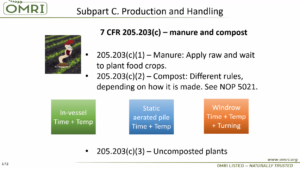
DC: 205.203(c) – All about manure and compost. Composting manure will mitigate risks with raw manure application. Raw manure application is part of the standard.
203(c)(2) – talking about compost – there are different rules, and that is in NOP guidance that goes further and talks about other methods that are not included in the standard, but are based in the standard.
These are a few methods that we see when we are talking about compost.
203(c)(3) – Uncomposted plants.
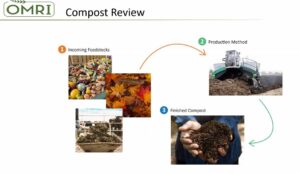
DC: Terminology is really important, so I want to make sure that we are all thinking about terminology in the same way.
Looking at presence of contamination, too. We have a reactive system, but we also want composters to have a contamination plan, so that we don’t have to react. Added this slide to show compost and compost-related products.
Content there after the number is our genetic materials list. 183 are in compost other category. Compost other is what’s in the guidance. 50.21 guidance. Compost tea and inoculants – variety of different products on our list
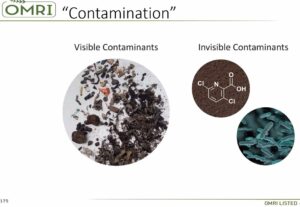
Visible include plastics and glass. Invisible contaminants like paraquat. Several known persistent herbicides. Can’t see them unless showing up in plant growth. Can talk more about “contamination” but its a term subject to interpretation. Examples of what we consider contamination.
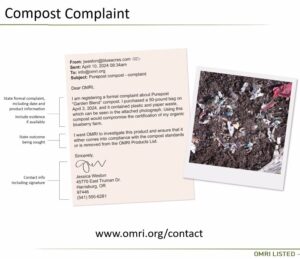
We have a complaint process. This is a fake letter. Real photograph taken from a complaint. Requirements that we have to have a formal complaint, just noting what those are – all in our policy manual. Putting this in here to acknowledge we take complaints seriously.
Wanted to end by noting we have a robust web search and we have a lot about compost.
Dr. Pat Millner, Research Microbiologist, USDA, Agricultural Research Service
Dr. Milner: Focus on compost process – differences and terminology used over the years. And then will move to microbiology that motivated process standard and testing requirements. WE want composting beneficial in agricultural endeavors.
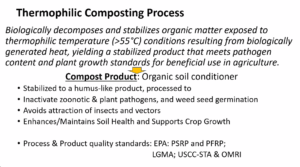
The compost product that is generation should be an organic sol conditioner. Should be stabilized to a humic-like process. Clean of zoonotic processes and plant pathogens – and any errant weed seeds. Should avoid attracting vectors and insects – goes to oders and volatiles If we want all those things to come out we need a variety of different measures. These standards have been developed over time with the help of EPA research. Two diff ratings: 1. Process to produce basic compost requirements and 2. one to accomplish further composting process.
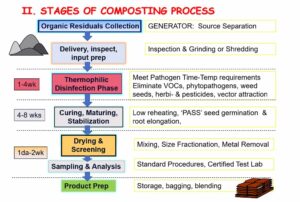
Are there some standards for home composting? I’m not aware of any for home composting as in your backyard. If someone knows of some, I’d be interested. For larger, industrial type composting, these are individual steps in the process (see slide).
So there are different standards for leafy greens. Some standards – The FDA has FSMA standards for example. All have individual requirements – some overlap – depends on jurisdictional location. All for reference [see slide showing rules guidance].
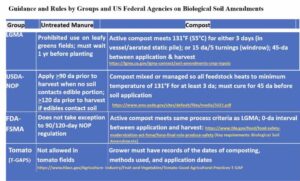
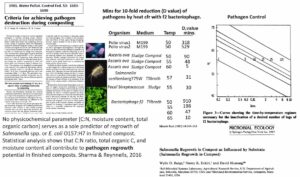
This was based on variety of research. Newer microorganisms that people are paying attention to in different production systems. Back in the 80s had support from EPA regarding their rules about composting sewage sludge. So you’ll have this info to consider – variety of different methods to determine when and how much temperature they need to reach in order to insure pathogens of concern are destroyed. You can see and refer to them [visual temps slide].
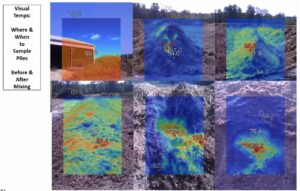
We’ve used infrared technology to profile different temperature and effects of environmental conditions.
Things that haven’t been so compostable and are now under review – sticky labels on fruits. That label has a lot of meaning. We now have consideration on how to make those labels compostable. Big picture: ag exports go all over the world. EU has recently looked out how to improve compostability of these sticky labels. The EU considered whether they could be made into something home-compostable. We don’t have a standard for home-compostable the same way we do as industrial-type. There is a need for compostable products – these products getting into commercial composter there tend to be too many of these labels.
The process to date is testing the stickers in progress and testing formulations.
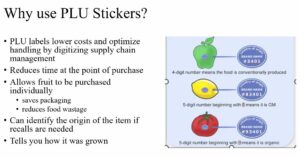
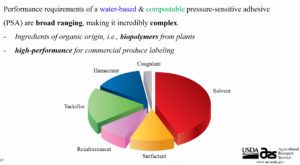
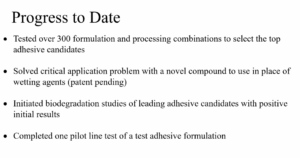
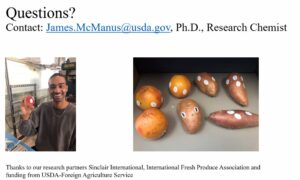
The PLU stickers will allow the organic community to re-invest into new varieties of products. Hopefully the new stickers will allow packing for more information and allow for more traceability.
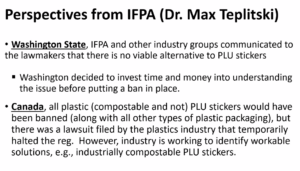
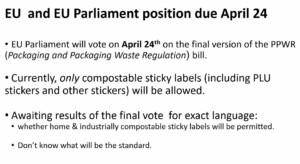
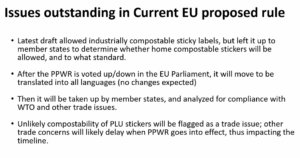
Matthew Cotton – Integrated Waste Management Consulting, LLC
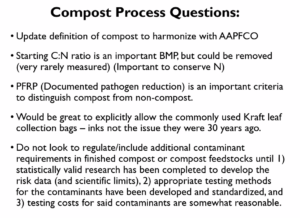
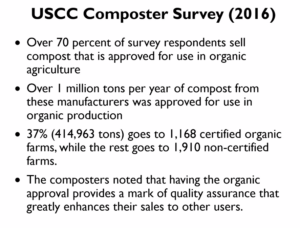
MC: PFRP working fine. Market can always go beyond it. Organic market is very important to composters – especially in CA. We haven’t re-done this study or survey since so it may have changed some. But being allowed in organic is important and the quality-assurance step is really valued.
There may be additional composting sites. There are some that we do not count. There are less than 200 that take food, and less than that take compostable plastic.
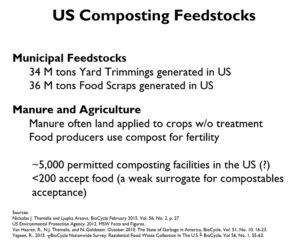

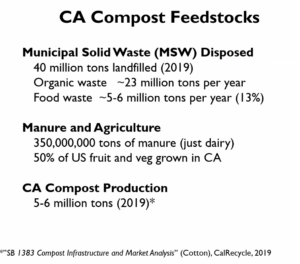
Again, this is permitted facilities – we do not count all facilities. Do not count composting on farm. This is pre-pandemic #s, but would guess it is greater now. More goes to the process to become allowable for organic than not. If you are making a claim in CA that something is suitable for organic, you have to through CFA, and you’re probably also going to do OMRI.
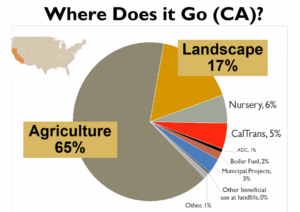
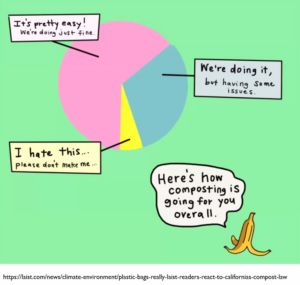
Like what graphic was saying. Largest curbside collection program of organics. Bags get pulled out and land filled.
Three giant bills in CA. 1383 written in 2016 – food scraps – super ambitious.
1201 – define compostability – specifically for compostable packaging.
54 – really trying to get at single use packaging.
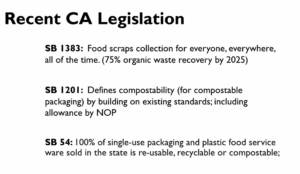
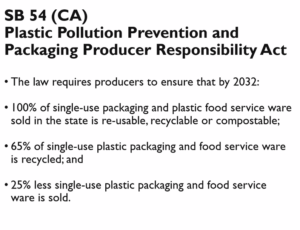
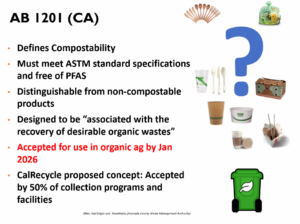
In CA, we have aspirational goals, and we take climate change seriously. If we do not meet one goal, we set a higher one. If implemented as written, there will be a dramatic change in how plastic is sold in the state.
NOP should do what’s right for NOP; CA will be fine. There will be plenty of compost to go around. You guys can do absolutely nothing, and it will be absolutely fine, but we will be talking about this for some time, I’m sure.

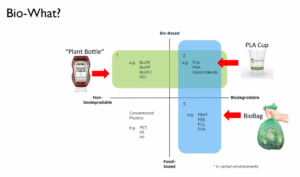
You cannot expect the average consumer to look at these cups and make the distinction and put the cup in the right bin, even if you have the right bin, which most people do not. Manufacturers are trying to make things that look just like what we currently have, because they’re trying to market it as a replacement.
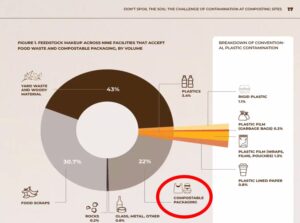
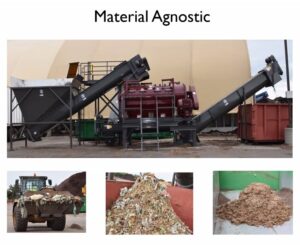
That machine installed like that costs almost $1M. No one is buying this for plastic, they are buying it for all of the other stuff that Americans cannot sort. A lot of the food gets wasted. Composters do not have the time, inclination, budget, resources to sort this stuff. Some of them do, but it’s a lot to ask a manufacturing system that is taking a waste product and trying to do something with it to hand sort.
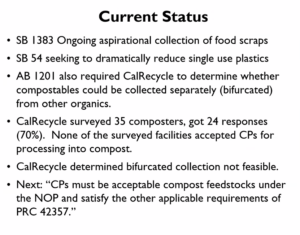
This means that they either sorted them (compostable plastics) out one way or the other, or they do not want them at all.
Tim Dewey-Mattia, Recycling and Public Education Manager, Napa Recycling
TD: We are a hauler, recycler, and composter in CA. A lot of what I will talk about will be working off what Matt was just talking about. There is a lot that we are doing in compostable plastics – these already existed 20-25 years ago. There is a lot of confusion and discussion that goes on around this, and this is a really important part of the process ight now that we are coming to some type of decision that will provide us in the work that I do with guidance on how to run our programs.
MJ: Would you make distinction with organic waste?
TD: Good point – big O, little o. We use the word “organics” as carbon based products, but you use it differently. We try not to talk about “organics” as food scraps in our trimmings. We often are talking about “organics” for carbon-based products that are being discarded and made into new things, one of them compost.
We [Napa Recycling] operate publicly and privately operated – hauler, recycler, composter. We are dealing with three of those portions.
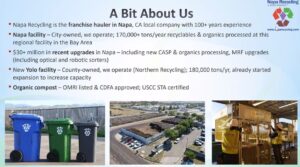
We’re not a landfill operator, so we’re trying to work with a lot of communities, hit all of the mandates from the state, and bring in more materials to make things, especially things that can be used in organic ag. Napa facility – small – 22 acres – right along San Franscico Bay.
Yolo County Facility – public-private partnership. We filled this up immediately and are expanding to another 100,000+ lbs per year. Shows you the demand in CA. We have markets for the compost that we can produce.
Trying to bring color schemes into a universal use. We are trying to figure out what goes where – if there is something that not all of our customers know what to do with it. For food scraps, we accept all. We accept the paperware. I do think we need more guidance on paper, as well, such as pizza boxes and takeout ware. What is the guidance on what is acceptable?
We have a lot of green waste in CA, with year-round collection. There is a lot more brush trimming happening to try to help with fires. Food scraps are mandated.
For commercial loads, where see de-packager, you see a lot of green bags – certified compostable. And then you see some packaged food straight from industrial food provider that never even made it to the stores. We got grant for de-packager. Lose about 20-30% of food scraps, but removes packaging.
Static pile – doesn’t move. There are blowers that blow through under the concrete pad. This is becoming the kind of compost that is required if you want to compost food scraps, deal with pathogen production, and such. We run through 5 different points to remove contamination. Biggest contaminant is plastic bags. Plastic is a problem and we are trying to deal with it in different ways. We have hand sorting, and could possibly use robots to do that in the future. “Overs” is stuff that is bigger than what we resell for compost. The stuff that is bigger – wood, bones, plastic – off to a landfill as landfill cover. We would like to try to reduce that number. We send a lot of organic material to the landfill that we would like to put back into the soil.
Nut tree orchards are our biggest market, and almost all from Yolo goes to these. Napa is a very diverse market.
We sell $14/ cubic yard. Some are higher end. We’re doing municipal material. Market can handle more compost and we’re trying to add that back into the soil.
We are trying to hit these mandates and divert foodstuff from the landfill. We are trying to help everting make more sense for consumers, and put plastics and packaging folks in charge of figuring out what to do with their products. We put a lot of work into education. We have some challenges. We are trying to divert more food scraps and have less single-use plastics.
We think liner bags are useful. We do not want to replace single use plastic. We have to look at what to do in CA and alternatives to collecting compostable bags. Hopefully reuseable.
QUESTION & ANSWER
BC: For Matt, a lot of this went by me, you had a slide that compared dairy manure versus food waste. Could you go back to the slide or talk it through?
MC: I believe I got that number from the Internet, and I believe it’s 350Million tons of manure.
BC: I don’t think there are more cows than people, but maybe. Key thing in my mind was comparison 350 tons and other category.
MC: We generate 40 million tons of garbage and 50 million tons of dairy manure. We compost a fair amount of that manure, but we don’t always track it very well. CA is a very big state. We have a lot of materials to compost.
BC: Of the usable waste stream, what are the proportions? Apparently the dairy manure is huge and are we wrestling the whole system just to deal with 2% of waste stream and an even smaller percentage is this compostable issue.
MC: Let me commit to verifying that number on how many cows we have and how much manure they generate. It’s an enormous state and we have the world’s largest ag production. We are going to ban open burning the in the Central Valley AGAIN, because we still burn a lot of stuff. Biggest thing we burn is grapes. There is a tremendous amount of organics that we could manage differently. We have a vast ag production. A very good researcher at UC Davis, Michelle Russell, described composting as a fairly niche.
Far more farmland than compost. We have incentive programs to use compost. We won’t have enough compost and need to do more.
TD-M: On those numbers, the dairy manure is managed in a separate system from how we manage municipal waste – yard trimmings and food scraps. When we say that organic stream is 50% organic waste, that doesn’t count manure. There are ways to use all of that compost.
MC: to the ratio question, the reason CA passed 1383 is because food waste in the landfill degrades anaerobically and creates methane.
AJ: Is the availability of organic compliant compost in CA limiting the growth of organic in CA? Do we have enough to serve a dramatic increase in organic production over time.
MC: Awesome question. Don’t know the answer. We have a lot of compost. We’re about 6% organic in CA. Access to compost, if limitation, is that it is heavy to move. It’s more of yelp problem not a supply problem
AJ: Tim, I heard you say that you are pulling all of the cups that look like “this” out right now because they’re not allowed. My understanding is that a lot of facilities pull out anything that looks like this cup because we cannot tell the difference. It seems to me that would still be an issue if we added composted plastics to the list. Can we go paper? It seems like adding the plastic to the list wouldn’t completely solve the issue. I’d like feedback on that.
TD-M: Asking a good question. If things were in a perfect world, we wouldn’t have conventional plastic contaminating the stream. We have done studies on compostability. We have to pull them out – can’t allow them for organic production and can’t make 2 types of compost. The other part is that they are going to get pulled out anyway b/c they act like plastic. But we know a certain amount is in the end-product. I rather not have pieces of plastic in compost. You’d rather have something that degrades. Something needs to change and why we’d like to be able to use compostable bags.
In the long run, hopefully nonrecycling, non-compostable plastic goes away. It’s not good for anything. There are ways to use reusable. But there are also going to be some single-use products that are going to have to be discarded, and some of that should go to compost and some to recycling. Single-use cups are problematic. I do think there are certain uses that we see as beneficial – fruit stickers. I think it’d be nice if they just had glasses, but maybe it’s not okay to use PLA plastic for that cup.
You have a very unique place with USDA. Our policies in CA are different and unusual. It’s tricky your decisions on what to allow. There is a lot of nuance that goes into it, and that’s why you see facilities deciding that they don’t want to take it and deal with it. We don’t want compostable shoes, car bumpers, all of the plastic in the grocery store to go to compostable plastic. That’s not a solution.
DN: Clarifications – Dr. Milner – Now there are some GM bacteria – will they go away with high temperature, or are you aware if they will still be there when processed in recycling. On C:N ratio, have you done any study on your recycle when you make organic compost?
PM: As far as microbes are concerned, I am not aware that people are adding GMO-type strains to inoculants. I know that there are a number of inoculants types that are available, but I’ve not heard of any GMO. If you’ve heard of them, let me know. As far as what will survive, definitely bacillus. The other thing to remember about microorganisms that come to the situation naturally – there are a whole lot of microbes that come into this. There are innumerable that start and finish. That’s not unusual. You want them to remain there to continue doing what they do in terms of degradation of organic compounds. Biggest thing to remember is that when you’re trying to get rid of pathogens, you’re dealing with tons and tons of material, and your analyses at the end of that process are as good as the number and quantity of the number of samples you are able to analyze. When you take that into account and you’re looking at a risk analysis, there is no 100% chance that you’re going to eliminate everything. It’s acceptable risk – that’s what your target is. You’re not saying that it’s absolute.
DN: Are there still spores there at high temperature?
PM: Correct.
MC: Talked composting last 18 years and he would tell you C:N ratio is really important. I don’t find starting C:N ratio that helpful. I much rather people focus on air flow, moisture content, pathogen reduction. Would rather them send C:N ratio on finished compost.
TD-M:: have to test if for this reason to be OMRI certified – send a finished compost test. Your inbound feedstocks – challenging and don’t know if it’s really accurate of a huge pile.
TD-M: We have to test it every once in a while because it’s part of the requirements to be OMRI or CDA. I don’t know if it’s really an accurate test. Representative of a huge pile is very hard to measure in a way that is useful. You could do one test sample, and it’s so much lower. It doesn’t have any effect on our finished test.
MC: Compost is a really forgiving process. If your C:N ratio is so out of whack because you’re not getting to temperature, you will know. I’ve been teaching week-long composting classes across the US for years, and it’s not something we’re talking about. If you only had a budge to do one test, I’d much rather see that test at the end of production. The science is there. It’s a good BMP (best management practice). The final slide of our presentation is about the C:N ratio, but having it in the rule isn’t all that useful.
PM: if another inoculate, bird flies over, or fox visits the pile and that brings salmonella in there, doesn’t mean it can’t regrow. Depends on moisture content and soluble nitrogen and carbon. To regrow needs soluble carbon. Listeria, E=coli have very specific requirements. It affects the end-quality product, and then what happens when you apply that to your end-product production system. Whatever is in that soil is going to see those pathogens, too. If it sees soluble carbon, it can regrow. What’s the most obvious source of soluble carbon in that soil where you have your plants? The roots. They are constantly exuding soluble nutrients that we know material love.
AB: First question to Doug and Pat – continuing on with the testing and research – OMRI requires testing. We mentioned leafy green marketing agreement. Is that something that we should look to mimic and update that piece for food safety?
PM: for leafy green production, herbs, cantaloupe where we know there have been incidents of recalls and food born illness outbreaks, there is a whole system – whole process that they use. Some studies show it’s about type of cultivation b/c it can throw some of amended soil up onto the plant and it gets into the core of say romaine lettuce and remains there during the whole production system. Can take this into account in different production systems. They have seen it in action in CA
AB: Appreciate that.
KS: I think I heard Matt in his presentation say “you do you, CA will figure it out.” My question is for Tim. Come January 1, 2026, what does that look like for you if we keep things the same?
TD-M: If nothing changes and the rules ae the same, any paper that is not recycled paper wouldn’t be allowed to be compostable. That paper cup could still exist in CA for a little while, but it wouldn’t be able to have the BPI logo on it, or anyone else’s logo. And then in the next 5 years, it will be banned by SB54, the packaging law. What will happen to us as a recycler or composter, we will have to figure out what we accept, and we won’t accept these things because they won’t be a compostable item anymore. So all of these things that are compostable products will probably go away. That’s my guess. It will be interesting to see how it works out, but that’s the most obvious.
NPP: That was my question. Matt, is there a conversion factor for how much manure becomes compost?
MC: Good question and clarification. I hadn’t looked it from that perspective. I do not know what organic growers – again, massive state, and we have organic growers all over the state growing things in all different ways to amend their soil and provide fertility – and there are plenty that use manure and plenty that use compost from facilities. This affects, today, 35 or less facilities. There is the opportunity to divert more food scraps. Literally, 1383 is not universally beloved throughout the state. There is a great editorial that talks about the increased availability of food scraps will drive the price of compost down, and that’s good for farmers. I expect the availability of compost to increase.
We tend to put these materials in certain silos. If it went to a landfill, then we didn’t worry about it. If it didn’t, then we did worry about it. We should look at the big picture. I think the manure is more managed because most of it is already in the ag area – dairy adjacent. The range of organic production in CA is astonishing. I do not think it is an either/or, it’s a yes/and. We are going to compost more food waste. We are putting compost on range land, which is something we didn’t talk about 10 years ago. We are doing more research than we’ve done in years, and primarily that is due to climate change. This is a small detour on that road, but it’s an important one. A lot of this material is going to go to ag, organic or not.
Again, you only know the space that you’re in. There’s a whole part of 1383 that deals with dairies, and I don’t know much about it. There’s a whole part about reducing carbon black, and I don’t know much about it.
NPP: Is there a reason in thinking about where compost goes that it has to go our food? Why do we have to divert something that’s concerning right to the source of something they are going to re-ingest.
MC: I have no idea what the answer is. I guess we don’t. That data that I showed in CA from 2019, that is unique to CA and does not apply to other states. In most cases, we don’t. Do we need to? No. Does it provide a great source of stabilized organic matter. Yes. I think we could have banned all organics from landfills just for the water-holding capacity alone. I think the risks are real and we face them with science and the generally do not prove to be fatal. Pat knows way too much about pathogens and leafy greens, but the outbreaks of some of these E.coli scares and such have nothing to do with compost.
NPP: Concern more about the plastic than the PFAS.
PM: the Dept. of highways in different states use for renovation of slopy areas. These socks that people use to collect wash-off before it goes into an open waterway.
NPP: If we could have re-written 1201, not that it gets banned if it can’t go to organic, but there’s nowhere else for it to go. Is that right?
MC: If 1201 being what it is and NOP decides to do nothing, we’ll continue to make compost. Where it goes is a function of the markets. What 1201 is acknowledging is that composter was to sell to organic. No one is required to buy or use any compost. It’s the single most successful thing we’ve done in recycling.
TD-M: We talk about PFAS, which isn’t allowed in any food-contact material. Something could get in there that is illegal, but it wouldn’t affect PFAS. Theya re banned from all packaging as well. PFAS is allowed in nothing.
MJ: Matt and Doug – Doug in comment there was comment about wind row 15 day requirement. 15 consecutive days, seems like a barrier. Doug, could you unpack written comment?
DC: Any compost that is marketed as windrow compost is going to get that 15-day and 5-day turning. If It’s not marketed that way, then it can go into the ”other” category with 3 days above 131 degrees F. There are 184 products in that “other” product, and much smaller numbers in windrow, and they’re only there because that’s how they are being marketed. Same is true for static area to pile.
MJ: Is it generally consecutive days – the requirement? So it’s 3 days in a row at 10th, but it doesn’t have to happen in 15 consecutive days.
DC: 3-days, yes. 15-days, no.
MJ: 3 days in a row at temp, 5 different times, but does not have to happen on consecutive days.
DC: We require consecutive for 3 days.
PM: Taking a sample after the turning is very good, because it all gets mixed in and you’re not just taking from isolated spots.
FQ: Trying to put my finger on main motivation for this. Is it a way to find outlet for compostable plastic or is there an actual need for it? Is this going to add another purity test?
TD-M: For us it’s a way to make less plastic and get more food scraps. Certain usages better alternative to conventional plastic.
MC: Tool that some manufacturers use and that using liner will get more people to compost food. Not enough places take them. Probably more of a hazard than a benefit than composters. Majority of composters in CA don’t handle food.
WT: Tim and Matt – do you have any insights on money spent in composting world to handle contaminants? Curious about magnitude of handling of materials that are theoretically be handled by that system. Given up on recycling in this country. I’d rather us deal with plastics with recycling and leave this stuff alone. Am I right?
TD-M Haven’t invested enough in it. We’ve invested tens and million of dollars in last decade to upgrade operations. A lot of weird plastics in there. When you go through this, there are certain things that will never be captured in recycling. Realize when look at recycling need to figure out the posting. We need to try to reduce contaminants and know certain things will exist. More of a chance of us doing something with them in compost. We need to get more of big piece of pie in compost instead of landfill.
Not up to us to spend more money on solving their problems.
AJ: Folling up on cups and paper like pizza boxes – are any of those allowed; are there any paper products that are currently okay on the NL?
DC: There is other recycled paper component on the NL. We look at waxed paper cardboard and cardboard with glues and plastics – pizza boxes. The “other recycled paper” is looked at liberally.
AJ: “Contamination” – I buy organic compliant bulk bagged – it all has glass in it. What is the threshold level?
DC: One thing I didn’t talk about is our feed sack removal – we are identifying some things as high risk – municipally collected yard clippings, food scraps – we are requiring sack removal. We are asking people to describe how they are removing these contaminants.
Not 100%. Also see people screening. Screening final compost. Also a method. When we get complaints we are following up with corrective action plan. So if someone is finding glass, bottle caps, they can tell us so we can work with company o find source cause and what to do about it. Not perfect. Bigger composters have very small targets for contaminants but they are still going to be there.
AB: Matt, you mentioned retailers are incorporating more and more compostables in what they sell. What is the percentage for the push for certified compostables? I haven’t heard much about this.
MC: I don’t know. Rhodes (unknown name) Rom BPI would know better. BPI has taken a lead in trying to police the industry. Alot of these companies are international chemical companies. Like Nature Works, a subsidy of Cargill, just makes the resin. We don’t track this very well. EU does, but we do not.
DC: Question for pat about sense of timeline of compostable fruit sticker? Pipe dream?
PM: Couldn’t get a sense from talking to Dr. McManus about a timeline. Close, but wouldn’t commit to timeline. Technical obstacles but optimistic.
MC: Quick comment – just because you can make it doesn’t mean it can travel through our system and we can deal with it. It will be great if USDA can make and provide and opensource for that, but then you have to convince everyone to use it.
NL: First step is making it; second is getting people to use it. If we get to these milestones and we have something that is functional… Seattle has played around with a ban in non-compostable fruit sticker. What happens then?
DC: I think it comes down to agreed-upon allowance for food waste. Knowing those are going to be in there and being okay with it.
NL: Fair enough.
PM: I would add that Dr. McManis is working with a commercial company, and they’ve told me that they have been working with a company and they see this as a resolvable problem.
NL: Encouraging. Take to hear that we need to take to heart whether to allow it into our system or not.
DC: They might get screened out, they might not. Food waste is allowed and the [stickers] are coming along for the ride.
NL: Thank you to our panelists.
Crops Subcommittee (CS) -Logan Petrey, Chairperson
Proposal: Carbon dioxide -petitioned
LP: Petitioned in late 2020. In Fall 2021 we classified it as a synthetic. We got a limited scope TR in 2023. One commentor (QCS) noted that one greenhouse producer is using it. Some producers (greenhouses) are saying it would make a big difference in yield so it would be used if it’s listed.
8 written comments – 4 in favor, 4 against. Those supporting said that GH producers would greatly benefit and would help those transitioning. When I questioned one commenter, they said they could probably get comments from producers if we were to kick this, but we currently do not have any comments from any producers right now.
QCS certifies one greenhouse that uses non-synthetic when available. But they have had other greenhouses request its use.
JD: We’ve had good discussions and it’s morphed a bit. When say greenhouses you are confronting a long standing issue of how they fit into any of this. Not important for this conversation in my mind. As a greenhouse grower for 25 years, the benefit of CO2 was measurable in doubt digits. On a calendar year, most of the benefit was accrued in the winter time. Long enough ago when organic seal wasn’t even available.
NPP: Jerry, when we are talking about essentiality and what this means to GH growers, you’re saying at least 10% – what is that? Improvement of what?
JD: Improvement of yield-per-square-foot. Often with heads of lettuce. The leaf itself as thicker, the color darker, better than what I could get at that time of year.
NPP: Logan, could you summarize for us what the concerns are as you perceive them in public comments, written or oral, or from your research.
LP: The concerns – the unknown, what could it be used for. There wasn’t any use in the petition that it would be used in a certain manner. Most of the comments supported crops subcommittee decision. Relatively benign byproduct. When producers didn’t come out in support of it, it kind of lost steam.
LP: Jerry, when you mentioned the yield growth and cold. Just explain to the Board, to fix the CO2 issues, you would open up and vent. Not good to do when really cold outside b/c lets heat out. When it was warm outside, did you have these issues? Did you still use it in that time or did you just vent?
JD: I vented. One statistic that will help evaluate the question – in dead of winter I’d have a turn of my crop would be 49 days, during summer is 19 days. Solar influence.
NL: This substance – focused squarely on necessity. Why I voted “no” in subcommittee was around necessity. This seems like a solution to a challenge that can be solved by venting. Controlled Atmosphere Production (CAP) – they are choosing this and there is plenty of CO2 around – too much in fact. Not a good enough reason to allow.
JD: First, the single biggest cost to growing in a GH, to my experience anywhere in the world, is heating the GH. If your choice is to open up the vents and turn on the fans in December. What you have done, regardless of the growing system being used, is dramatic. You and I have already had the conversation on CEA – Controlled Environment Agriculture. I was using hydroponic systems so I’d have to accept your argument. The growing system hasn’t been addressed.
FQ: Given the fact that CO2 is one of the most important GH gases, if we are harvesting it as a biproduct and use it in a GH – the science is clear. But if folks are going to produce CO2 just to do this, that’s an issue. Only 60% would be used, and 40% would be lost. It’s already a GH gas that is a problem.
JD: Interesting – we are no longer in subcommittee anymore. The incident of CO2 was a byproduct of heating greenhouse, so choice was venting to the outside or to the greenhouse. For me, none of these questions came up. I do not know that these questions are highly relevant to this conversation. Needed to heat greenhouse and made the choice to vent into greenhouse – boosted CO2.
LP: There is no CO2 that would be produced for this use, it’s all byproduct. Not adding to CO2 issue.
BC: I’m conflicted about this. I really appreciate Nate Lewis’ point about essentiality, and the fact that basically our canvasing of stakeholders was split 4:4. I’m wondering if this needs another look in an attempt to get more GH growers themselves to respond to the question? My gut tendency would be to send it back to the committee for another round.
NPP: I support that.
JD: Awkward to be a champion. Won’t be that for CO2 in greenhouses. My question to the entire BOD is: why not?
LP: I’ve asked that same question. Are we just continuously adding materials? But if it is a good toolbox for that… I agree with Brian, because commenters were split and hoping to get more comments from producers.
MJ: Cautious with necessity and container issue. I don’t think if we passed this we made a good case for it. Support going back to subcommittee. I don’t think I can say yes, especially process-wise.
CD: I’m not saying send it back or not, but I do think it’s telling that not enough farmers answered. I think that is also an answer that they didn’t think it was worth responding to your call for questions.
AB: Appreciate Logan’s work. There hasn’t been a lot of info on this aspect of the listing. This substance has been around for while. We reviewed one part a few years ago. Not a lot of expressed need for this. Not a strong case for use in this specific way. What was the reason for the listing?
LP: Because of its use in irrigation water or sprayed on leaves to adjust the water PH, the assumption was that it was needed to be listed there, as well, because it would get into the soil during irrigation water.
AB: We spend a lot of time trying to find data points on the need for this and found very few. It just doesn’t seem like we’ve heard enough information there.
AJ: Share Franklin’s concern about new CO2. Have a hard time making a decision on this without doing it in the context of container systems. Hopes that we start to move on container systems before.
LP: If we voted it down here, would that jeopardize it for container standards if we worked on them in the future?
KS: Unless there was new information in the re-petition, then it wouldn’t be allowed.
JD: The petitioner is a container grower?
LP: Petitioner is a manufacture of the CO2.
JD: Why not – kick it back. I will abstain from vote. I think we are blending 2 things that should not be blended.
NPP: We never hear from transplant growers, and I thin that’s a whole different bucket. How do we get them to show up? That’s a big outreach issue. I don’t think we’ve ever heard from them. I’d be curious to see how much outreach we could do to hear from those folks that might need it or have the most stake over the next six months.
KS: One of the public commenters did address Allison’s concern. There’s something that we put on the NL all of the time before we have standards for them – such as apiculture. Whether or not that is good precedent is debatable. I am feeling conflicted about this material. I hear both sides of the argument. It is allowed in processed products, it’s in the air we breathe, but then we’re concerned about allowing it in crop production. I’m fine with taking it back to discuss it more.
FQ: Main question was whether there would be new production of CO2. Nothing wrong with using what we have – something wrong with creating more when it’s a greenhouse gas.
KS: My understanding is it wasn’t petitioned with a particular annotation.
NPP: I would like to make a motion to send this material back to subcommittee.
KS: Second from Brian. Simple majority vote.
- VOTE: Yes: 13, Abstain: 1 (JD). Motion carries to send it back to subcommittee.
2026 Crops Sunset Reviews
Hydrogen peroxide
WT: Irrigation systems and plant and disease control. Straightforward. Consistently over time this material and use has gotten support from the community. Hearing from a wide-range of the community. Notion that it is safe useful sanitizer is an important consideration as well. Continue to talk about sanitizer toolkit. Not a controversial material. Welcome comments.
No comments or questions.
Soaps, ammonium
AB: Been approved for various crop uses. Focusing in animal repellants to protect from deer and rabbits. Canadian standards allow as repellant. EPA soaps gives it lowest possible toxicity. Undergo rapid degradation. One thing to highlight – highly toxic to crustaceans. There are other means of pest prevention – population control, fencing, natural substances such as coyote urine, human hair, black pepper oil. Asked if still need for soaps and there were 10 yes – used in tandem with other tools. One certifier said the listing on OSPs has gone up. One comment against it. Concerns about drift b/c not supposed to come in contact with soil. A couple of groups took non positions. Overall, not controversial and farmers expressed need for it to stay on list.
No comments or questions.
Oils, horticultural
BC: Listed in 2 places [see materials review]. Petroleum distolates and clearly synthetic, low toxicity to terrestrial organisms but very toxic to aquatic organisms. Used for insect mite and disease control. Exempt from residue tolerance by EPA. There are oils that can provide a similar function that are natural – soy, canola, neem – that would be a natural alternative. We asked about alternative from stakeholders – responses said they were more phytotoxic or not effective. The plant-derived materials are probably more quickly biodegradable than mineral oils. This is in our research priorities – we need more research. Products are allowed in other organic systems – one of the most common pesticide products used in organic worldwide. Most of the comments were in favor of listing, including certifiers counting who is using products. One said they should be de-listed unless there was an annotation for only essential uses and worker safety. One producer said One grower responded that wasn’t necessary, but always outliers.
Very strong support within producer community and my minor caveat is that we should be investigating some of the plant derived similar materials.
No comments or questions.
Pheromones
FQ: Synthetic substances for insect pest management. Volatile chemicals that insects use to communicate between themselves – danger, mating partner, where to find food, where to relocate colonies. Communicate in various ways. We exploit this communication to manage them. Different ways of doing that – it’s a passive crop and insect drawn to it. It doesn’t get out of passive trap. Other methods where active movement involving spray. These are some of the differences in how it’s deployed. Synthesized as acid and alcohol – it is an ester. International acceptance – allowed for pest control in Canada, EU and IFOAM, Japan. Passive, active, automatic dispensers, various ways. Few health environmental issues – asthma, cancer – but don’t get into contact with the material. Various ways deployed. Support for relisting. One thing is important to note that when regulations – formulated with inerts, slow release, but if going to active trap way, pheromone where it is being moving, cannot used inert that is at least 3 in it.
WT: Did you say anything about public comment?
FQ: General comments are to accept it.
Ferric phosphate
BC: Commonly used material – controlling slugs and snails and spread on soil surface. Only about 1% of product is the active ingredient, 99% is inerts in these products. In this case it comes up more strongly because in the past when this is reviewed – concerns that EDTA, chelating agent – there is evidence form research that iron phosphate and EDTA are combined it increases toxicity for earthworms by 100. They are a proxy for other organisms. Other inerts – you spread the granules out – like candy to attract slugs. The TR is pending to see if there is more research because it’s controversial. Manufacture claims it is effective without the chelating agent. So we could re-list with an annotation saying no chelating agents. Allowed in many of our worldwide organic partners. Written comments: hundreds of users in certifier, 11 in favor of re-lisitng, 1 in favor of de-listing.
AB: Mentioned about manufacturer didn’t say kelating agent was important for effectiveness. How about for manufacturing process?
BC: Great question. Looked through petitioning materials and when safety for soil organisms came up, the manufacturer sent another batch of documents. I didn’t see anything that using the chelating agent was necessary. The other reason for the agent like that would be to hold the iron and phosphorous in those states through rain events and keep in ionized forms. I don’t know exactly the reason.
Potassium bicarbonate
JD: Plant disease control. This is informed by 1999 TAP and 2015 TR. Safe and benign when used at recommended concentrations. TR was limited scop gave strong support for effectiveness of disease control. Safe bet that it will have full TR review during next cycle. International – fully onboard with international partners. During 2015 review, stakeholders were questioned about alternatives. Producers responded that alternatives available, but with their practices it was essential. For current period, about 22 written/oral comments – most strongly in favor. 1 questioned classification. Powdery mildew prevention.
No questions or comments.
Magnesium Sulfate
FQ: Last TR in 2011. Focusing on its use a soil amendment. It helps seed germinate, aids in production of flowers, etc. Can be obtained naturally. Allowed in CA when plant and soil deficiencies are documented, as does IFOAM. EU: has to be of natural origin. Health and environmental issues not likely with qualities used. Will not persist and cause problems. Public commentors said it was important for fruit tree, high house, greenhouses. Dolomite not a suitable substitute because it increases the PH. One commentor said it should not be used in place of soil building practices.
JD: Any direct responses to questions about practices and methods?
FQ: No
BC: Reviewed magnesium sulfate as livestock material and just wondering if we should both ask whether there are natural sources that could be used for these purposes or commercial availability for it?
FQ: Dolomite is a natural source, but will raise the soil pH. Going to be a problem if pH is already high.
AB: Echo importance of this substance for farmers – it does help for nitrogen utilization. We need balanced soils, so don’t need to put on as much manure – when too much magnesium it makes for tight soil. If we can find natural sources, critical but in general farmers need this.
AS: We also have this on handling as a non-synthetic. We should talk about tomorrow.
Hydrogen Chloride
AB: Did request a limited scope TR for this substance. It was mainly looking at alternatives. And for cotton seed de-linting, essential for mechanical planting. Internationally, this substance is not explicitly mentioned in other standards. When look for human health and environmental issues – major health affect is local irritation. Petitioned in 2002 and added in 2004. Reviews have been supportive of relisting. A good portion of conversation has been looking to alternative natural practices. Not an incentive for companies to develop b/c of market size. Comments – 3 supported relisting, 1 certifier said zero producers using this, but shouldn’t be removed b/c it is crucial for cotton seed. One commenter said should be added to research. Trade group mentioned aware of sulfuric acid using to de-lint. Understanding is since note of cotton planting being treated with HCL, then listing not required. Original petitioner said really probably don’t need it however the listing would be critical if organic cotton seed available. Curious how India handles this. India is a major exporter of organic cotton. Although this isn’t needed currently, it could be.
NL: Details to add to conversation –looked at this ion 2014 – visited ARS research facility. Encouraging to hear they are moving in right direction. Industry does not want to use harsh chemicals to de-lint seeds. One barrier is seed houses that use this substance are not certified facilities. Farmers can “catch their own seed”… but you can only do that for a couple years then you lose quality and need to go back to other breeding lines. Lack of certificating of facilities meant seed couldn’t be used for organic. In India a lot of seed was planted by hand by small land managers – they were planting fuzzy seed. Mechanical limitation – you need it to be de-linted.
AB: sulfuric acid is used in conventional cotton seed production. Very helpful point on India aspect. This is necessary for mechanical planting.
AS: Aware of one organic cotton grower in CA and post-harvest infrastructure isn’t there in US anymore. Hopefully will start to see that infrastructure rebuild. Keeping on list is one less barrier to growth of market.
CD: Lack of knowledge of science. Confused when you started talking about hydrochloric acid – I googled. Maybe make that more clear when you revise it.
AB: Skipped over use and conversion. Spelled out a little more in the write-up. Will provide more context next time.
Ash from Manure Burning
LP: Nonsynthetic. Petitions to annotate in 2014 and 2019 – these didn’t pass. The use is as soil amendment. The carbon is important to soil and burning it off may not feed the soil. Discussion that there isn’t enough manure now, so burning it seems a waste. No human health or environmental issues. Because of the burning off we don’t find it compatible with organic systems.
WT: Don’t regret asking for the TR for biochar. Fascinating reading.
Sodium Fluoaluminate (mined)
MJ: Comments cited issue of public health and no one has reported a need for this material.
LP: That concludes the Sunsets. Moving back to compost.
Discussion Document: Compost Production for Organic Agriculture -petitioned
MJ: Excited about discussion. Started discussion with support from NPP. We worked on work agenda item. Nate Lewis helped us. Following summary: massive universe out there. Wanted to find out everything we could. I have every question and comments catalogued and this will inform what we do in crops. We are committed in making recommendation to Board rather quickly. 205 and 203 definitions and NL. Will be good in context of NL to look at those packages and we need to give crops direction. Unpackage those areas to get some clarity and knock out some low hanging fruit to establish clarity for crops. Then work on the big issues. In sense of 205 and 203 we added an additional method. Look at question 1 – suggested additional method. Had questions about 15 day interval and think we have some consistency and clarity issues to do. We heard from a material review folks they liked our language adjustment. Talking about static pile, wind row, and container methods and that we might want to consider other. Comments gave us clear direction. Any questions about that? We’re working toward a recommendation – that’s the language we are working with. Work to do on 15 day requirement and think we should follow up on language – how that 15 day is looked out and impact important for wind row producers. Does it have to all happen in 15 days or no longer.
AB: Do we need to expand the scope on that one to monitor static piles based on what Doug told us based on wind-rows?
MJ: Yes if we change up our language for 15-day requirement. We intend to work on that in crops. The other section there is C:N ratio – may want to consider if we want to put guardrails on finished product. I suggest in conjunction with CACS, contamination, etc. We have a cross-dialogue with residue testing issues.
NL: The residue testing discussion-document will first focus on certified products and then on inputs used in organic production. Your suggestion to re-locate that part of the compost dialogue is sound.
MJ: Thinking about definitions, in public comments we heard suggestion from composting community we look to AAPFCO which is reflecting current compost and think we have to consider our definition and reference to NL to adjust to plant and animal material and allowed synthetics on NL. So, work on our definition. We don’t have to be in perfect agreement just looking for direction to crops to move forward.
AJ: If we are thinking about incorporating ASTM standards – we should do that in our own words rather than referencing standards so we have more control. Thinking of Inerts as a cautionary tale. I like incorporating best practices but being explicit in our own rules.
NL: Think that’s great and we have the flexibility because alot of ASTM are already incorporated by reference.
MJ: If want to add synthetics to NL then want to hear and affirm that’s our process. Do we need classes?
NL: The national list process is cumbersome and relatively inflexible. Want to proceed cautiously. Based on precedent around paper. Let’s exercise that tool – hammer looking for a nail.
MJ: Broad work agenda around compost. Grand scheme we don’t have specific request for synthetic materials
NL: Based on this work we can propose to add a synthetic to NL.
MJ: is it functional to request from this group what ones ae we considering?
CD: You are formidable, Mindee. Can you walk back and talk about it to somebody not compost maker.
NL: Question of what are the goals and what defines success – charting a course to have the conversation about how to achieve a regulatory recommendation that functions and within that talk about the benefits and risk and whether organic wants to participate.
CD: New way of thinking about compost – totally separate from compostable plastics.
NL: Separate but integrated.
CD: if we decided compostable plastics should not be in compost, this conversation is still important is what I’m hearing.
NL: yes
AJ: I think where I’m landing is that if we want organic to be climate friendly, we must deal with food waste – it is a huge climate issue. We are balancing the farm interests with our big picture environmental responsibility to get away from plastics. I think we need to find a way to move from plastics to compostables and get those in organic compliance and keep out extra chemicals if we can. Just putting on National List isn’t a solution b/c it isn’t all synthetic.
JD: We listened to a great presentation today – significant part by compost presenters that it’s a business. We might want to think about trying to create a flow and progress in the world of compost – can we tease out what is moneymaker? Compost has value. Can that drive some of the solutions for the program.
NL: to summarize what we heard today, is that the organic claim, while not exactly applicable to inputs is still driving that industry’s demand. It’s organic adjacent – we are conveying benefits of organic principles to this type of compost. Organic can drive market and way to get that food out of landfill.
WT: I don’t want the stuff in the stream – not the contaminants. One position might be to move in that direction. I’d like to see as much food as possible in the green bins – one direction is to not let that stuff get in there at all. Feel like what I am hearing –why are we burdening the land with this problem and not solving the recycling problem. Embarrassment to walk around downtown SF and see enormous amounts of biodegradable plastic filling up trash cans.
NPP: Are we asking the right questions. If want less plastic, less make less plastic rather than we’re just going to absorb it into our system. Thinking about how tdo we get more food waste sorting and going in without less stuff in it.
AJ: Agree with both of you and want to get off this single use item system. Looking around this table and often I remember to bring my bug and often I don’t. Every venue has glass metal dishwashers that we’d need to go fully reusable. 80% of landfills and incinerators are in BIPOC communities and they bear a disproportionate burden.
KS: Takeaway from panel: Mindee asked what we want to consider for the NL. Big problems are produce stickers, and the liners.
JD: I too am feeling awfully good about you put that, Wood. Trailing thought is that there is just plastic everywhere. Are we getting close to say to ourselves that we can’t be the perfect drivers of this problem. We are not the people to fix it. Like plastic mulch – and farmers us 1% and farmers would go out of business. We don’t have to deal with this.
FQ: I am with Wood and Nate on this issue. I think this problem needs to be solved but not necessarily here.
MJ: Thinking about petition and CA, and if adding synthetics to national list then what is the mechanism. I’m not sure feel good about ASTM standards and looking at 90 to 180 day breakdown, really aren’t what composters doing. If there’s some hesitancy for me to rely on that b/c I think looking at what certifiers said about how they would have to do to make this work.
I don’t know where the regulatory coherence is for me. Organic had this problem in 80-90s; now we have to reference regulatory coherence to get our job done. To me that is the compromise. If we look at stickers and bag liners – how do we evaluate that. And that establishes path for the future.
CD: I think composting those biodegradable plastics is a good idea – but doe snot belong in organic. Is this the best way to do this process? Re-do compost and think about petition at same time?
NL: The petition is not before us so we don’t have opportunity to address it directly.
NPP: Waiting for Jerry to bring up – not our problem. Hearing that this isn’t going to stop the production of compost which is heartening. Thinking about billions of lbs of cattle manure. Us taking plastics into our stream is a separate issue with bio-mulches.
NL: There is already plastic in our organic compost. Many stakeholders feel regulation is working. I think already too much plastic. If some of that can be compostable product, then that is a win and that informs my muted enthusiasm to find a way for a compostable product to enter the organic composting system.
WT: Does bother me that there is an issue before us – come through us for a different means (referring to the petition to the USDA).
JT: This advanced process management. Being specific: petition for rulemaking came to the Program (NOP) so the NOP has the requirement to analyze that petition. We did give request to discuss the issues in the BPI rulemaking – so we deferred the issues in the petition for the NOSB to work on. Anytime there is a petition for rulemaking we have to do something. We can deny a petition for rulemaking if we have a well-reasoned to do so. This is part of the analyzing process. Those are the 3 paths. The reason we asked you to look at the petition so that there are no surprised if we go to rulemaking. Trying to get a full picture to feed into rulemaking.
WT: More concerned with how it came to NOP than how it came to the NOSB.
AJ: Direction petition went had to do with disagreement of role of national list. The role of the national List is part of the mix.
NL: Does not seem our analysis of this issue is concluded.
MJ: I think in this part – want to hear the paths and don’t know that yet. I don’t like the thought of all the constituents that make up compostable products – I don’t want them in organic crops and feed for livestock. Because our job is a function of democracy, I do want to create a path where those materials could be evaluated. Same question if looking at stickers or liners.
END DAY 2.
APRIL 30, 2024: Day 3 of the Spring 2024 NOSB Meeting
For the review of materials on the National List, descriptions and discussions about the materials can be found in the
Compliance, Accreditation, & Certification Subcommittee (CACS) -Amy Bruch, Chairperson
Proposal: Opportunities in Organic -Improving Support for Organic Transition
AJ: A year and a half into 3.5 million transition initiative: farm support, market development, and funding for transitioning farmers and crop insurance discount. Dr. Tucker noted that through TOPP identified 20,000 people interested in transitioning. Three and half years to go. Gathered feedback on discussion document and built proposal around 4 themes: economic viable opportunities , offsetting costs, investing in relationship, diversifying and expanding organic community. Directed across USDA. Hope each agency will gather feedback from community and taking look at our feedback here. Got positive feedback overall. Had a lot of commenters note we need relevant staffing and inconsistent access to NCRS funding. Where working well, it’s impactful but some place not working at all. Also USDA will continue to work to coordinate. Costs of certification remain a concern. Idea small urban grouwers could benefit from grower groups and restructuring cost share. Had request to name Farm Bureau and working through orgs farmers trust. Don’t think need to name specific organizations. Heard about needing to reach farmers of color. In KY, black farmers aren’t interested there and working on that relationship. Few conflicting comments – several with scale and fairness, consistent enforcement – in tensions with size thresholds prohibiting participation in USDA programs. Also had couple comments about what’s happening on the land during the transition period. Not just looking at prohibited substances but adopting a management system. Heard about need for support beyond transition period. Harder for existing operations to access resources through NCRS programs – need to set up to continue to exceed. Few comments that would require Congressional action: codifying organic transition initiate, around raising cert cost exemption cap.
Q&A:
NPP: Dear to my heart – building consumer demand. Can you speak more to whether you think there is a theme or action we could do to build that demand?
AJ: Clear call for market development in parallel with transition help so they don’t get out of step. Food nutrition services in the proposal mention – another tool we could use to grow demand and secure markets.
KS: Feel like a lot of great work has gone into this. For me, want to see this continue and acknowledge that some of what’s in here is outside of NOP’s control, so think this is useful for USDA to be aware of and also to temper our expectations for the program.
AJ: I constantly look back at OFPA and our job is to advise Secretary – proposal directed to USDA at large. NOP is overseeing TOPP but its essential all the arms of USDA are working together, to maximize benefits we can see.
NL: Talk a little about discussion around land access and touched on some extent in succession planning – any talk about farm land preservation in general and comment on federal programs in general.
AJ: I think especially in reaching underserved communities, land access is #1. If you don’t have land, you can’t think about being a farmer. We scoped this proposal around the organic transition program, but when we’re thinking about what land organizations can be put into TOPP. Get creative about making sure that is in scope because it’s a huge barrier.
NL: WA Farmland Trust – until 2015 we did have affirmative cert requirement under conservation easements. Modified this b/c typing encumbrance to fed marketing program isn’t secure . But land preservation in general is a good tool for organic production. Acknowledging state by state inconsistencies when working with NRCS. I support regional aspect of that – different problems, different states. Can’t accommodate each region specifically. Advantages to state by state approach and also challenges. Always be situation where EQUIP working well in some places and not others. Acknowledging the challenge and that NOSB can be a forum to air those challenges so they can be addressed.
AJ: I think that’s a good opportunity to recognize the magic of organic. The idea that a bunch of competitors would come together and develop mentorship and help each other grow is incredible. I cannot think of another industry that would do this. The generosity of time and spirit is really incredible, and I think we are going to have to rely on that to get all of the pieces of this program working together.
DN: Big part of TOPP, in short amount of time 6-8 months, the Midwest, we heard that tremendous progress has been made. A lot of partners, universities, outreach and working with NRCS and working with other federal agencies and state government – this is a good program and imagine in 5 years will have good progress.
AJ: It’s great to have TOPP participants on the Board and get feedback in real time. I hope this proposal won’t be the end of this work and NOP and others can reach out to the community and get their feedback.
JD: If there is a segway to assigning value to the organic program, I’d like to add to that. Farming is tough. Farm land has always had value, and is one of the things you really want to have in your back pocket in an investment portfolio. One of the things in the last 3-4 years that has emerged in the business of ag, is that in the last 3-4 years the operations being evaluated by financial institutions have a pecking list of what they are looking for, and within the last 5 years on the top of that list is organic. They will look at organic faster than they will look at conventional. The fact that the organic seal has become recognized by the financial community as something of value and points of consideration, I think is quite phenomenal and something we haven’t talked about collectively here.
AJ: will discuss how organic hinders or helps access to markets. Alot of early work in TOPP has been intangibles like building web of communication. Every time see TOPP participants, then see groundwork for everything else that has to follow.
AB: I think the need for the feedback and being a clearing house was there. TOPP is really an investment into organic, and we are blessed to have it. I hope that the feedback that was collected will be integrated as much as possible and really encourage a 2.0. I know that you mentioned that in your overview, and I think it’s necessary. Recruitment was really the focus, but we also need to look at retention, as well.
Vote: Motion to accept the proposal on Improving Support for Organic Transition. Yes – 14, 1 absent (Zamora). Motion passes.
Discussion Document: Residue Testing for a Global Supply Chain
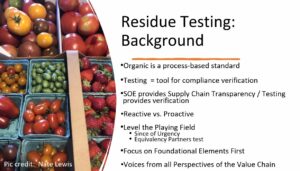
AB: We are looking at this as testing as a tool for verification. I want to acknowledge the roll out of SOE. Impactful to our community. Loved Dr. Tucker telling us about early wins for SOE, which provides supply chain transparency. Import certificates are going to be hugely helpful to understand what is coming into our country; however, testing provides verification. Twofold approach. It’s not going to be implemented immediately, but it’s going to have the next thing in the queue. We heard from the community that testing really needs to be looked at as that next piece. Also thought public comments we heard that we want a level playing field – we love competition, but let’s make sure everyone is playing by the same rules. There was also an increased sense of urgency. Important to dive into this and unpackage so that we can come up with the right proposal for the program. Wanted to focus on the building the foundation for the house. Public comment stated that pesticide screening is a valid way to test low-risk operations, but we need to look at those high-risk operations.
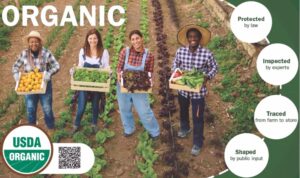
AB: Do we need a fifth pillar that says “trusted and verified”? Do we want 5 pillars to our house? Hearing from our consumers that trust and verify is important.
NL: Provide own thoughts first around SOE. Kim used ocean liner and egg beater to convey magnitude of what trying to achieve through SOE. I want to offer a different metaphor and we think SOE will shape and change organic. Moving us from map to GPS. Testing is one of satellites by which we will be tracking the course.

SOE means business and I have faith in it. So down to granular details – testing is a tool for verifying and validating systems for preventing contamination. We have a suite of guidance documents for certifiers conduction sampling. We felt it was important to take a fresh look at these and add some additional context for certfiers. NOP 2610 – sampling procedures by which suppose to collect samples – how many pounds of wheat to include in sample, how do you document chain of custody. The way we approach – have suite of guidance docs and ask questions about each one. This is brief summary of what we heard. In terms of sampling procedures – interest in more info – need more info about sampling of activities beyond commodities. Consistent sampling is needed for new types of tests – those for not pesticides. What types of tests should they be asking the laboratory for.
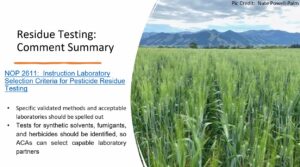
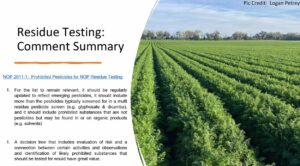
NL: Need to make sure labs are qualified and accredited to do those types of tests.
The document that I think we may see the most changes in is in the 2611-1, which is the list of prohibited pesticides for NOP residue testing. It is an incomplete list; there are a lot of pesticides that are not allowed in organic – glysophate and dicamba – we all know prohibited, but adding it to the list could be beneficial. We also got some feedback about this document being used as an evaluation of risk and decision tree. If you’re at this level, these would be the appropriate way to go. I think folks can anticipate some rethinking this guidance document.
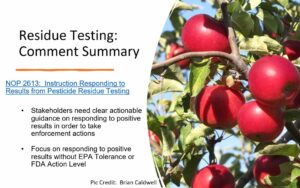
2613, which is responding to results from pesticide testing – you’ve taken a sample and it’s positive, and you need to respond to it – this is where the compliance piece really starts. What we have now, I think works really well with the multi-residue pesticide screenings works well, but it’s less clear when we start moving into things like synthetic solvents, which is equally prohibited. Detection of that is an indication that there is something happening that’s not allowed. A gap on this guidance document. We will need to work to fill that gap as certifiers are starting to receive new types of sample results.
Next steps [see slide].
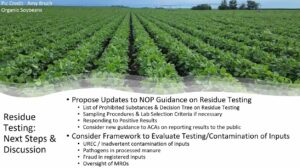
There will need to be some thought into how you get access to the information if you’re part of the public. Testing input products is also a big part. I want to make sure that CACS takes chewable mouth bites on these big topics. Oversight of MROs is also a broad accreditation topic, as well, and I want to make sure that people know we aren’t ignoring them.
AB: Hit on topics on my mind. We are a risk-based system and need to make sure we are considering new risks we’re facing. Just like to dive into that and whether integrated into these guidance documents. Want to make sure advancing these initiatives at a pace that is possible. We’ll look to segment this off.
WT: A lot of complexity, and it does concern me about all of the things that you have flagged about not making it overwhelming to get this done. I know a lot was made about the EU protocols and rejecting US products. Have you applied any learning to our process from that? It seems to me that it might be reasonable to take what is happening on that side of the pond and applying it here?
NL: My understanding on EU – no such thing as Europe – there are nation states in EU. The states are testing US products and know our weaknesses – roundup, for example. They know weaknesses and how to keep our products out of our markets. It’s really a WTO issue. They don’t want contaminated product coming to Europe and we don’t want fraudulent product coming here. That’s why we talk about synthetic solvent tests and we don’t test for it or have a framework. Organic would use expeller press. I don’t think we’re trying to start a trade war, but trying to hone in on weaknesses. I think the trade dispute is a WTO issue. How do you even take a nation state to a forum? Maybe WTO is offering us a solution.
AB: Good call out on the glyphosate. I’d like to pass to Nate PP, as he had some real specific in-depth conversations with folks from the EU.
NPP: I would take a starkly diff view on WTO – many farmers have gotten whipped by not being able to sell into EU. Why cant we sell just as much and test products coming in just as much as we are exporting? We don’t need to think about WTO, enhancing the testing we do is “just catching up.” Don’t feel there is a dispute on that.
AB: I would echo that. One thing to mention, in the SOE we do now have import certificates. That is another thing that the EU was doing. I would echo the fact that it’s more of a catch-up with some of the testing that is being done. We can look for benchmarking, but the idea is to put similar barriers to what other countries have.
BC: Basics – how do we envision the system. Who initiates the [imports] testing, who oversees, who gets the results, who pays for testing. I want that clear.
NPP: Think that’s going to be something we’re going to determine. Way we test is well-developed muscle, but not sufficient right now. Right now have 5% rule certifiers expense. Need to consider where all that burden falls. In a way, and think question here, the folks benefiting from importing into our market are the most solvent. These are not small farmers bringing goods, these are high revenue organizations. Some questions about who is most suited for it.
BC: Thanks. I wonder if Jenny might chime in on that. I kind of asked about that before, but any additional ideas would be most welcome.
JT: Mentioned on Monday we are doing more direct testing by the program based on risk based on geography and commodity. More direct testing. Certifiers also do a lot of testing, not just 5% but test to support investigations. Look at settlement agreements. Would also say that those companies Nate is referring to – many are doing own testing and they don’t want fraud on market either. We know some large buyers who diverted imports into conventional market b/c of tests they took. Not just oversight agencies that do this. These companies have brands to protect. Think we need to be careful – a lot of legitimate imports and trade. Try to be realistic, not Polyanish, but more testing going on than in the public sphere.
NL: Brian, I think your question is great. There are a number of testing programs that certifiers are not engaging in right now because of lack of guidance around them, and we are trying to fill that gap. That’s one of our audiences, but it’s also NOP. We want to make sure they know what we want them to test for.
BC: I’d say a lot of it is opaque. What’s behind my question, if a big financial burden on certifier, that gets translated to farmer, often domestic producers not a player in this whole thing. We should find ways to tap into private testing being done. Some big buyers enjoy depressing push on price so might not be motivated to find out, but some might.
JT: I will certainly not deny that there are bad actors out there. I’ve said over the years that you choose who you buy some. Some people don’t like that I say that, but I’m going to keep saying it.
NPP: Think in heaviness of all of this and what market looks like, I’m enthused about this work agenda item and confidence we can claim on behalf of consumers – that we are testing. This gives us a leg up.
KS: 3 points – 1) regarding public access. I want to point out that although it is not specified in 205.670, it is called out in 205.504(b)(5), which is administrative policies and procedures. It does require that certifiers have procedures in place to provide to the public upon request the results during the current and proceeding three calendar years. 2) Nate, when you were talking about the prohibited pesticide list 2611-1 and the fact that glyphosates aren’t on there, I do believe that most of those things are part of that multiscreen test, and glyphosate isn’t part of that multiscreen test, so I don’t know how we format that. If it was part of that, it would be great. I do not know if that is possible because of lab testing protocols. Currently, certifiers are needing to take multiple samples. The next part of that would be providing more information on types of crops, time of year when things are usually sprayed, etc., to allow us to take samples more effectively. The more samples you take, the cost increases. All things to think about. 3) Third-party testing – certifiers are unable to take enforcement currently based solely on that. It might trigger an investigation, but we cannot issue an adverse action solely based on that testing if we didn’t perform it ourselves.
NL: I can share some light on 2nd topic: the barrier to multi-residue screening is science. Suggesting labs that will bundle glyphosate with multiple-residue testing would be a benefit.
AB: When I look into this, we need to work together. Lots in value chain say we need to level playing field. Need to have open conversations on how to execute and burden free as possible. At end of day, the guidance docs were updated in 2011 and a lot we can do to provide ease and execute. Looking at pesticides is not going to always be where find fraud. Need to look at residues. Want to also highlight comment that been in our Q saying AMS has legal responsibility to make sure effective monitoring system. We have work to do to polish guidance docs to current environment. Let’s ensure all playing by same rules.
Discussion Document: Climate Induced Farming Risk and Crop Insurance
AB: Just showing this slide [slide shows tornado in Nebraska] to show the extreme weather that we are talking about. The primary tool that we’re going to be talking about is crop insurance and the desire to maximize this tool.

AB: Slide articulates some of the improvements and progress made. Fall meeting presentation from RMA was helpful, with them stating their commitment to the process, especially RMA stating their commitment to enterprise units based on organic practices.
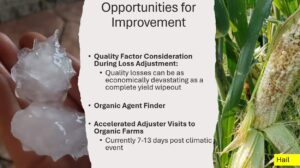
AB: Sometimes yields are above the trigger level, but due to a weather event, the crop isn’t up to quality standards. We need those metrics to be up to organic standards. As far as the agent finding, we thought it would be great to launch that just for organic agents, as well. Would love to highlight that and make it happen. Also looking to accelerate adjuster visits. We need adjusters in our field sooner so that we know what to do to mitigate the event that the climate delivered to us. 36 hours. If we enter a field too early pre-adjuster visit, we could cause some challenges. We need adjusters there sooner.
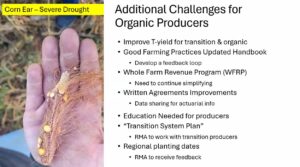
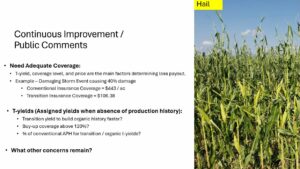
AB: Good written and oral feedback on how we can improve T-Yields. Getting good feedback on some of these; need more.
T-yield is assigned when absence of production exists. Farm on right side, if conventional, the producer would be receiving about $443/acre. If new transition producer, that insurance would be a little over $100 still employed 85% level of multi-peril production. What do we do about it? We need to build transition yields and organic yields faster. Potential compromise would be to leverage transition history and to apply to when to organic for accelerated viewpoint on production capacity. Could also allow coverage to allow producers to purchase more. What would be cost of buy-up coverage. Also talked to community about using % of conventional APH – more customized approach. Concerns about high/loss ratio. What happens is that so much diversity as to how producers executing on organic scale that need customized approach and look at their conventional production – any other byproduct. Looking at contract pricing, right now there is a ceiling based on conversion factor. At end of day, producers looking at how to satisfy adequate coverage, whether through t-yields, buy up or price expansion.
Looking for more robust action items to make coverage more equitable for organic producer. CACS will bring proposal for positive change. Call for request for challenges. Want to make sure reflecting challenges for produce growers as well. Slide 2 – quality adjustments very applicable to produce growers.
NPP: Going back to the progress part of the doc – #3 – why RMA allowing Enterprise Units by organic practice is significant?
AB: Even in current form, producers still asking about it. Education is needed to alert people it’s available. Sometimes when early in transition process you might have conventional land – parallel. When folks are deploying enterprise approach, they are aggregating all fields together. If transitional yields reduced when all aggregated together then coverage is a lot lower than if can separate out transition production. Ability for parallel production producer to get highest level on each of fields.
NPP: For example, you lots of times see farms when they transition create one LLC for the conventional farm and one for the organic farm, which is a burden, and this reduces the burden on being an organic farmer.
AB: Thanks for highlighting that workaround – not because of transparency issue. More to mitigate economic challenge.
NPP: Number 2, in progress report, Nate Lewis got me on first fly into DC. Heard farmers say why is NRCS telling us to intercrop and do progressive agronomy while RMA is saying if do it will take away coverage. We have not given enough credit – how do we get message out about that?
AB: This is huge. We had several commenters about advancement in no-till practices. That’s a real adoption practice, because we do have irrigation, and we’re able to mitigate some of the risks that some of the alternative practices might have. As organic farmers, we know that we need to keep advancing and trying new techniques for a better outcome, and having the recognition from RMA, I think that is going to come out more. If producers are coupled with agents that understand organic, I think that is going to come out more. You don’t always know what you don’t know, so having folks connected with organic agents I think is the best way to get the word out about #2.
WT: Great work here. Slam dunk pathways. Noticed the doc wasn’t entirely unanimous based on the subcommittees stance – is that a barrier to getting this done?
AB: Complex where our authority lies – similar to Allison’s document for recommendations to TOP, this is an inter-agency type approach and we need cooperation with RMS. That’s the reflection of the abstention – what is the jurisdiction for this recommendation.
NPP: I think from the work Allison has done – grey line for what we are supposed to be doing on the NOSB. What can we approve. Even if we don’t have a Sunset to address something. Can we stick to our lane or be more expansive? Team more expansive. Addressing improvement #2: Having a crop insurance agent who knows organic is the difference between getting coverage and not. I only found mine through a buddy. How to make it obvious and easy to where we look. So much need for improvement. This should be the priority for those in TOPP and organic.
CD: I abstained and basically there is philosophical differences on how doing this kind of work. As researcher, my approach my differ. Mark Lipson raised point that loss ratio is close to 2 for organic policies. Legislations that created crop insurance says it has to be one. If this doesn’t work for risk management agency, then it doesn’t work for organic farmers. If saying these are ways you need to change yet not acknowledging constraints. Didn’t get many suggestions from farmers who are not grain farmers. Concerned not representing all farmers.
NL: NPP your suggestion – replaying to your search for an agent – is there anything to search for crop insurance agents? Can we add an organic criteria in the tools used search for agents.
NPP: In some counties you will have that – like in VT – but whether or not they are any good is another question. I think that having the right people in place is so important. If you’re interested in organic, let’s train you. If you’re good at organic, let’s highlight you.
AB: There is precedence with the whole-farm agent finder. RMA website you can find one that specializes in whole-farm. Carolyn you made a good point this needs to work for all, not just RMA. There are a lot of working groups with farmer-organizations about crop insurance. Advancements need to be made. Loss-ratio: when they made the change to T-yields for organic, it did help, but it penalized producers because it was one brad stroke against whole community rather than customized response.
LP: Hesitate – don’t know a lot about crop insurance. As organic vegetable, not really well-written thing. To compare grain and vegetable I have the same issue with T-yields and how long it take to gather an average yield Rotation is important so it takes awhile to get average T yield to be good. Problem – agents don’t’ know policies really well. This discussion document does kind of conquer that for vegetable – I know those two things will be the same. Not sure about what else it doesn’t address.
AB: These 3 concepts I do believe are cross functional – they apply to produce growers, as well as row crop producers, and we did hear from one produce group that did share that the quality factor was beneficial for their work.
NPP: Building off Carolyn’s point – grain already has a boat in the water. Thinking about how augment folks already with infrastructure. When look to public comments, I was heartened when listened to tomato grower saying never even thought about crop insurance. As we think again about recruiting new board members, think about produce growers and what we can do to make it better to them.
AB: Thanks for the discussion.
Discussion Document: Organic Food System Capacity and Constraints
NPP: We’ve been hearing much from community and public commentors. How are we setting up farmers to come into market that works. When we hear folks that have been in this community for a long time there are similar themes: seed, access to land, etc. Can we get some data behind that? For example, why can’t all the grain we need coming from this country? Questions to stakeholders follow similar theme – are we able to retain existing producer? Why are people leaving? What’s stopping folks from expanding? With an opportunity like TOPP, how do we make sure we don’t miss this opportunity. Having a better and clearer understanding of what this market is and how we can expand it. That’s the basis for this discussion document.
AB: This document, along with the others, is very important. There is a lot of interconnectedness to the documents that we have presented for CACS. I want to reflect among farmer testimony in the in-person comments regarding the grain elevator that put in the infrastructure but ended up having to close it. We need to have a macro view in how to roll this out. We need to look at where challenges lie, getting the right risk management support, and then really tackling these markets. There is opportunity here, but I think it has to be more thought out rather than a scatter plot position. I think this document is hopefully going to open up those types of conversations.
NL: One element I want to share is the people element of developing markets. I understand a lot of factors that go into robust marketplace. Mentor/mentee relationship that TOPP is centering – would like to see that – lean into that. Can have all the rail cars in the world, or coffee ship convo is still awkward b/c gone organic, that’s a barrier we don’t’ see.
AJ: I encourage everyone to take a look at the Senate Ag Committee Farm Bill Framework that really applies to what we do – just announced.
NPP: I just encourage everyone to come together and engage. We need to work to get those folks that aren’t engaged to become engaged.
Handling Subcommittee (HS) -Allison Johnson, Chairperson
Proposal: Magnesium carbonate -petitioned and Proposal: Magnesium carbonate hydroxide -petitioned
KS: In the Fall there were two discussion docs separate and this round at proposal decided to combine there because they are interchangeable materials. We will take the votes separately but talk about together.
In Dec 2022 we received petition for this as anti-caking agents in chickery production. Removed in 2017 b/c determined not to be essential. As for manufacturing process, MCs are manufactured through a salt. Naturally occurring in a rock. Internationally generally allowed. Some restrictions – for example, Canada restricts to meat products. Based on allowance through equivalency arrangements, possible import using MCs are processing agent. Main environmental concern is mining as precursor to substance. There isn’t a human health concerns. Several alternatives on national list. Did ask some questions about essentiality, nanoparticles presence and alternatives, and also wondering about any impacts or challenges regarding importing or exporting of chicken products.
AJ: Bar remains high to get on the list. Hard to get a new material on the list.
KS: No comments or questions.
VOTE: Classification vote on Magnesium Carbonate – to classify as non-agricultural synthetic. Yes – 14, 1 absent; Motion passes
Motion to add magnesium carbonate only as anti-caking in chickery powder. VOTE: No: 14, 1 absent; Motion fails.
Classification Vote – as non-agricultural synthetic substance (Mg Carbonate hydroxide). VOTE: Yes: 14, 1 absent; Motion passes.
KS: Motion to add Magnesium Carbonate Hydroxide for use as anti-caking agent in chicory powder
VOTE: NO: 14, 1 absent; motion fails
Proposal: Rye pollen extracts -petitioned
CD: Petition for product that would be used as vegan sweetener syrup – alternative to honey. Petitioner could not find organic seed and wanted to use conventional seed. But the regulations allow the use of non-treated organic seed to produce organic crop. The subcommittee agreed this should not be used on the National List.
Classification Vote – to classify rye pollen extract as agricultural. VOTE: Yes: 14, 1 absent; Motion passes.
Listing Motion to add rye pollen extracts to the National List. VOTE: No: 14, 1 absent; Motion fails.
2026 Handling Sunset Reviews
Acids (Citric and Lactic)
NL: Citric Acid – [Read the basic information from the published materials.] Asked stakeholders if sunset is the appropriate time to consider a commercial availability for the substance, with mixed reviews. I think the folks in support of the concept of applying commercial availability to 605 items, perhaps sunset isn’t the right time. Perhaps there isn’t the volume or availability right now. Be cautious on how we use our sunset time and not get bogged down with annotations. We did request a limited scope TR and utilized some of the questions on yesterday’s TR template update as a pilot. It was a perfect example of how those additional questions can make our reviews more effective. It indicated that while there are forms of GMO bacteria that could create citric acid, those are all in experimental phases, and there’s no real drive to include those in the fermentation process. Helpful snapshot in the current state. Certifiers now have more information available to evaluate GMOs in citric acid.
MJ: Just wanted to express appreciation for cross-collaboration and what this substance could do to inform TR template. Working across subcommittees can help us get it right.
NL: Lactic Acid – [Read the basic information from the published materials.] Subcommittee did not have any questions to stakeholders or identify any reasons for removal from the NL.
Calcium citrate/ Potassium citrate/ Sodium citrate
CD: These 3 citrates have different purposes – generally buffering, emulsifying, flavoring, etc. In general, not that many comments, and comments that were made were largely in support of relisting. I seem to recall an OMRI comment to one of these ingredients with some reference to the TR template adjustments; just wanted to acknowledge that it existed. Wanted to bring out that OMRI had some concerns about what we proposed; I know we already voted on it.
Enzymes / Microorganisms / Yeast
JD: Want to refer to the TR to talk to all 3 of these substances. Note: these 3 substances are informed by 14 independent TRs, and then the 2023 limited-scope TR.
2023 Limited-scope TR – what we asked for: Provided updated info for the NOSB in support of the sunset review. Enzymes and yeast are both included on the NL. [Read published material and summarizes TRs.] Commentors were in support.
BC: Seems in terms of enzymes there is a long-standing precedent in organic certification/processing realm with cheese – long time there have been GMO enzymes that have been excluded for use organic cheeses. [Affirmative.]
KS: Some of the comments we got around fermentation – maybe 2-fold issue related to classification. Also some questions related to excluded methods. Written public comments – ACA best practices were submitted. Good to familiarize with. Best practices say GMO sourced-organisms are prohibited even if final product contains no GMO aspects. When does the decision-tree start – getting at classification piece. Certifiers are generally on the same page. Also important stakeholders know what’s going on.
JD: [Anecdotal story.]
Hydrogen peroxide & Peracetic acid/Peroxyacetic acid
WT: Hydrogen peroxide was discussed in livestock by Franklin – thorough presentation. This is a sanitizer in the toolkit that’s a slam dunk. As long as it is used within regulations it should not cause any issues. We heard from 13 commenters, all of which supported this across all different stakeholder entities. One certifier noted that continuing this for use provides an alternative to quats, which concerns all of us. Comfortable with the feedback we got from the community on this material.
Peracetic acid/Peroxyacetic acid: Similar story. There is a continued issue of really feeling the need from the community to understand the sanitizer issues and the viability of the materials. We are still stalled as a Board as to what those next steps should be. I would suggest that the fact that we have a 2015 & 2016 TR for these sanitizers that it might be time to look at that and be able to move the sanitizer discussion forward. The community keeps saying that there has to be a unique way to evaluate the sanitizer toolkit. 17 written comments from the same breadth of the community that we had for hydrogen peroxide with strong support for this material. Appreciate when organizations talk about very specifically about how they are using this material, I love those comments. These are important things to flag for us.
KS: Not specific to PA, but in a broader topic of sanitizers… I know that we hear from stakeholders around wanting the comprehensive review. Perhaps we could have our support staff try to get some of that information for us to help us start to frame that out on what that looks like. I’m a little unclear of “then what.” We clearly need these materials. We’ve heard that having multiple different types of sanitizers to use in a rotation is essential, but at least we could have a starting point and then figure it out from there.
Celery powder
WT: added to the list in 2007 via petition largely as a means of providing a means of curing meats, but supply of organic has not been there so material continues to be kept on the list and continues to be a source of great controversy. It has camped out on research priorities. It was heartening to hear Erin Silva talk about research that’s going to come out of those priorities. Referred to 2 million dollar grant to understand alternatives and how to get organic sources of celery powder and those that could meet consumers interest and those that don’t use artificial nitrates. Even with lack of using artificial, still producing nitrate/nitrite. We have feedback from retailers, NGOs, a coalition that by and large we have this research in motion, but say it’s got to go. I think it’s a fair point. There are users across organic community, certifiers, and organic businesses, consultants and others who have spoken in support of the material. One said 25% of their products contain this material. It’s super complicated and don’t feel great about situation we’re in. I’d like to know and in next semester want to understand piece of research and when we can expect it. If keep on list today, is it possible gone next semester.
LP: About the nitrates, if you say, you’d need to eat beets, they’re very good for you, but they have nitrates in them. But if you say, don’t eat bacon, because there’s nitrates in them. I don’t understand it all – one’s healthy and one isn’t? I heard that if you take Vitamin C with them, it helps with the conversion somehow, and I’ve read that the artificial curing powders have Vitamin C in them. Do you know if celery powder does?
WT: Would assume so, but don’t know the answer to it.
NL: Trying to assemble thoughts – First, would rather have organic celery powder than conventional celery powder. Appreciate work of Univ of Madison. Another is related to consumer choice – centering too much health impacts in our decision making. We certify alcohol, tobacco, sugar. I get uncomfortable that can label bacon as uncured. Centering this in my thought pattern, realize tangential, once we have enough organic celery powder, we won’t talk about nitrates in food anymore. I think “uncured” piece and labeling requirement is my concern.
NPP: I would standby that 606 seems like one of the least complicated pieces to our process – we need certain tools and it’s a list of opportunity. Entrepreneurs go out and make it happen. I was interested in hearing from Dr. Silva that we’re getting closer. If anyone is interested in getting this off the list, then help her. Other than that, the process is great like it is.
CD: I do not think she needs help. I think she has a great team going, she is working with industry, and I have a lot of confidence in what she’s doing. What is the barrier in requiring organic celery powder at this time?
WT: Organic supply.
CD: How do you say, “We want you to use organic,” and how do you move it to another spot now that the market is changing?
AJ: 606 materials are agricultural – with those materials we are looking if anything scary about it and is organic supply there yet.
NL: And, if you make organic bacon, you have to look for an organic celery powder first – demonstrate commercial availability.
BC: this is complete revelation to me. As a person who likes bacon and hot dogs and i was really happy i could get uncured organic versions and now finding out they are cured just with this “natural” source. Negative impacts of highly processed meats – as a consumer, wow, it is going to change my habits. With organic celery production, believe Erin talked about quality issues – high nitrate levels in harvested crop. She is trying to figure that out.
MJ: Good Earth takes a lot of pride in saying “no” to our customers, because there are times when we just cannot do something. This was one of those times when we knew there would be a bacon shortage, and I was ready for this one. We did not win this one. It was a mutiny. People wanted their bacon. I want to support the continued availability of organic bacon, because I have seen the mutiny.
AJ: When we were thinking about what materials to allow, I think about when I was working in certification and we had a lot of vitamins come in, and I thought we shouldn’t allow it, and the question became do you want that product with organic sugar in it, or should organic just not exist in that?
MJ: We were trying not to bring in a “natural” product – distinction.
AJ: Thinking about high nitrate celery, chard – does someone want to petition a synthetic. Wouldn’t know unless that’s in front of us. Great to see research agenda coming together.
NPP: If we look back at research priorities, we said that we want to see more organic pigs produced. Do we really want to say that we do not want the BEST part of the pig not be organic. A question of not letting the perfect become the enemy of good. If we see this as a catalyst to keep the organic pig market growing, I’m a fan.
AJ: if consumer worried about presence of nitrates, would be looking for label that says not there.
Calcium chloride
KS: Requested a limited scope TR. It was used in the published materials. We did have some clarifying questions and went back to the TR writers to ask additional specifics. We got that information and deemed the TR to now be sufficient, but it’s not published yet. Will be soon. Very widely used material. Limited scope TR was focused on the manufacturing process. The TR identified that there are 3 ways to produce it from 3 different sources and processes – Natural brines, reaction of calcium hydroxide with ammonium chloride (starting point of this is soda ash) and made some clarification on this, and through a reaction of hydrochloric acid with calcium carbonate. Mining is the largest environmental concern. Did ask some stakeholder questions, mostly around commercial availability. Got about a dozen comments, all in favor of relisting or did not state an opposition to relisting. Some stated that calcium chloride products currently being used are produced using nonsynthetic processes. Two commenters stated that we should investigate the presence of calcium bromine. Another said that it should be annotated to state that nonsynthetic processes are being used. This seems redundant because of where it is listed and the verifications certifiers are going through.
No comments or questions.
L-Malic acid
NL: Listed at 205 605(a) – nonsynthetic. Flavor enhancer, pH control, essential for organic wine making. Allowed by trading partners. Benign to environment and human health. Biggest area of work is around it’s classification. Right now approved as nonsynthetic. Appears most or all is perhaps a synthetic produced through 2 step fermentation process. If follow classification guidance, if start with synthetic, can’t go back to nonsynthetic. Crux of issue here and whether it should be added to 605(b) for synthetics. Alot to unpack there. We heard commentors who felt like should remove it or other variations. Don’t know what to do or have recommendation, but personally reticent to set policy related to individual. Whole discussion and role on list underscores need to spend more time on classification of fermentation products. Use a comprehensive approach to ensure consistency in classification decisions. Synthetic or non-synthetic doesn’t really enter into formula. Recognize that classifications on 605 a and b are used to justify other classification in crop production which can have dramatic impact on what’s allowed.
BC: 2 things – I’ve forgotten why the listing is as it is – is it a nonsynthetic, but nonorganic? Yes. Okay. Can we add something to the list that’s not petitioned?
NL: Originally petitioned. There is a petition to reclassify.
KS: Petition is currently with the Handling Subcommittee.
AJ: To your question, we spent a lot of time to try to figure it out, and I’m not sure that it matters whether it is synthetic or nonsynthetic. There is on shortage of odd little errors on this list, but bit-by-bit we are getting there.
Magnesium Sulfate
AJ: Third time to talk about this material at this meeting. Some impacts for mining, but TR noted not a lot of info about this. Some alternatives, but might change properties of finished product. A few comments about operations that use it – yeast nutrient. No info about alternatives.
No comments or discussion.
Perlite
KH: Important product for growing vegetables – but not intended use in this spot. Used in handling only as filter aid in food processing. Asked for updated TR, mostly around manufacturing standpoint and update. Felt like TR was sufficient. Comments came mostly from wine segment. Talked about mined products. Perlite is mined. As food technologists reviewing, there will be some perspectives. Total of very few comments. All which supported the relisting and continuation of organic wines.
No comments or discussion.
Potassium Iodide
LP: [Summarizes meeting materials] All comments in favor of relisting. One comment said it should be on synthetic list.
No comments or discussion.
Pullulan
DN: Created by microbial fermentation, a type of black fungus. No adverse effects known. Comments support –relisting. One comment asked to add and apply commercial availability clause to pullulan. Stakeholder comments, Gwendolyn Ward, noted that organic pullulan is now available but the scale is not enough to meet all the demand – but may be soon.
AJ: I put this one in the happy category of “maybe next time.” it sounds like it’s almost there, but not quite at scale.
Activated Charcoal
KH: [Reads meeting materials explaining the uses and regulatory basis.] Asked stakeholders there are any industry changes – did not receive feedback from that question. 8 total comments in support of re-listing. Some from certifiers showing a number of operations that list it for use.
Ascorbic Acid
NL: [Summarizes meeting materials]. Also known as Vitamin C. Public commenters confirmed that it is essential for organic processing and beyond that there is no rationale to consider removal from National List.
BC: Likely a lot of pressure to produce vitamin C with excluded methods. Fact that there is a strong human use for it that livestock sources of vitamin C will be preserved for human uses as well.
Collagen Gel
KH: [Summarized meeting materials.] There was discussion around the viability of marine discussions being used for collagen gel. There was a comment that due to the dark coloration and the odors to overcome, that market had not made much progress. At the time of the TR, marine sources remained largely at debate. We asked the community if there was a method of production for nonsynthetic collagen gel, and then what about organic availability? There are a handful of stakeholders that did respond that were supportive of relisting collagen gel.
NL: To put on the record, wild fish-people in Alaska are interested in providing organic collagen to the body care side of things. I think they are still struggling with the odor issue.
NPP: Kim do you have an idea of who we should reach out to for #2? Who would have that data?
KH: Organic harvesting facilities would be able to give us potential headcount. What you run into when we talk about commercial availability of body parts of animals, once the product gets to a point where the meat has been harvested in an organic fashion, the cost to retain the product in an organic fashion becomes part of the conventional production line. We need to talk about, when we talk about commercial availability, can we actually isolate that?
Nutrient Vitamins and Minerals
AJ: [Summarized meeting materials]. At end of the day, most of these nutrients have to be added to food. These are places where not a lot of room for us to say “no don’t do that.” We don’t have a lot of room to move. Asked questions about current state of things, including how they are being used. Only thing that stood out was DHA in comments. So, there are some outstanding actions that are sitting there. There was a proposed rule that would have changed the annotation to reference vitamins and minerals as essential in another section in the code and two other sections for infant formula. Interim rule published in Sept 2012 that preserved status quo. Right now we have imperfect annotation that is mostly working fine except for DHA. Board recommended adding to list, but never was. We can continue to not fix it or we could try to bring this back to life. I lean sort of testing out new annotation process to bring it back to life to get some closure. Heard from certifiers using different versions of rules and recommendations Curious to hear from you, the best options – leave it alone like in 2019, or try to bring in the annotation in proposed rule that was never finalized that essentially limits fortification to required nutrients. If did that then would want to recommend DHA added to the list so that is clear. NOP folks weigh in – DHA in database says “closed” and references interim rule. We are in limbo period but no plans to move forward.
NL: Can you describe the risks of pushing DHA forward?
AJ: We did reach some resolution but never made it in regulation. Would save future Board and bring some clarification for certifiers.
KS: Did you say that there are a bunch of comments that were – to the 2012 proposed rule – can you repeat that part?
AJ: My timing is fuzzy on this – looking back at the Board’s recitation of the history in 2109 – in 2011 when the Handling Subcommittee proposed changing annotation at sunset, they withdrew the proposal. I’m not sure how it aligns with the proposal.
KS: Apparently, something failed in the proposed rule. Otherwise, it would have made it to the final rule. So, if we’re just re-proposing the same annotation, it seems like it might have the same fate, so what’s the point. I like cleanup, and I think closure is good, but are we setting ourselves up for failure?
AJ: Things have kind of settled down and we could make sure the rule matches that, but it’s a fair risk to name.
WT: Can you remind me about what the annotation process is now? I can’t remember how it works.
KS: We would put in a parallel motion. We would have to vote in the fall to retain the listing. Simultaneously we could bring a proposal with an annotation that we could also vote on. If that didn’t make it through the rulemaking process, we would still have the listing.
NL: Another question about the timing and renewal of 2012s and the raucous times as they say. Was that before the process for sunset was clarified. Was that an element in the milieu or were we just spit balling.
AJ: NOP had a reversal interpretation that allowed certain materials and FDA said no, and I worry a little bit that there is a vulnerability for companies using materials in the gray area.
CD: Found when there is a mysterious thing, that I don’t know, ask Jenny or someone has been involved in a long time like Beyond Pesticides. Not saying they are the one. But some people can provide clarity on that.
AJ: I can commit to doing a bit more digging on the whys and what-ifs.
KS: I think we have some things to talk about in Handling. It seems unclear at the present time.
AJ: Anyone listening who has a stake in these materials, please send information our way for additional discussion in the fall.
Ferrous Sulfate
AJ: Covered under same TR/TAP of minerals. [Reviews meeting materials.] Listed individually because it has some benefit as an individual listing because you can over-supplement it.
No additional discussion.
Potassium Phosphate
LP: [Summarized meeting materials]. Comments in favor of relisting.
No additional discussion.
Sodium Acid Pyrophosphate
LP: [Summarizes meeting materials.] In organics can only be used as leavening agent. Internationally listed in CA standards but not explicitly listed in other standards. All comments were in support for re-listing.
No additional discussion.
Tocopherols
KS: [Summarizes meeting materials on the material.] Derived from vegetable oils when rosemary extracts are not suitable. Classification is challenging because of manufacturing processes, including which solvents and chemicals are used. Contamination to the environment is also based on risks from the manufacturing processes. Asked about non-synthetic tocopherols – this listing is as a synthetic. We are exploring re-classification or what that would look at. Dozen comments – most were in favor of re-listing, or at least not in opposition. It is pretty widely used. Some commenters said they don’t use rosemary bc of the flavor it imparts. Some commenters asked about availability of natural tocopherols to potentially change listing or move the listing (either 605(a) or 605(b)). There is opportunity for a petitioner to initiate an action here.
No additional discussion.
Fish oil
DN: [summarized meeting materials]. 2015 TR is available. Used in organic processing and handling to increase content of Omega-3 fatty acids. Also used in aquaculture for farmed fish. Used in feed for livestock. Produced from fish byproducts that are specifically caught for purpose of fish oil. 44 pounds to 176 pounds can be extracted per ton of fish waste. Steaming and drying process to make fish mead, then hardening to purify the oil. International acceptance – not explicitly mentioned in Codex, IFOAM, and Japan standards. No expected human health or environmental health issues. Public comments support re-listing. Asked about environmental issues – acknowledge prior NOSB recommendation and amend annotation to restrict to fishing byproducts and to fishing industries that meet third party sustainability standards. Rhode Is – did not move forward with recommendation.
KH: Want to point out the statement that says that fish oil is fed to fish because of a deficiency of plants and animals. My point is that we can feed fish oil to fish, but we cannot feed feather meal to chickens.
BC: Did you say that fish were specifically caught for fish oil or were not?
DN: Yes. That’s true.
AJ: One commentor said only byproduct.
BC: Its only what?
AJ: No fishing solely for fish oil – i think a commentor said that.
DN: yes, it is from the byproduct and specifically for purpose of making fish oil. Not all the fish they use for fish oil production, there ae certain types of fish. That’s my understanding reading the TR
AJ: We were trying to retrace the Marine Materials Recommendation this morning. If someone who was here could speak to that?
WT: I think it was crops. I am noting all of the comments that are made on it, and I do not want to be the final word on that and want a check, but I believe it was crop fertility specific. In the community, a lot of folks were confused about that and confused that nothing was done with it.
AB: Discussion in providence – it was under my substance and would be happy to share history. We meditated on and tried to elevate in crops. I’ll give you background for your future discussions in handling.
AJ: I think the long story short is that the recommendation is not moving forward, so it is still continuing to come up in comments that there are restrictions around what type of fish are available for this. We do not really have an avenue to move that with the NOP’s decision to not move that decision forward. We could always bring it back.
Gelatin
KH: [Summarizes meeting materials; for gelatin, casings, etc. In the TR.] Fish collagen is identical chemically to gelatin. Asked stakeholders if there was sufficient organic gelatin available. If we look at where gelatin is in the organic space, I think we will run up against some complications based on the use. I think we have seen it in other products where some practices require some different forms of gelatin than others. I think we are headed in the direction of this being a fairly simple relisting.
No additional discussion.
Orange pulp, dried
KS: [Summarizes meeting materials] Used as moisture retention agent and fat substitute. Noted concern related to environmental impact of conventional pesticides used to grow oranges and then used to make this dried orange powder. What products would be in jeopardy if removed. Received 8 comments. Some in favor of relisting, some opposed. Certifiers – not widely used. Didn’t really get response to question about if there is enough suitable apply. One commentor said securing segregation of organic source materials contributes to insufficient supply. Processing plants are located too far to ensure freshness. Drying process is patented – not sure if that’s playing into building closer facilities. In search OID for organic forms – challenging – some products came up if searched for orange powder. Wanted to follow-up with certifiers to see if products listed in OID are the same or different. Also if certifiers who responded following up about what types of products those are being used in and different alternatives. Tricky. Not sure about this one.
KH: Looking from an international acceptance. It’s not specifically listed except for no allowance up to 5% of organic content. Something to consider this summer.
BC: It seems like this might be a good candidate for a commercial availability annotation.
KS: It currently has one – it’s on 606. The question is should it be removed and it would force people to use organic. For future reference, when we are in the handling list, it would probably be good to remind people when we are jumping from synthetics to nonsynthetic to 606.
Seaweed, Pacific kombu and
Wakame Seaweed
DN: Mostly the same, but different in genus and species, and Wakame is a brown seaweed. [Reviewed published materials.] Public comments support relisting. Stakeholders suggested that two products be reviewed in conjunction with Marine Materials, with a decision tree used to identify harvesting areas where testing for harmful materials should be performed. We did ask what testing would need to be performed. I would like to mention that several of the countries that use these are not that the harvesting methods are performed in a sustainable way. Several commenters mentioned the prior NOSB recommendation that I mentioned in Fish Oil review, and we should be looking at the Marine Materials.
JD: A little surprised with both of these that we’ve had no indication of environmental issues. I had a seaweed a couple of years ago and this was brought up. I was surprised to see that all of the sudden there was something similar that gets a free ride on environmental impact.
DN: You’re right. If you read the TR, it says how they are hanging – these fisherman go to open ocean and hang ropes and have specialized hooks and they harvest – concern about what you just mentioned and if you read the report the harvest practices there are some environmental concerns but these companies guarantee sustainable way. One NOSB member did review the practices, Emily or Harriet maybe, they did review this proposal.
FQ: Environmental impact – seaweed they do use it for bioremediation. I worry about wherever it’s being grown what amount of pollution is there because plants take it up. When you use it as a food source – is it safe for us?
JD: You jogged my memory. It was a double-edged sword.
WT: work in fall of 2020 was related to crop fertility. Two proposals. Suggest we look at those documents that would be worth learning from and including in this discussion.
WT: work in fall of 2020 was related to crop fertility. Two proposals. Suggest we look at those documents that would be worth learning from and including in this discussion.
Deferred Votes
KS: One deferred vote we need to do before wrapping up.

Motion to change the PPM working from impugn to malign, as seen. VOTE: 14 yes, 1 absent. Motion carries.
Vote on the PPM as a whole:
Motion to accept the proposal on the PPM as amended. Motioned by KS and seconded by AB. VOTE: 14 yes, 1 absent. Motion carries.
NOSB work agendas/Materials update
See the NOP website for a full updated list of the NOSb work adgenda.
Other Business and Closing Remarks
NPP: I want to talk about livestock. We are hearing more about animal welfare. As we go into fall, thinking about work agenda item about how organic is an animal welfare standard. What does the NOSB think we can do better and come to say what we do great.
WT: Organic markets discussion document – there are so many questions and opportunities. Encourage to think about the question of: we should be able to be thinking about delivering fair wages, prices to growers and offering consumers food they can afford. We have to be able to hold those together. Appreciate hearing from growers.
NPP: We can have both. Where organic food is not a luxury item. We have been supply-oriented but would like to look at the consumer perspective too.
KH: Wood I want to echo that and I’ve had sidebar dialogue with Nate and appreciate lens from supply side and as go to fall meeting, we talk about constraints on further stream and where does that go and how do we get to where you’re talking about. We need to generate sustainable way to grow the market. Find guardrails that help to lift it sustainably.
NPP: We need to take back the word sustainability.
AB: Think this is good focus and for end of the meeting – the market piece. Appreciate bringing farmers to table. John Brunquell was a voice and we can make it happen from all sides. Encourage board to reach out to supply side. We need their info to take this document over the finish line.
LP: Back to Wood’s comment – Amy what would it take for your raw products costs consistently over time to be lower costs for consumers – how can we get demand up?
AB: Crop rotations are helpful from soil health perspective and growing own fertility and reduce need for inputs. Complimentary crop rotations and further innovation of crop rotations. Innovative deployment of different pieces of equipment – flamer, weed zapper – trying to mitigate weed escapes that would need hand labor. Those are two looking at and another plug from NRCS programs. Take up good portion of the payment. Those are some of straightforward things working on to lower costs.
NPP: I would very respectfully challenge question, Logan, to lower costs to lower consumer costs. Even at $20/bushel I represent 35 cents in that loaf and I don’t feel like I need to get more efficient. Where I need to figure it out is how do I not need to spend more on shipping, how to shrink road miles to mill, how do I seek out customers using whole flour. I think there is a certain part that producers are not the problem.
JD: Conversation has morphed in 15 min. Think we are talking about costs to produce and then money back to farm. We can have our farmers whole and feed the masses. You need conversation about subsidizing and fair share of subsidizing.
NL: Really cautious about talking about prices and competition. I’ve been trained to be overly cautious about not creating any appearance of antitrust violations. Talking about prices is a challenging thing to be doing.
CD: Worked on economics of the food system. I teach an entire class on this. Urge us: limited amount of time with important problems. Is this worth spending any time on.
AJ: Think we need to be careful about equating farm price with consumer price – there has been a lot coming out about price fixing, jacking up consumer prices without regard to farm costs. Farm piece of consumer dollar is quite small. We are learning more about retailers keeping prices expensive for consumers. We need to be talking to Congress, competition in market place, and fair playing field.
AB: This conversation is reminiscent of a subcommittee meeting of CACS. We have to scope out issues appropriately.
WT: We could debate about how spend time all day long. Just went through sunsets that are perfunctory and we spend all this time doing that. I would suggest this is more important than that part. I know we’re legally mandated to do that, but we could have that debate all day.
CD: researchers are looking into if organic farmers get larger part of the dollar. Economic research take a long time but coming down the pipeline.
KS: In person comments here for the first time in awhile. Wondered, what did people think?
AJ: In person comments made meeting fun and key for people in the region to show up in person who might not join virtually. Saw some of that but not much. We committed to in-person road without a lot of notice. I’d try it again in Portland with good strong advance notice to recruit local folks to show up in person. This time it didn’t fully achieve what we thought was the purpose.
NPP: how much earlier, what timeline?
AJ: I don’t know, but when in Rhode Island we were unsure. Not sure when we made it clear there was this in-person opportunity. Time to build out schedule could make it look different.
BC: I’m so glad we had so many farmer comments in all 3 sessions. Just having more slots allowed for that. Message that a lot of those farmers gave was loud and clear.
JD: I hadn’t thought about the notion of local v. non-local. I was lukewarm about it. I wouldn’t want to give it up again. Is there a way that we could institutionalize a time slot? I enjoyed it.
KH: On topic of regional people – I think having TOPP representation we get to talk to farmers and can expand the space to ask questions to farmers – we’re going to west coast it would be great to hear from some west coast retailers and folks who sit in seats. Farmers having ability to call in – we’ve seen the impact of having that platform and having the TOPP aspect. Let’s also add some pressure for others in organic industry.
MJ: Like the idea of having in-person comments in Spring, making it a regular cadence. I like the regionality. When was on the CA counsel we moved it around the state to get local involvement. Having people in-person helps people see what we do too. I am a more write-down processor, and I want to be able to synthesize the comments folks are making (which is harder having in-person comments).
AJ: In addition to thinking about timing, the agenda matters a lot too. Heard from grain farmers and one veg farmer who never thought about it so different content at different times might give us a few more data points.
KS: One of things I was weighing was having that space – for NOSB mental health – having that break. A lot of votes taken in the fall require turning around and voting the next day after hearing in-person public comments. Willing to give it another go, but just in the Spring might be interesting but you lose some of the regionality.
NPP: Do we have to experience something bad to know it’s not a good idea? We really like this process, we know space between hearing public comments and voting the ability to confer, digest, feel prepared. Idea of if we found a nice balance sticking with spring meeting with public comments.
JT: NOP perspective: forgotten that no one here was in Pittsburg. Think for years we had 3 day meetings with public comments. Elastic process for how many showed up to comment. A certain elasticity is Ok. Program view is pick a lane and go. I don’t like changing it up every meeting. If we are going back to the old meeting schedule, don’t debate it every time whether to change it up. All in or not.
KH: Jenny, as we’re finding the lane, what is our timeline to get there?
JT: as soon as we get home, Michelle does federal register notice b/c board likes open docket. If we can decide to go either way, we need to decide in next couple weeks
NL: personally, I like having both. I think we need to allow every possible format. Having both in the system checks a lot of boxes.
AJ: Proposal – public comments again in the Fall, see how it goes and then we commit to committing to a lane in the Fall.
KS: See you in Portland.
JT: Huge round of applause to Kyla for the beautiful job as chair. Applause for NOSB. Key dates: May 10th, public comments due on market development rulemaking. Insider went out yesterday. June 28th is the deadline for NOSB nominations. Close by saying organic is climate smart. Integrity from farm to table.
END DAY 3.

